

















































What a difference a year makes…or for that matter, five years …10 years!
Technology, as it is in BoardRoom’s September/October issue, speaks to how things have changed over the last 10 years. The introduction of the iPhone, Blackberry and other smartphones really began to have an effect on private clubs, which then faced decisions of who could use what, where and when at their clubs. Yes, some things do change.
Today, barely a day goes by that there isn’t something new and wonderful on the market…and most people are embracing the changes happily because it’s made our lives easier…it’s simplified what we do and we do it more quickly, efficiently and effectively. That, of course, is the ‘good’ side of technology.
Yes, technology in earlier days was verboten at some clubs. But the only thing constant about change is change and that certainly applies to today’s private clubs. Technology really holds the key to success for many private clubs who are seeking a new generation of members, i.e. the Millenials…the generation that’s grown up with much of the technology they (and we) carry around with us today.
Technological change today is unceasing and happening with such mind-boggling speed and depth that we can only imagine where tomorrow takes us. Just think of what’s happened in the past year?
So how do clubs prepare for the future? What to do, because digital devices are how younger club members read, listen, search and generally communicate with their families, friends and work colleagues. How do clubs accommodate the requirements of the next generation? What decisions do board of directors face? Who leads the charge?
At the same time, technical innovation is also knocking down the doors of clubs themselves, particularly in administrative and management areas. In his Technical Perspective piece this issue, Bill Boothe explains how clubs can cut costs by adopting a couple of technologies, to the advantage of the club’s members.
Boothe also suggest implementation strategies to help club members make the leap to get on board. Some clubs of course are early adopters…not so with others who need more focused arguments of why change should happen. Boothe outlines these advantages, including the fact your club can save money.
Food and beverage technology that tracks inventories from start to finish is also pushing on, and contributor Chris Boettcher outlines how marketing and technology go hand-in-hand in meeting the demands of today’s members.
The golf course also benefits from changing technology, as Bruce Williams points out in his story on technologies your club should embrace.
Water issues including usage, affordability, availability and quality are in the forefront of one of the most important issues clubs face today. This of course has led to technological innovations that measures moisture, ensuring that water is applied only when needed, and which also track irrigation performance.
Apps that help in myriad ways are also finding their way on to the golf course, as well as other parts of the operation. Clubs should embrace technology and make it part of their operations, Williams recommends.
Certainly there is an appetite for advancing technology and that’s becoming even more evident in the private club industry. The next few years, as with the last few, will be exceedingly interesting.
And finally, we continue with our series on BoardRoom magazine’s top private club presidents with stories about Gale Pinckney, Commodore, Newport Harbor Yacht Club, Balboa, CA; Brian Spiller, President, Woodfield Country Club, Boca Raton, FL; Barry Swidler, President, Old Westbury Golf & Country Club, Old Westbury, NY. BR
Got a comment?
Drop us a note: dave@boardroommag.com
Publisher/CEO
John G. Fornaro
Editor/Co-Publisher
Dave White
Associate Editor/Creative Director/Co-Publisher
Heather Arias de Cordoba
APCD Executive Director
Bill Thomas
Editorial & Marketing Director
Dee Kaplan
Account Manager
Dina Alleluia-Carr
Contact Information
www.BoardRoomMagazine.com | www.apcd.com (949) 376-8889 or (949) 365-6966
Subscriptions and Website
Heather Arias de Cordoba
www.BoardRoomMagazine.com (949) 365-6966
Featured Columnists
Lisa Carroll
Rick Coyne
Henry Delozier
John G. Fornaro
Nancy M. Levenburg
Jerry McCoy
Contributing Writers
Cindy Anderson
William Aperance
Sarah Bal
Chris Boettcher
Bill Boothe
Ronald F. Cichy
James Cobalt
Donna Coyne
Dave Doherty
Kate Donnelly
John Embree
Jim Fedigan
Susan Greene
DeEtta Jones
Kevin Reilly
John R. “Jack” Sullivan
Crystal Thomas
Terry Hackett
Larry Hirsh
Bonnie J. Knutson
David Lacey
Lynne LaFond DeLuca
Butch Lesniak
Melissa Low
Susan Lyle
Steve Mona
Rob Mulhern
Peter Nanula
Macdonald Niven
Robyn Nordin Stowell
Gregg Patterson
Frank Vain
Dave White
Frank Pitsikalis
Rachelle Reali
Ted Robinson
Bill Schwartz
Craig Smith
Rick Snellinger
Michael Sparks
Elyse Stulberg
Prasad Suryadevara
Mike Talbot
Bruce R. Williams
Donald N. Williams
Endorsements, Strategic Partners and Allied Associations










BoardRoom magazine is published by APCD Inc. 1100 S. Coast Hwy. #309 Laguna Beach, California 92691



email heather@boardroommag.com or johnf@apcd.com or visit the website at www.BoardRoomMagazine.com.





PUBLISHER’S PERSPECTIVE | 10

BY JOHN G. FORNARO
We don’t have to look very far to see and find luxury brands…brands that stand the test of time, that retain their value and while not totally immune to the vagaries of the world economies, continue to be ‘wanted’ and remain successful.
GLOBAL PERSPECTIVES| 16

BY HENRY DELOZIER
Only one in 15 golf clubs – about six percent – have a list of prospective members waiting to join, according to information recently compiled by Global Golf Advisors. If your club is among that rare breed with a line out the door, you can stop reading now. But if you’re like most, think big. In fact, think global.

HIRING AN EXECUTIVE CHEF WHO IS THE RIGHT CANDIDATE?
BY NANCY M. LEVENBURG
Eating out is one of the great pleasures in our society. It is also one of the significant benefits of belonging to a country club and the key reason social memberships are so popular.
CASE STUDY | 12

BY RICK COYNE
Totally amazing the new technology we see emerging everyday. Wrist computers, cellular, and now, glasses that will help you remember names. It’s all the stuff of comic book characters of 50 years ago. So how do you decide what ‘s right and what’s not? In my opinion, to use smart technology, you’ve got to be smart.
CLUB FACTS & FIGURES| 18

THE CLUB BUDGET - WHAT’S THAT?
BY KEVIN REILLY
Over the last seven years, clubs have been forced to cut spending back because of a decline in membership and in spending by the members that remained. Where does the money come from to address the short and long-term, as well as the capital and operational needs of a club.
BOARDROOM BASICS & BEYOND| 70


IMPROVE MEMBER EXPERIENCE BY IMPROVING YOUR EMPLOYEE EXPERIENCE
BY LISA CARROLL AND JACK SULLIVAN
We can improve member satisfaction by improving our employee experience. So the question is: Are you focused on employee satisfaction?
CRYSTAL CLEAR | 14

IT’S EVALUATION O’CLOCK BY
CRYSTAL THOMAS
Done well, evaluations should align your work force with the club’s goals and priorities. Many clubs have taken evaluations to the next level by using online performance evaluation systems that integrate technology with the metrics the club uses to assess their team members.
GETTING YOUR BOARD ON BOARD| 48

OPPORTUNITY KNOCKS ARE YOU LISTENING?
BY FRANK VAIN
This is a time of tremendous opportunity for private clubs all across the country. While clubs clearly fit the definition of a mature industry, they also fulfill one of society’s deepest emotional needs – the opportunity to connect with others.
WINNING STRATEGIES | 100

TRUSTED CONCEPTS FOR TODAY’S CLUBS BY
JERRY MCCOY
Sometimes it pays big dividends to take a look back. Mark Twain was heard to say, “Get your facts straight and then you can distort them as you please.” So we went back in the archives and pulled out five of the best ideas from the past decade.

Northstar Club Management
24-25, 78
79, 132 clubsystems Group
80-81 FOOD-TRAK
Jonas Club Software
MembersFirst
ResortSuite .
Abacus 21
Buz Software
Club Software(CSI)
ClubPay
Facility Dude
SES Lighting
Signera
TAI Club Management Software
Culinary Software
C2 Design Limited Associates
82-83
84-85
86-87
88-89
90
91
92
93
94
95
96
97
99




42-43 Chambers
Event Equipment Sales
High-End Uniforms
KECamps
Something Different Linen
Stay Prime Golf
Strahl
DEI Food Service
Dr. Ronald F. Cichy
William Aperance
104
105
106
107
108
109
111
117


Peter Nanula
Larry Hirsh
Tech Savvy
Catering By Lynne LaFond DeLuca
Cindy Anderson
Club Wellness Facilities By Robyn Nordin Stowell
Tennis Concierge Makes a Difference For the Country Club at
Doherty
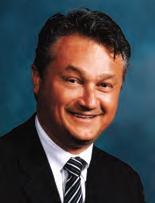
We don’t have to look very far to see and find luxury brands…brands that stand the test of time, that retain their value and while not totally immune to the vagaries of the world economies, continue to be ‘wanted’ and remain successful.
They are brands that command loyalty…a very desirable attribute.
So what is luxury lifestyle branding, why is it created, what are the benefits and what does it mean for private clubs today.
Jean-Noel Kapferer in his book, The Luxury Strategy: Break the Rule of Marketing to Build Luxury Brands, says, ”Luxury is a concept as old as humanity. Luxury is different, and a global way of understanding a customer and managing a business.”

How do you currently defend the price of your initiation fee? The board sets the price or the member sets the price, based on what? A luxury brand. Treating your club like a luxury brand will make it easier for you to defend the price, which of course, increases not only the value of the club, but also the value of the club to your members.
Luxury was invented in Europe eons ago and developed worldwide by French and Italian companies, which have become great global brands, for example, companies we know reasonably well…Ferrari, Louis Vuitton, Cartier, Gucci, Prada…
Luxury is quoted as often being visible because of the logos and brands, but luxury really never compares itself with others. In fact the brands are quite different and generally a rarity. However,
increasing demand can encroach on this rarity raising an interesting issue.
Exclusivity also defines luxury, and people want exclusivity. So how does this requirement square with the increasing demand? Exclusivity, Kapferer says means limiting the brand…a distinguishing factor between the luxury product and ‘mass’ products.
In reality we can actually look at luxury as a culture, which in the private club industry means the ‘club’ culture…with its own peculiarities, dynamics and exclusivity.
Fact is, it’s likely many private clubs just don’t know about luxury lifestyle branding…yes, a private club might be branding – with a name perhaps of a benefactor or other amenity, but it’s not luxury lifestyle branding.
So how do private clubs build a luxury lifestyle brand?
“A club’s brand is significant because it shapes how the marketplace views the club,” explained Frank Gore of Gore Golf, and chief analyst of BoardRoom’s Distinguished Clubs program.
“It can have an effect on the joining fee, retention and the club’s ability to attract new members. It is more than the traditional branding of the club’s name, logo and tag lines. It includes the clubs history, image and what makes it special.
“Clubs are a luxury and are selling an intangible luxury lifestyle to the market’s most affluent consumers and therefore should position the club accordingly,” Gore added.
“Effective branding should invoke emotion,” exclaimed George Stavros, principal with Pace Setter Technology, a firm that works at improving operations and branding experiences for private clubs.
“Emotion is one of the four Es including experience, exclusivity and engagement.
Simply put, effective branding builds loyalty. It creates a buzz. Members talk about how won-


Totally amazing the new technology we see emerging everyday.
It seems like yesterday I listened to Newt Gingrich speaking about technology in Palm Desert where he predicted that the world would see as much new technology over the next seven years as we had seen in the past 30 years. That was six years ago and he was pretty much right.
At CMAA World Conference this past year a futurist speaker likewise proclaimed that what we will see over three or four years will be groundbreaking.
With Google’s glasses I’m a believer. Google Glass is a type of wearable technology with an optical head-mounted display (OHMD) that will allow ‘old’ guys like me to remember everyone’s name as the glasses search the database to match the display with the saved name.

Technology is a good thing, but not if it diverts our attention from what is essential to growth, retention, usage and satisfaction....Seek to understand, have the courage to change and embrace the technology that can get you where you need to go. It’s all at our fingertips.
Wrist computers, cellular, and now, glasses that will help you remember names. It’s all the stuff of comic book characters of 50 years ago.
So how do you decide what ‘s right and what’s not? In my opinion, to use smart technology, you’ve got to be smart.
New technology touches many areas, but in order for it to better serve you, shouldn’t it make your life easier. Does it save you time? Does it make you more efficient? In business, these questions are even more critical.
Often times, particularly related to business, new technology ends up being more reports to read, more work and less time to really spend quality time with staff and members. Part of the
problem for many club professionals, is the “glass is already filled” and adding more often decreases efficiency.
In the club business, we exist because we are capable of doing several basic things:
1. Membership growth must at least stay in pace with attrition
2. Controllable reasons for attrition should be mitigated
3. Usage should be robust and enjoyable
4. Satisfaction should be at very high levels (it will be if you are doing the other three things).
So, whether its technology, allocation of assets or more cultural subordination to member’s wants and needs that your club needs to ensure long range sustainability, build that need on delivering on these four ideals.
Build yourself a checklist of what’s necessary to deliver in these areas. Here’s a quick overview.
Membership growth – Membership is every bit the science as agronomy and the culinary arts. What tools or technology are you employing in this most important area? Do you know the depth of your market? People’s ages and their ability to afford membership? Their interest in what you offer? It’s part of the science of marketing and the technology exists.
Do you have a CRM system in place to track prospective members and get the team engaged? Do you have the appropriate web and media presence?
Attrition – This is controllable except for health, moving away and death. Attrition rates for golf should be in the six to eight percent range, and for city clubs and social memberships a bit higher. If you are offering what is relevant to your members, communicating well and delivering the kinds of events that get them engaged, you will positively affect controllable reasons for attrition. Technology exists to track and index member’s usage.
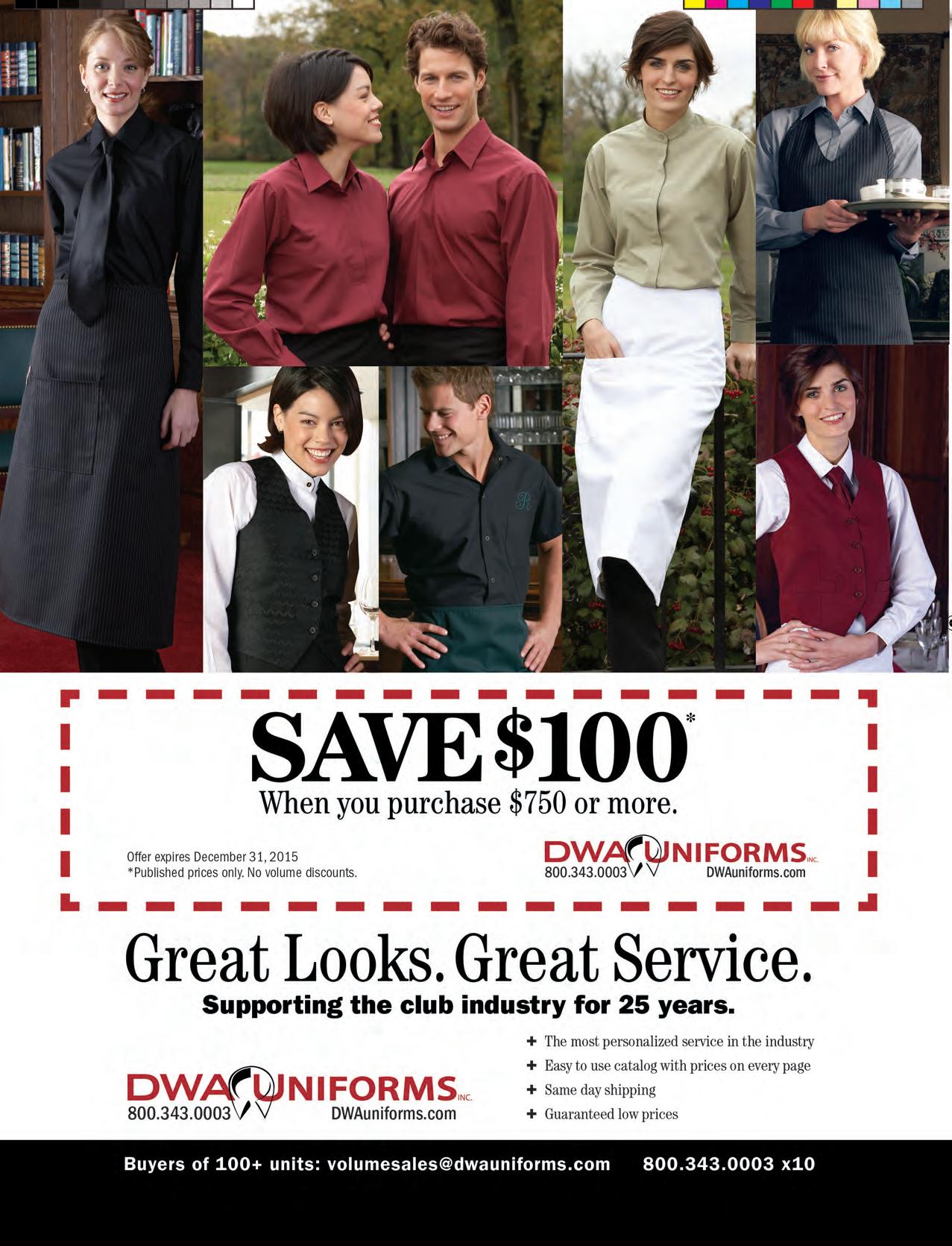

Done well, evaluations should align your work force with the club’s goals and priorities.
Many clubs have taken evaluations to the next level by using online performance evaluation systems that integrate technology with the metrics the club uses to assess their team members.
Some of these online systems contain features that help an organization define its culture and tailor its evaluation criteria accordingly. Many of these also facilitate making evaluation an ongoing process rather than a once-a-year scramble. Among other things, an online evaluation system can:
• Allow you to make notations about team member performance in real time
• Provide support with documentation, should a litigation situation arise
• Send out reminders to key personnel for timely evaluations.
So now you have learned how to use your software and are ready to take your team to new levels of alignment with your club’s goals in order to provide optimum member experience. But, though you think you are ready to forge ahead, you may not have answered one crucial question: Do you know what your values are?
Perhaps you have not equated your goals and priorities with actual values. But you can be sure they are there – your goals and priorities reflect them. Take the time to brainstorm them with your board and your team, and write them down.
Make sure everyone knows what these values are. You want your employees to accept the values of the club as their own. Which leads to the next question: Do you hire to your values?
Understanding your values as an organization will allow you to hone in on the criteria that are crucial for your team members to be able to internalize. It is very important to evaluate your team on their job performance, but doing so in the context of the values their work represents will allow you to additionally
assess the quality of their training and their commitment. Thus the final question is: Do you evaluate to your values?
Evaluating your team members on their ability to convey the values you have established is just as important as assessing their performance and, in fact, is the context for their performance.
One way to do this is to use an online evaluation system that allows you to customize your evaluation criteria to support the club’s values, which in turn support the club’s culture.
Jenelle Ebisu, general manager of the University of Washington Club in Seattle, expressed her satisfaction with their online evaluation system, The Clear Solution. “We had a retreat and updated our club values,” she said recently.
“With the online system we have we were able to change our evaluation criteria to reflect the changes.” Jenelle is using technology to get club values across to her team and help them express these values in their work, via online evaluations.
Providing the ultimate member experience means going beyond evaluating job performance. Using technology to add the club’s values into the assessment mix brings another dimension to your club’s culture, resulting in a team that knows, understands and uses the values of the club in their day-to-day decision making and interactions with club members.
After all, this is the driving force behind your club’s success. BR
As the principal of Crystal Clear Concepts, Crystal Thomas, MCM, CHE is an in-demand club solutions expert, specializing in leadership training and performance evaluation systems. Crystal Clear Concepts, Inc. has developed exceptional management system products and services that help private clubs grow and thrive. For more information contact Crystal at crystal@crystalclearconcepts.net or by phone at (818) 237-5398.


Only one in 15 golf clubs – about six percent –have a list of prospective members waiting to join, according to information recently compiled by Global Golf Advisors.
That leaves the other 94 percent – roughly 4,100 clubs in North America – seeking new members.
If your club is among that rare breed with a line out the door, you can stop reading now. But if you’re like most, think big. In fact, think global.
While it’s true that your next member is more than likely living within a 10 or 15-mile radius of your club, you shouldn’t overlook those prospects several thousand miles away either. International members represent incremental revenue and often provide an entrée to clubs in desirable destinations to current members.
What’s more, many international business travelers consider U.S. club membership inexpensive compared to clubs back home.
“International travel into North America represents a steady flow of business and professional travelers, many of whom are qualified for membership in most private clubs,” says Rob Hill, a GGA partner overseeing Europe, Middle East and Asia. “The opportunity for strategic alliances between clubs for international memberships is growing.”
But how do you recruit international members?” The easy answer? Not the same ways that you recruit local members.
Begin with a geography refresher to know where your best prospects live. Worldwide there are more than 11,000 club members originating from more than 700 facilities overseas. This segment represents valuable growth for clubs that recruit international members.
The largest source-of-origin markets for clubs on the U.S. East Coast are (in alphabetical order): Austria, England, Germany, Sweden, and Switzerland. On the West Coast, most prospective international members originate from markets in China, Japan and Korea.
Business travelers to the U.S. are attracted to clubs that are near where they work and offer business development and entertainment
opportunities. The brand authority of your club matters a great deal to curious international members.
It is advisable to review your website, which is the first point of contact for many future international members. See that your brand messages communicate upscale services, conditions and interesting events. Status matters a great deal to this market segment.
Potential international members want three other things:
• A simple international membership plan that clearly spells out privileges and obligations
• Simple financial terms
• Personal attention. Clubs should designate a primary point of contact, such as the membership director or assistant manager, so the prospective member feels a personal connection to the club and can easily make plans with clients and guests.
Many clubs with successful international memberships also have staff members who speak multiple languages and provide access to translation and other business services, as well as lodging.
The most logical markets for international memberships are point-of-entry locations and business and airline hubs such as Atlanta, Boston, Charlotte, Chicago, Detroit, Las Vegas, Los Angeles, Miami, Minneapolis, Orlando, Philadelphia, New York, Seattle and Washington D.C.
In addition, there are some markets that may surprise. For example, demand from Western Europe is substantial in markets such as Tampa, Sarasota and Naples, which are served by direct flights from Austria and Germany.
Canadian demand for international memberships has proven reliable in Arizona, California and Florida from Montreal, Toronto and Vancouver.
How should a club recruit international members?
• Expand the club’s market reach through social media, personal contacts and content marketing. A consistent presence on social media ele-
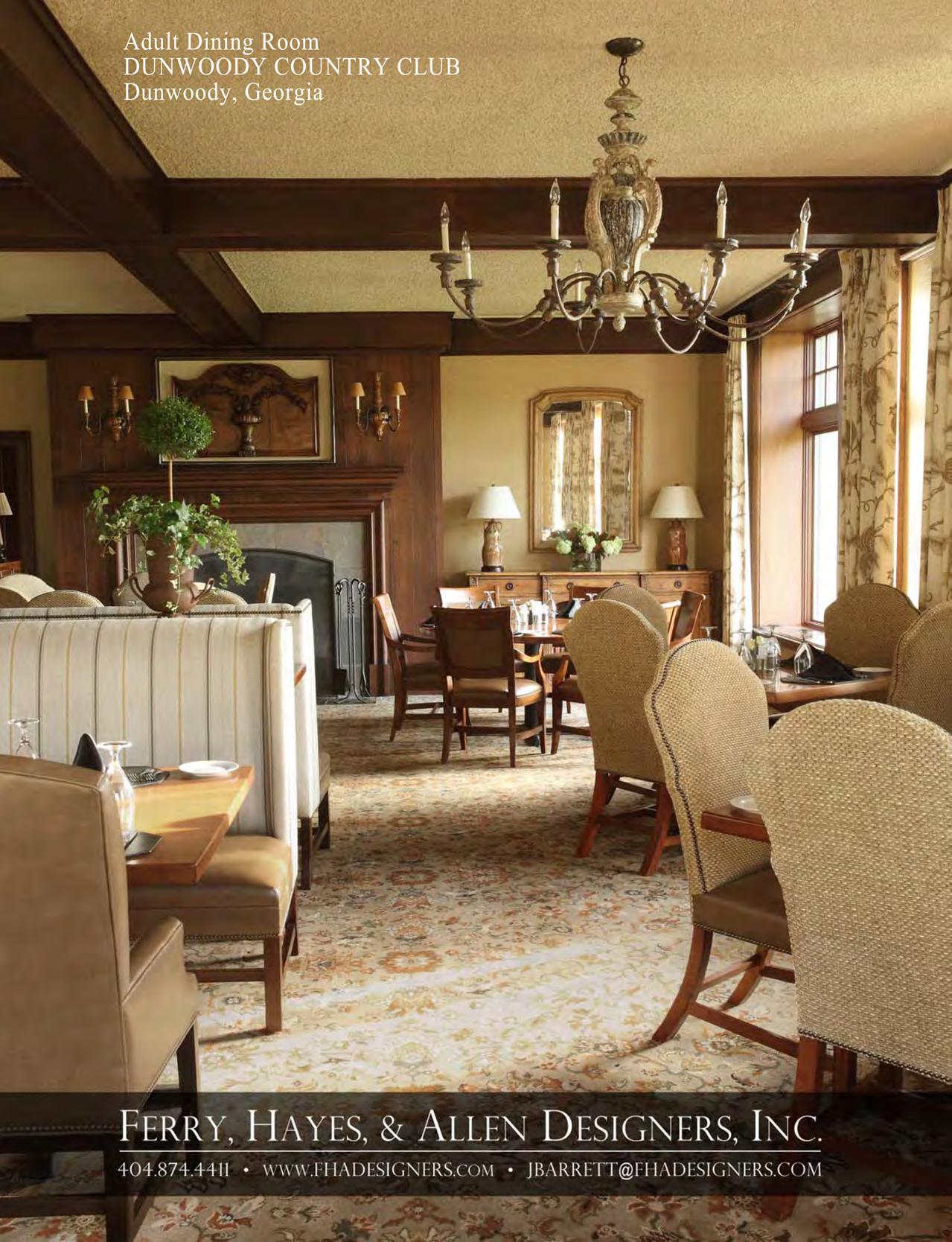

Never base your budget requests on realistic assumptions, as this could lead to a decrease in your funding.
Scott Adams, Dilbert
The budget is not just a collection of numbers, but an expression of our values and aspirations.
Jacob Lew
Balanced budget requirements seem more likely to produce accounting ingenuity than genuinely balanced budgets.
Thomas Sowell
A budget is telling your money where to go instead of wondering where it went.
Dave Ramsey
Over the last seven years, clubs have been forced to cut spending back because of a decline in membership and in spending by the members that remained.
Membership desires have been postponed but not eliminated. The members want a new swimming pool, the grill needs some new furniture, the golf course needs a new irrigation system, and the tennis courts need to be resurfaced.
In addition, utility costs are rising, real estate taxes have increased because localities need more money, and while wages had been under control, the lowering of the unemployment rate and the new minimum wage in many parts of the country, as well as other skyrocketing employee costs have added additional stress on the operations of the club.
Needed repairs and maintenance have been deferred for several years under a “fix only if broken” policy. Finally, the club down the street is going through a renovation. Oh, by the way, the members do not want a dues increase to pay for needed improvements!
Where does the money come from to address the short and long-term, as well as the capital
and operational needs of a club? Too often, members will forget that a club has a business as well as a social side to its operations.
The members want improvements and the club spends the money. The economy over the last 10 years has caused management to focus on the business side and often the members are not happy.
Generally, expenses are under control but revenue per member is still below its peak. Clubs must learn to manage members’ expectations. Unfortunately, the days of assessing a member for any shortfall at the end of the year are a distant memory.
What many members may forget is that ultimately, no matter how funded, they end up paying for the club and its operations. While the federal government cannot pass a realistic budget, but can still spend money (the 2016 budget has a projected deficit of $500 billion), a club does not have the option of spending more than it takes in, at least over the long haul.
The financial health of the club cannot be ensured without a detailed knowledge of the costs and revenues involved. The financial software that is prevalent in the industry can provide more detailed information than ever before (and maybe more than we want).
Information overload is a real possibility but in today’s environment, it is critical to have and use the tools available. One tool to assist management is through the establishment and use of a budget. An effective budget process is critical to projecting and monitoring operations. It is as necessary to a club as it is to a Fortune 500 company. For many, it can mean the difference between financial stability and failure.
No one budget process is right for every club. The process should be structured to meet the needs of the club. However, some general rules apply. Effective planning requires both a long and a short-term outlook. Finding cash for the next payroll is as critical as financing the next renovation.
Long term planning entails setting the club objectives and is part of an overall strategic
plan. Short term planning involves cash flow and ensuring revenue is sufficient to operate the club on a daily basis at a level the members want and for which they are willing to pay. This is not always the same thing.
Most, if not all clubs, have a budgeting process. However, it is important to review the established procedures to ensure that the needs of the club are still being met. A process established even last year, never mind 10 years ago, may need to be changed.
While it is important to compare budgets from year to year, it is more important to realize that the budget is only a tool to more efficiently operate the club. As more tools become available, the process may be able to be streamlined. In developing the budget, the board of directors must set the long and short-term goals and it must sign off on any final budget.
A club frequently will have many more people involved in the budget process than will a regular business. To be effective, the group must be as small as possible. The board of directors, finance committee, (budget subcommittee), the department heads, and the general manager should be involved.
The budget is a reflection of the business and operational plan. As such, while the members (through the board) should give the direction of the budget, the operational input should come from professional management. The controller and the club manager, who are ultimately responsible for coordinating the process, assist the budget committee.
Teamwork is essential. Department heads must take ownership and estimate income and expenses by carefully weighing past performance and recognizing current trends. A “guesstimate” is not acceptable.
No quicker way exists for the management team to lose creditability than not being able to justify the numbers in the budget with hard data. The next step is to determine the expense estimates for all non-revenue departments under management’s control and responsibility.
While the historical cost from prior years is usually the base point, a fresh eye should be given each year to determine if any of the expenses can be reduced or eliminated entirely, or whether certain expenses incurred are for the benefit of only a few members.
Once the preliminary departmental budgets are complete and approved by the manager, the controller should combine all the information for use by the budget committee. This must be a realistic plan containing a monthly estimate of revenue by department, planned cost and expense ratios, and an expected profit or loss realization from each department.
Once the operating budget is approved, the capital improvement projects needed for the period must be included. Although many clubs have a separate long-term budget for capital improvements, the cost expected to be
incurred in the short-term should be rolled into the master budget.
As a final step, management should recommend projects that can reduce cost, expenses or improve efficiency. The budget committee forecasts the anticipated dues revenue for the year and, if appropriate, recommends an increase in dues to balance the budget. Without a detailed budget, dues increases often are difficult to justify.
The master budget is submitted to the board for approval or revision. If the budget process is followed and all excess costs and revenue are considered, the board must realize that if it cuts the budget, the level of service the members can expect will be impacted.
No quicker way exists for the management team to lose creditability than not being able to justify the numbers in the budget with hard data. The next step is to determine the expense estimates for all non-revenue departments under management’s control and responsibility.

Once approved, the whole team must buy into the budget. The board must give its support, management must do its best to implement and the club cannot allow members or committees to by-pass the process and commit the club to expenses that have not been approved.
As with any business, the effectiveness of the budget process depends on the people involved. Variances, either positive or negative should be reviewed and an explanation sought. A failure to follow-up and to hold people accountable makes it a useless exercise. The budget should act as a measuring stick for month-to-month operations. It is an aid to enable the board and management to evaluate the financial direction of the club and the effectiveness of the club in meeting the needs and desires of its members and to make adjustments as necessary. BR
Kevin F. Reilly, an attorney and CPA, has been involved in the hospitality area and clubs in particular, for more than 30 years. He is a member of the firm of PBMares, LLP. Mr. Reilly is located in the Fairfax, VA office. He may be reached at 703 385-8809 or by email at kreilly@pbmares.com.
BY DAVE WHITE, EDITOR

“What gets measured, gets improved!” That’s a longstanding message of Peter Drucker, the Austrianborn, but long time American management guru.
And that’s the foundation for BoardRoom’s Distinguished Clubs latest innovation.
The need to better establish member usage patterns by location or amenity, the need for a more efficient member name recognition system and timely member feedback has surfaced as a recurring theme during the more than 200 onsite club surveys that have been completed for BoardRoom’s Distinguished Clubs program.

“General managers and department heads continually have been asking if there is a way to capture information about club members that allows the club and its staff to respond in a timely manner to members’ wants and needs,” explained Keith Jarrett, president of BoardRoom’s Distinguished
“It became clear that we needed a more efficient way to shorten the time period for receiving information, including digital feedback from members, along with more detailed information.”
“It’s vitally important for clubs to think of today’s and tomorrow’s member, but it’s also important to think how board members want to receive information, “ Jarrett injected. “It’s our contention they want
reports, policy changes, new enhanced Member Experience ideas based on data and confirmable metrics like they see in their professional life.”
So BoardRoom’s Distinguished Clubs thinkers have come up with the answer… the ClubIQ Plus with beacon technology!
Not only are members provided with up-to-date information about what’s happening where, at their club, the beacon technology gives the club’s board of directors and management vital information about what the club’s members want and need, and measures, in real time, each department’s Member Experience performance indicators. This, in turn, really gives a true value of their membership.
It’s all accomplished through the Distinguished Clubs’ patent pending beacon technology. Timely experience feedback from members in each department allows numerous reports to be generated, and that, of course, ties in with departmental financial key performance indicators.
With beacon technology, staff and management know where members are and what areas of the club they are using and gives timely feedback by reporting members’ location and experience. This information is instantly measured to generate different types of actionable reports specific to each department.
This information enables a club’s general manager to manage the club’s revenues and expenses and better understand their relationship to the level of service and amenities the club offers –now and in the future. The information can also help predict the impact of financial strategies on club’s Member Experience .
Staff members identifying and addressing individual members by name as they move about the club spaces remains a very important aspect of a private club. ClubIQ Plus achieves this by providing a picture and name identifying members when they enter each department so that staff can confidently and correctly address members.
A benefit of this also is that members do not have to sign into a department or sign a chit to be considered using the club. Additionally, management will know member usage patterns in real time via location and department.
changing world of technology, but the magic for the Distinguished Clubs comes from the patent pending programming.
Vincent Vu who has worked on designing major applications for DirecTV and Verizon played a major role in developing this program for BoardRoom Distinguished Clubs.
“We were thrilled to see such a perfect use application for beacon hardware technology, “Vu explained. “Our proprietary and patent pending programming will allow clubs to exponentially enhance their delivery of Member Experience in ways the clubs never knew were possible.”
monitor and reward department heads and their staff.”
Beacons as small indoor positioning devices, using low energy Bluetooth technology, connect to smartphones. Once connected a beacon can trigger a response in a smartphone app, allowing it, among others things, to pinpoint locations and push notifications or messages. In the case of Distinguished Clubs, messages to members are they move around the club.
Typically a club will likely have between five to 50 beacons, depending on the size of the club and number of departments, placed around the

Members also can receive timely promotions and notifications for specific amenities or offerings based on their location in the club. For example, club members arriving at lunchtime might receive a notice about the luncheon specials being served in the Grill Room.
So how does the ClubIQ Plus technology work? A beacon is a wireless, location based piece of hardware that runs on a battery, doesn’t need WiFi and connects via Bluetooth technology.
The beacons themselves are an innovative package in the ever-

This of course, coupled with how the clubs use their additional information they gather, is a key component of the program.
“It’s one thing to attain information from members using Beacon technology, but it’s quite another to take it to the next level by integrating a club’s cost and revenue key performance indicators with ClubIQ Plus,” intoned Jeff Briggs, Distinguished Club’s director of technology, design and communications.
“We’ve built the ultimate metrics technology to measure Member Experience which can be used to
club, giving timely, location-based member feedback never before possible. The cost to implement and maintain ClubIQ Plus is entirely dependent upon the number of beacons a club requires based on the club’s size and information strategy.
Yes, it’s as Peter Drucker suggested, “If you want something new, you have to stop doing something old.”
That’s the name of the game for BoardRoom’s Distinguished Clubs –ClubIQ Plus offers an informative and innovative and valuable solution for improving a club’s Member Experience. BR

One reason club managers investigate tackling a golf course remodeling project is in response to questions about how technology is affecting the course.
Should we add back tees? Should we tinker with the strategy? Whenever these questions come up, they’re often closely followed by, “Should we contact a golf course architect?”
Navigating the permitting process, communicating with club leadership, budgeting for course improvements and more…are all issues within the scope of a golf course architect’s expertise. Knowing when to call a golf architect can help a project run smoothly and will often save money.
Here are some particular areas in which working with a golf course architect may benefit your club:
Master planning: This is more than just a visual plan of potential improvements. Equally important are the written details of budgets, costs, phasing considerations and impacts to the course. Impacts can include better course conditioning, strategy, playability, safety and pace of play.
When should a club official call a golf course architect?
•To prepare long-range master plans
•To help schedule course and grounds improvement projects
•To prepare budgets for upcoming projects
•To communicate with club leaders and help them plan for successful course projects
•To discuss golf course management priorities
•To secure permits for proposed projects
•To help clubs make better informed decisions
Master planning provides a roadmap for a course or club and typically includes:
• Prioritizing goals and objectives
• Visual master plan of areas of improvement
• Phasing recommendations
• Optional approaches
• Probable costs.
Golf course architects have the diverse knowledge and experience to help you make decisions so your plan will be cost effective and yield the desired results.
Life cycle planning: This is a way to demonstrate quantitatively the need for renovation. Life cycle planning keeps track of the age of golf course components – irrigation systems to bunker sand – in order to continue to provide quality conditions before the signs of wear and tear affect a course’s playability and reputation. Having an objective timetable for component replacement avoids unforeseen downtime and the subsequent scramble to recondition.
Permitting: Obtaining permits for a course or major renovation can be expensive and time-consuming. Architects can help identify sensitive areas such as wetlands and nesting areas that may require consultation with various local, state and federal bodies. They can also help anticipate the impact the new EPA Clean Water Act rule may have on renovation plans.
Ecologically sensitive areas can often be incorporated into a layout’s design. Involving a golf course architect when obtaining environmental approvals may allow for more effective use of the land and minimize public relations pitfalls.
Each golf course has its own unique set of issues – ones that vary based upon site characteristics, climate, playing conditions and a host of other factors. Having these issues identified and addressed by a qualified golf course architect in the initial stages of planning and design often leads to a more streamlined remodeling process.
Financing/budgeting: Clubs have more success with proposed projects if they conduct the appropriate research and planning needed to assess risk, market conditions and opportunities.
Golf course architects can provide insight into the financial development of a course and are experienced in working with highly specialized consultants who can help clubs make better-informed decisions.
Architects have experience determining approximate cost ranges for particular course elements and can adjust them according to the specific characteristics of the property.
Because reliance on “average cost” figures can be misleading, consulting an architect to assist in determining construction costs can be useful. An architect has the experience to gauge how much a project will cost quite early in the design process, and will do a careful analysis to isolate unique factors that could affect the budget.
A seasoned architect can tell you what to expect for the amount of money available.




A Dream Team. We have all heard about one. The U.S. basketball team that won the gold medal at the 1992 Olympics in Barcelona was originally given the name.
With the likes of Larry Bird, Michael Jordan, Ervin Johnson, and Charles Barkley, the team dominated all opponents by an average of 44 points a game. Many have called this group of professional NBA stars the greatest sports team every put together. The team’s coach, Chuck Daily, quipped that, “It was like Elvis and the Beatles put together.”
Then there was the 1980 U.S. Olympic Hockey Team. It seems everyone knows the story of how Herb Brooks coached an improbable group of amateur collegiate skaters to do what was thought to be an impossible feat in hockey –defeating the Soviet Union national team in a medal-round in Lake Placid, New York.
Team USA then went on to win the gold medal. The catchphrase, Miracle on Ice, grew out of commentator Al Michaels’ famous question, “Do you believe in miracles?” In 1999, Sports Illustrated called this “Miracle on Ice” the Top Sports Moment of the 20th Century.
But dream teams go beyond athletics. Take, for example, O.J. Simpson’s bevy of lawyers, comprised of high-powered attorneys Robert Schapiro, Johnnie Cochran, F. Lee Bailey, Alan Dershowitz, and Robert Kardashian among others. Then there is the fictional group of heroes in the Marvel Comics MC2 universe, in which Shannon Carter leads Bluestreak, Crimson Cruise and Freebooters to fight against evil throughout the world. Both are dream teams in their respective fields.
Four essential things have to happen to be called a dream team. First, the team has to have an opponent. It has to have an uphill battle against someone or something. There has to be, for lack of a better term, a war. Second, the team has to be seen, at least by some, as the good guys fighting evil. Third, they have to work well together. And fourth, of course, the team
has to win. This quartet is clearly evident in these three illustrations – sports, legal, and comic book. But what about business? What about clubs? What about marketing? It’s often been said that marketing is a battle that is fought in the mind.
Karl von Clausewitz, a great Prussian general, in 1832, wrote a book outlining the principles that guide a successful war. One hundred and fifty years later, two advertising executives, Al Ries and Jack Trout, incorporated his principles into a revolutionary approach to marketing called Marketing Warfare
Today, the notion of marketing warfare has exploded into our business vocabulary. In fact, I recently Googled (yes, the noun has become a verb) the term “marketing warfare” and got more than two million hits.
From time in memoriam, it seems as if brands have challenged their rivals across myriad advertising media. TV commercials, magazine ads, billboards, product placement, ad infinitum, have all been the scenes of marketing battles. But just when we think that there are no more new battlefields, along comes digital media, and all of a sudden, brands need a marketing unit with a different set of battle skills. They need a Digital Dream Team
Virtually every club is involved in digital marketing is some shape of form. If it is done well, it can increase inquiries, likes, click-throughs, and more importantly, engage members, thereby increasing revenues. And it can reduce marketing costs.
But this is still a relatively new communication channel for clubs so the road to victory can be filled with hazards. Every club needs the right people to steer clear of these perils. It needs the right team. So who should make up your club’s “digital dream team?” Any team needs a strong bench, but to be a dream team, it needs a strong starting roster.
Chief digital officer: The chief digital officer (CDO) is a relatively new position in the CSuite stable of corporate leaders. Like any
leader, they have to see the big picture and have longterm view of what is going on in the brand’s business world. And, to some degree, the CDO needs to possess some of the traits of a “chief disruption officer”, because their primary task is to drive revenues and growth in an era that is being compelled by social media and mobile applications.
In other words, this new member of the C-Suite has the transformational responsibility to integrate new media messaging into the brand’s old media platforms. The responsibility for your member’s entire digital experience –across every touch point – with the club stops at this executive’s desk. The CDO, then, has to be the chief cook-andbottle washer, the lead sled dog and the champion of your club’s digital media platform. The success of your club’s efforts comes back to the old mantra that the coach makes the difference
Digital analyst (DA): If you can’t measure it, you can’t manage it. This truism has been a foundation of the club business – in fact, all business – from time in memoriam.
Memberships, rounds of golf, food and beverage sales among others, are essential hallmarks of where your club is and where it stands relative to its goals. Enter analytics. Analytics is simply the process that captures, processes, and examines data and measures it against your objectives.
Understanding the impact of your online marketing efforts require someone who is expressly skilled in finding and tracking the online engagement and impact of members. The free Google Analytics tool is the foundation for most digital analysts, but the DA on your digital team needs to be committed to finding and using additional analytical tools at both a macro and micro level.
Message Maker: This person is sometimes called a content strategist. What to say, to whom, and when to say it is a horse of a different color between traditional media and digital media.
Having someone on your dream team that understands algorithms and can translate them into your club’s online message is critical. For example, Google’s algorithm now over-weights mobile devices and recently issued an update that states: “…we will be expanding our use of mobilefriendliness as a ranking signal. This change will affect mobile searches in all languages worldwide and will have a significant impact in our search results. Consequently, users will find it easier to get relevant, high quality search results that are optimized for their devices.”
Having someone on board that understands when and where members want to be connected to your club impacts your online message and is essential to getting the biggest bang for your digital buck.
Engagement Strategist (ES): Sometimes called a social media strategist or a community manager, this team mem-
ber needs to recognize the fact that social media is not online marketing; it is a part of online marketing.
The ES needs to know more than how to set up a Facebook page or send a Tweet to club members. They need to appreciate each social network’s voice – i.e. how Pinterest differs from Facebook, which differs from LinkedIn.
In other words, who is on that network, what they are saying, when, where and why means that they work closely with the digital data cruncher and the message maker. Your engagement strategist also needs to be a great conversationalist because social media is your club’s strongest engagement tool.
Whereas online tools, such as your website, is more of a one-way conversation, social media is, by definition, an effective multi-directional exchange among your members and your club. It isn’t called “social” for nothing.
Graphics Designer: With digital marketing, the old axiom that one picture is worth a thousand words is truer than ever. Just look at the impact of YouTube: 300 hours of video are uploaded every minute, four billion video views per day and more than a million advertisers use Google ad platforms.
What about a site like Pinterest: 70 million users reaching 47.1 million U.S. users, half a million businesses have accounts, and 67 percent of content pinned is from a business website.
Then there is Instagram with 150 million users spending more than four hours a month on the site. Interestingly, 93 percent of prestige brands post an average five to six times a week on this site. Given this glimpse of the social media landscape, it is any wonder why your club’s dream team needs a strong graphic designer?
Finding a digital dream team isn’t easy. But the effort it takes is well worth it. Ask Herb Brooks or Chuck Daley. And realistically, your club may not need or be able to afford five in your starting line-up.
The only sure thing is that you do need the right people that have the right skills and know how to play together to win the digital marketing game. As the great Babe Ruth said, “The way a team plays as a whole determines its success…but if they don’t play together, the club won’t be worth a dime.”
Your bottom line will thank you! BR
Bonnie J. Knutson Ph.D. is a people watcher. A professor in The School of Hospitality Business, Broad College of Business, Michigan State University, Dr. Knutson is a member of the Country Club of Lansing and the Michigan Athletic Club. She can be reached via e-mail: drbonnie@msu.edu

When was the last time you remember bringing your absolute ’A’ game to your work, decisions and relationships?
It’s likely that your memories are either too distant or too infrequent to feel satisfying. Given the rapidly changing environments within which we live and work, “overwhelmed” and “stretched too thin” are common sentiments.
The irony is that during a time when most are desperately in pursuit of creativity, innovation and emotionally intelligent leadership, there is a simultaneous pushing of our employees and ourselves to exhaustion – depletion of the very resources most needed.
Focus management is a new way of approaching work and time allowing for more efficient allocation of resources and strategic outcomes. It begins with investment in self, first, to rejuvenate the body and mind.
Strategic leaders are typically more attuned to themselves holistically. They care about wellness, take longer or more regular vacations, find ways to unwind doing something that is joyful, and have diverse interests and relationships.
Understand the vision: Focus management begins with a clear understanding of the vision: Where are you trying to go? Where are you trying to take your team? Your organization?
A vision is a vivid and compelling end state…an aspired-for destination. A compelling vision is one that is so enticing that you cannot help but act in a way that brings it into being. It is powerful enough to stimulate energy that makes you literally jump out of bed in the morning, or stay up all night, or do whatever it takes to make it become reality.
In the absence of a compelling vision, people tend to focus primarily on fear – the “what ifs” associated with not having a clear sense of the future. It’s important to remember that humans are wired to have emotional responses. Emotions that focus on fear are able to cause distress. Emotions that focus on vision are able to stimulate eustress, a creative energy…beneficial stress.
Establish creative tension: The work of leaders is to maximize the opportunity for eustress in
the workplace, done by keeping the vision firmly in focus and fleshing out the path to the vision through strategic planning and use of other analytical frameworks.
Put it into practice: As an example of how to begin this shift in focus, make a list of 10 things you do at work on a weekly basis that you think make the biggest contribution to: 1) the strategic goals of your organization 2) your colleagues and 3) your clients.
Next, label each item with a T for Task, M for Management or L for Leadership Tasks are things you do in reaction mode; typically detailoriented and require you to be hands-on with their completion.
Management responsibilities are focused on developing stronger skills and confidence in people and efficiently allocating and leveraging resources – balancing fast-paced troubleshooting with slower, more reflective attention to ensuring solid processes are in place.
Leadership involves anticipating and then facilitating toward to a desired future.
Leadership behaviors often involve taking risk, exerting influence, environmental scanning and positioning yourself, your team or organization to advance identified goals.
Do you have too many Ts and not enough Ls? Strategic leaders balance T, M and Ls rather than being pulled in the busy trap. Putting out fires is often emotionally draining. It solves an immediate problem but does not necessarily resolve issues to prevent them resurfacing in the future. The return on investment is minimal.
Strategic leaders create, articulate and advance a shared a vision that enables prioritization of long-term sustainable efforts, versus time and crisis management. Perhaps most importantly, active focus management means making a commitment to rejuvenation, a must needed practice for individuals, teams and organizations to flourish. BR
DeEtta Jones is a leadership strategist, social justice advocate, author, and host of Internet radio show, DJ and Da Bear: Keeping You at the Top of Your Game. For more information, visit www.DeEttaJones.com or find her on Twitter at @DeEttaMJones.


It is easier for a man to be loyal to his club than to his planet; the bylaws are shorter and he is acquainted with the other members.
E. B. White
A club’s bylaws may be shorter than those of the “planet” but to many, no matter what the length they are intimidating and something “up with which we must put.” The problem is, if not managed correctly and reviewed with appropriate frequency, bylaws issues can turn bordom into terror.
Corporate bylaws are a legal document that defines a corporation’s purpose, how it will run its affairs, and the duties and responsibilities of people who own and manage it.
So when was the last time you compared how your club’s affairs are being run with how the bylaws dictate how your club should be run. More importantly, do your bylaws provide for accomodating myriad culture changes we are experiencing now?
Previous we’ve discussed and emphasized the need for a club to know who it is, which should be clearly stated through the club’s vision, mission and, more importantly, its brand position statement. If over time for example, the club morphs from a golf-only to a family or lifestyle club, do the bylaws reflect this change, and do the bylaws provide the board with the flexibilty to adapt to your club’s changing evironment?
PCA has been tasked with recommending bylaws changes for clients for multiple reasons, some or many of which may apply to you. It is well worth the time to review these and learn what others may be required:
• Reduce size of the board
• Increase president’s term to two years
• Streamline the governing process
• Provide flexibility for the board to act in a changing economic environment?
~ What’s required majority to make a change?
~ How are the bylaws amended?
• How to define and accommodate new membership classes, categories or types
• How to work with to new privilege definitions.
Do your bylaws allow you to adapt to the outside changing world and to your specific market?
Here are some questions you may want to ask, or which may arise later:
• Has your constituency changed? If so, did you change the bylaws?
• Do the bylaws reflect how you are operating today?
• New classes of membership – What rights do they have?
• What issues do you have with legacy categories? How about “exended family” rights and privileges?
• How do we make the club governance more agile?
• How can we avoid special deals?
• Are we keeping our obligation to keep governance up to date?
• Where are the millenials? If the message or task (voting, reservations) is not accessible by cell phone it may never reach the intended receiver.
Other “sticky” issues that need to be reviewed regularly include:
• Defining member classed, types, categories
• Upgrades/downgrades – How frequently?
• Leave of absence – injury, illness, temporary assignment
• Initiation/registration – refundability –How? when?
• What happens when you divorce? Die? Get a new signficant other?
• Job descriptions for board, commitees, management and members
• The strategic plan/planning – Committee, process, review
• New best practices- Technology
• Communication – Do you still require “certified” mail? Two envelopes for ballots? How about electronic notices?
Here is what our clients and candidates are saying about our executive chef search process.
“Lisa is incredibly connected to the industry, the consummate professional and very easy to work with. She took the stress out of the process for the club and we were able to identify and secure a talented executive chef who will take our culinary operations to the next level and beyond!”
Eric J. Dietz, CCM/PGA, GM/COO Interlachen Country Club, Edina, MN
“Working with Kopplin & Kuebler was a seamless process from start to finish. Lisa was personable and professional and found the right match for both parties. As a chef, I feel our mentality is to find that environment where we can thrive and succeed within the organization’s objectives and goals. I am confident that I have found that with Interlachen Country Club. After all, it's not a job if you love what you do!”
JohnMichael Lynch, Executive Chef Interlachen Country Club, Edina, MN


“We specialize in GM/COO, Executive Chef, Director of Golf, Golf Course Superintendent, Assistant General Manager, and Clubhouse Manager searches as well as strategic planning and consulting services.”














Directors and officers (D&o) insurance is an important coverage for golf and country clubs, protecting you against lawsuits from prospective, current or former employees, as well as from the general public, third parties and members. the personal assets of individual board members often are at stake.
Employment practices liability insurance (EPLI) is equally important, protecting clubs from charges of alleged or actual employment practices like retaliation and wrongful termination. Included in this are “wage and hour” claims involving part-time (non-exempt) employees.
For nonprofit clubs, securing both D&O and EPLI coverage at reasonable rates has become challenging recently. Insurers are reluctant to renew policies with losses. Policies that are renewed come with sublimits or much higher premiums and deductibles.
The causes of this trend are not related specifically to clubs. The overall nonprofit industry has performed poorly in this area, with significant and costly D&O and EPLI claims. As a result, insurance carriers are extending coverage restrictions to every type of nonprofit, including clubs that have had a good loss history.
“Wage and hour” claims have been particularly problematic in recent years with a rapid escalation of litigation alleging wage and hour law violations under the Fair Labor Standards Act (FLSA).
All it takes is a manager mishandling a part-time employee’s time or wages – perhaps not providing a break – and the employee can bring suit.
Virtually every business, especially those in California, is susceptible to these claims, including class-action lawsuits. In fact, the number of employment lawsuits alleging wage and hour violations increased fourfold from 1993 to 2012, according to the Society for Human Resource Management (SHRM).
Defending and paying wage and hour claims is expensive, especially legal fees, and becomes more so when it is a class action or multipleplaintiff lawsuit.
As claims skyrocket under the FLSA and similar state laws, employers are finding wage and hour exclusions in their insurance policies. In addition, insurers are increasingly assigning a low sublimit to wage and hour claims, a sublimit that is quickly eroded by the payment of defense costs.
While this trend may cause some short-term pain, it’s important to remember the insurance industry works in cycles. Today, rates may be higher and coverage tougher to find, but in years to come that is likely to change.
It is a reminder, however, of the importance of having good hiring and supervisory practices. Given the claims that have affected the nonprofit industry, supervisors and managers need professional training on what they should or should not do when handling employees.
Just because someone is an excellent employee and has worked their way up through the ranks in your club does not mean they have the skills to manage employees effectively. Evaluate staff on their supervisory and management skills and provide training when necessary.
If allegations arise, do not address them yourself. Instead, work closely with your human resources manager. If you do not have an inhouse human resources professional, contract a human resources consultant.
To prevent wage and hour risks, keep a detailed time sheet. Managers and employees alike should be instructed and trained to treat break and meal times as bona fide time off. Human resource professionals, either in-house or contracted, can help establish guidelines and manage these important issues.
As society grows more litigious, it pays for nonprofit clubs to be protected against employment practices exposures. Talk to your insurance broker about your D&O and EPLI coverage. br
Rob Mulhern is executive vice president of PREFERRED CLUB (www.preferredclub.com), an industry-leading insurance program for golf and country clubs nationwide. He can be reached at rmulhern@ventureprograms.com.
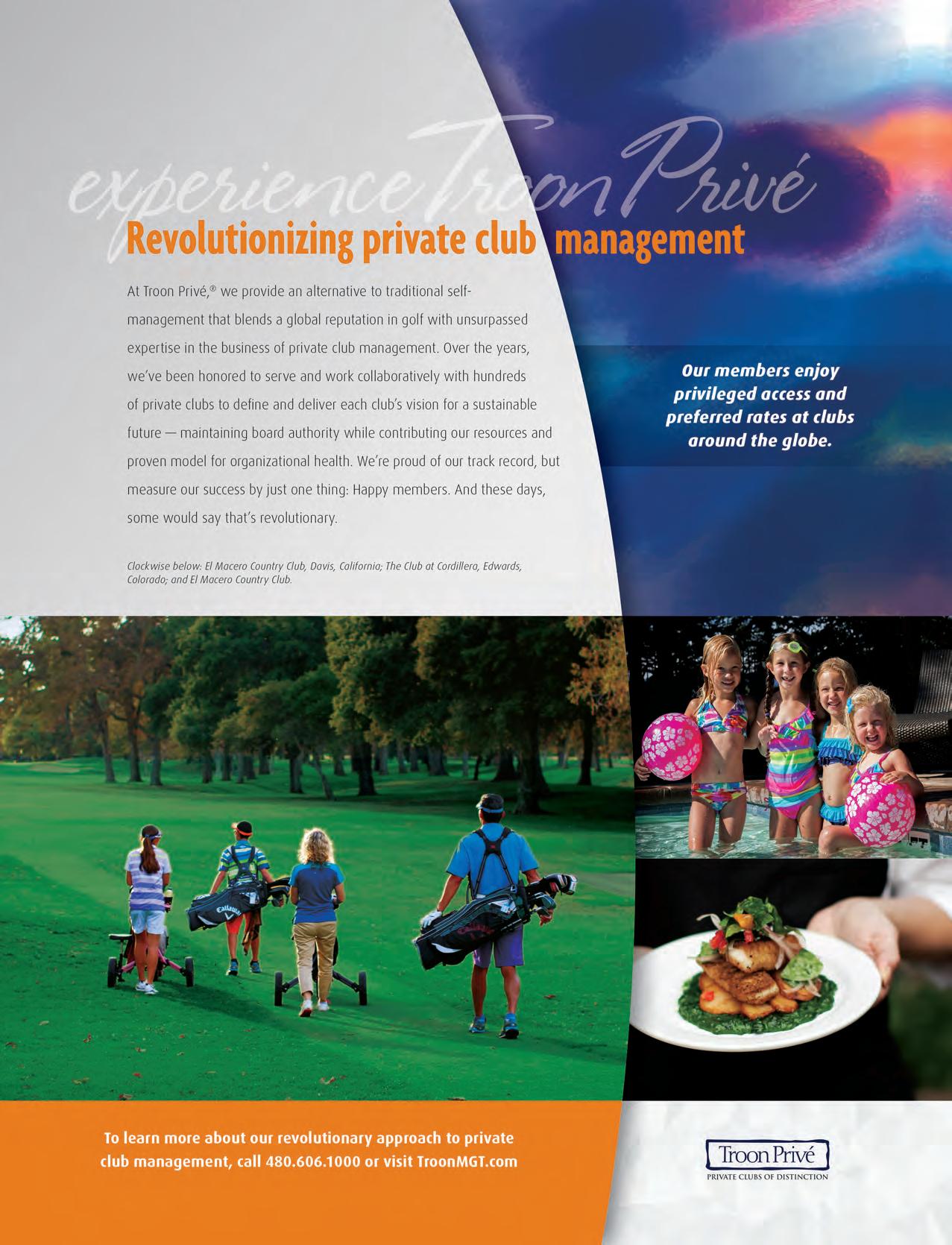


SARAH BAL
professional development is at the center of the club manager association of america’s (cmaa) mission.
Ask any CMAA member about our education program and I’m sure that you would hear about the Certified Club Manager (CCM) designation, our five-day, university-based Business Management Institutes (BMI), Conference education and chapter-based education.
But in this day and age, learning also happens every day online through blogs, electronic articles, podcasts, streaming videos of influential speakers, the latest documentary and even books available in a digital format.
Learning is all around us and CMAA knows its members are constantly learning and seeking educational resources outside of our traditional educational settings and in mediums they naturally comprehend.
CMAA members can now network online in CMAA’s active LinkedIn discussion group with more than 1,800 club management peers. They can catch up on industry trends by reading our biweekly e-blast Outlook or our blog Back of the House. And they can learn outside the BMI classroom and World Conference online at their own pace on CMAA University while continuing to work toward their certification goals.
One of the many CMAA membership benefits is complimentary access to CMAA University through the Club Resource Center. Just as technology has evolved over the past few years, so has our online learning portal: CMAA University.
Launched on its current platform in 2013, CMAA University focused on liability based training for managers and their staff. Our online professional development offerings were limited to the initial release of the revamped Manager in Development program.
Today, the Club Resource Center has two arms, a subscription-based service to enhance clubs’ operational efficiency by providing staff training courses and a library of club resources, and CMAA University, providing professional development for CMAA members.
Now through CMAA University, CMAA members can stream our most recent webinars, enroll
in our first certificate program created with McGladrey on Accounting and Financial Management, view the highest-rated sessions from the recent World Conference on Club Management, enroll in the complete Manager in Development program or engage in executivelevel education with Subject Matter Experts.
And the learning doesn’t stop there. As technology evolves, so do the opportunities for online learning and CMAA University. We are working on expanding our certificate programs to each of the 10 competency areas, starting with a certificate on membership development with Steve Graves from Creative Golf Marketing.
This fall, we will continue to expand by bringing the concept of micro learning to the system. Micro learning is content delivered in a concise form. The best example online is the famous Ted Talks.
CMAA’s goal with micro learning is to provide bite-size manager-led education that can be applied immediately by our members and their clubs. We are asking our contributors to present five to 10 minute PowerPoint presentations through our webinar platform with talking points and questions to each presentation.
Our goal is to have enough content by the 2016 conference to launch this program. We are currently seeking managers to contribute to this initiative. If you think your manager is skilled, or if you are a manager skilled in a certain aspect of club management, please contact me about teaching this subject. Technology is integrated into our everyday lives and will continue to influence use personally, at our clubs and the educational landscape. CMAA is committed to providing its managers with the finest club specific education and will our educational resources online will continue to evolve so managers can learn on their own schedule. br
Sarah Bal is the director of Virtual Education and Research Initiatives for CMAA. Learn more about CMAA University at www.cmaa.org/CMAAUniversity/. The Club Managers Association of America (CMAA) is the professional Association for managers of membership clubs. CMAA has close to 6,500 members across all classifications. Our manager members operate more than 2,500 country, golf, athletic, city, faculty, military, town and yacht clubs.


a new tension has emerged among young professionals at a country club.
Some professionals ask this question: What must I do to impress you, to gain your attention? Others ask: What are you going to do for me because I am working here?
Excellent country club teams have many more professionals asking the first question with virtually none for the second. In fact, excellent teams have zero tolerance for professionals asking the second question and this type of professional isn’t employed for very long.
Excellent teams have low tolerance for selfinterest because they have adopted this hospitality excellence formula: T + C + EMF x DE = HE
T = Talent, high performing professionals
C = Culture of trust, openness and collaboration
EMF = Extreme member focus, where the member is the number one customer of all professional staff members. We know our members better than anyone else and our delivery matches their preferences.
DE = Disciplined execution is the multiplier effect of delivering for the member again and again. Members are special!
HE = Hospitality excellence is the standard of being excellent in all aspects of the services delivered for the member – the standard endorsed by all team members and never compromised.
Young hospitality professionals are seeking private clubs where this formula is fully operational and delivery excellence is the norm. The clubs that have adopted this formula attract talent, retain it and develop it, and when hospitality excellence is the norm, the professionals on the team enjoy these benefits:
• Frequent investment in CMAA, often sponsored by the club
• Work toward the CCM designation of Certified Club Manager. It is encouraged by the GM and supported financially by the club
• Learn more about the hospitality craft by working with accomplished peers and successful bosses. This combination accelerates learning, and
• Contributing to a winning team.
These benefits are highly valued and each one represents an opportunity to accelerate professional development, when properly exploited. Being on a winning or excellent team means the young professional:
• Sees many examples of doing work at a high and sustained level of excellence. This feature creates the opportunity to imitate daily best practices
• Adopts performance excellence as the operating standard
• Can ask questions of more experienced team members and is pointed in a very effective performance direction. A F&B manager recently told me: “I plan to move on because I am not learning from my colleagues.” That’s the direct opposite and it’s a sad comment, but it reinforces the advantage of being on a winning team.
These seven benefits can be transformed into ongoing development opportunities for young professionals, and that’s why hospitality excellence and professional opportunity is a winning pair.
Today new professionals are relentless about getting feedback from their general manager and other bosses. They define feedback as specific examples of their effectiveness. With it they make continuous improvement in their hospitality “craft.” They are striving to improve and are intent on working for a general manager who will provide performance-enhancing feedback. It is one of the best ways to grow and develop.
Excellence with opportunity yields three outcomes for the young professional: 1) continued improvement in your craft with specific feedback 2) exceptional member relationship skills, and 3) a collaborative work style with peers and the GM. These key point drive success at every point in a career focused on a private country club. br
David W. Lacey is managing director, HR Services, The Hirshorn Company. He recently completed his second board term at the Philadelphia Cricket Club. He can be reached via email: dlacey@hirshorn.com
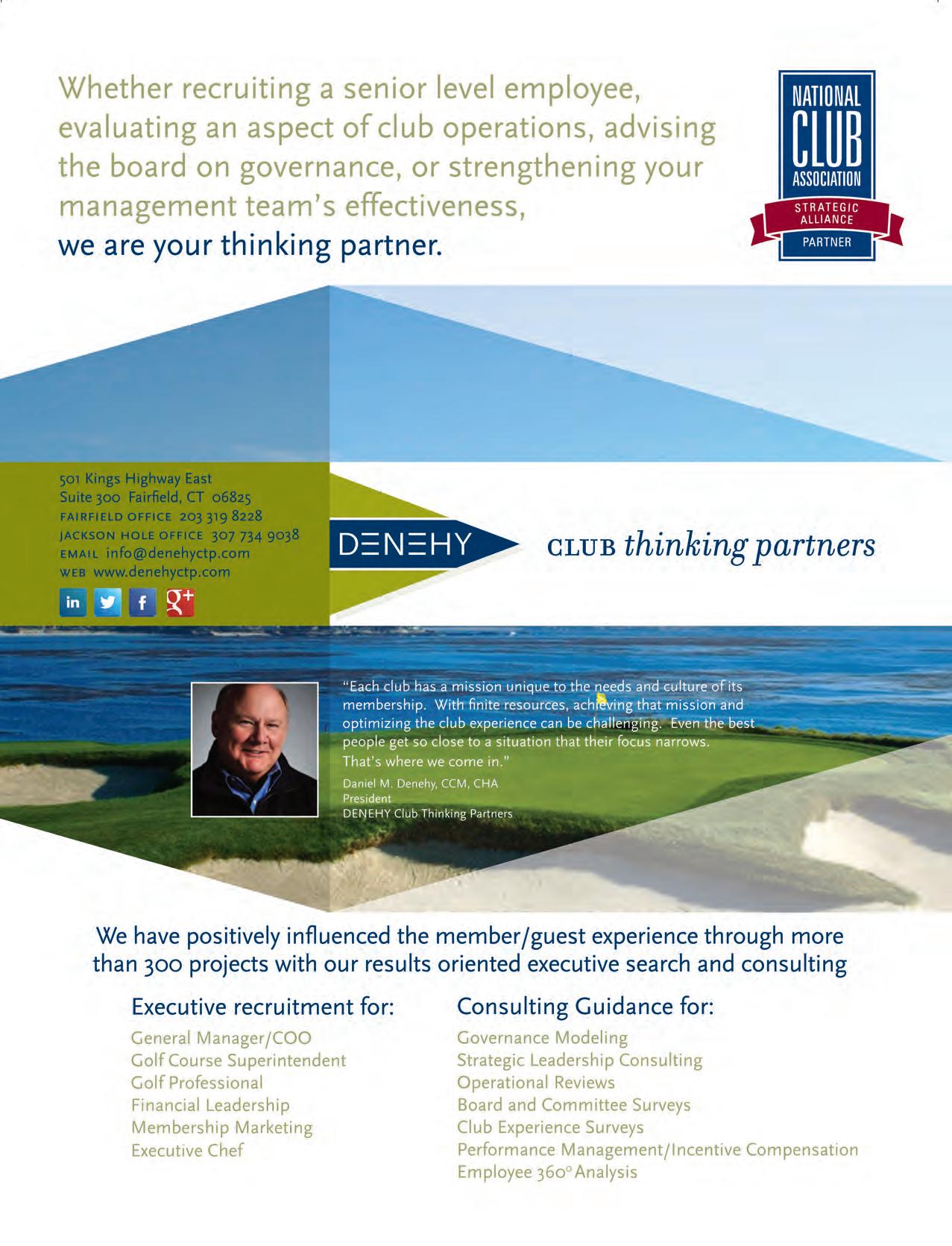
BY DR. RONALD F. CICHY
it is clear that hospitality organizations that select and develop Xenophiles (Xeno = stranger; phile = love) are more likely to succeed than those that simply hire the help.
Xenophiles go out of their way and make every effort to transform strangers into guests and then to satisfied guests who become advocates for the hospitality business.
Xenophiles know that the products and services delivered to guests are co-created with the collaboration of other Xenophiles (the managers and staff), as well as the guests. This is the ticket to guest loyalty resulting in the highest payback for the owner of the hospitality business.
Question: Who is the owner of a private club? Answer: Each individual who has chosen to join.
Think Like The Owner means thinking and acting like this collective membership as the owner. The capitalizing of Think Like The Owner is deliberate and intended to draw attention to the whole, not the individual. The whole as the owner is like no other form of organization in hospitality businesses.
The owner is the members and the leaders, both paid (COO, GM, managers, supervisors, staff members) and volunteer (members of committees and the board). These leaders must understand and collaboratively act like the owner. But how does the owner in a club think?
Take a minute to consider and differentiate the roles of the owner in a private club compared to another hospitality business (such as a hotel or a restaurant). The club owner may represent generations of family members who have been the owner. They frequent their club more regularly than a restaurant customer or a hotel guest.
The owner engages in relationships, at the heart of the reason why the owner belongs to a certain club, rather than the oftentimes simple, transaction-based nature of a hotel or restaurant.
The owner volunteers to lead the club as a committee member or chair, or a member of the board of directors, bringing her or his special expertise.
The owner is a fiduciary in that the owner is a steward of the club. Being the owner puts more responsibility and accountability on the individual who is challenged to see issues and opportunities from the collective owner’s view.
The owner is the members and the leaders, both paid (COO, GM, managers, supervisors, staff members) and volunteer (members of committees and the board). These leaders must understand and collaboratively act like the owner. But how does the owner in a club think?
A number of answers to this question come to mind that are either strategic or operational, either for long-term positioning or the shorter term. The owner begins by thinking about values.
Values are evidenced in actions of the individuals and the organization. The owner of the club may value family time and their behaviors will align with activities and experiences that bring their family together.
The owner knows the purpose or mission of the club. The mission describes how the club creates value for the owner. A mission powered by strong values results in satisfaction of those who participate in the club (i.e., members, staff members, managers, leaders).
The owner articulates possibilities for the future. The vision is what the owner wants to create in the future. The vision is a beacon guiding the owner as they live into personal values, as well as creating value for the collective owner.
One of the indicators of value is the owner’s participation in activities and events in their club, and the owner’s commitment to being a fiduciary.
The fiduciary role is one that has confidence and trust at its core. The members are certain that the leaders will act collaboratively and responsibly. In this situation, the owner fiduciary puts the interests of the members (the owner) ahead of the individual’s interests. The owner demonstrates the highest levels of leadership.
Now a special request from you, the reader. If you have a Think Like The Owner story to share, please take a minute and send it to me via email: cichy@msu.edu. br
Dr. Ronald Cichy has served as a professor in The School of Hospitality Business, Michigan State University, his alma mater, since 1988.



The BOARDROOM magazine is now accepting entries for its 2015 "Excellence in Achievement" awards. The awards recognize both vendors and educators for their impact, achievements and contributions to the club industry. All award entries and nominations must provide supporting materials to be reviewed by an independent panel of industry experts representing various aspects of course and club operations. Winners are selected for overall excellence in their respective fields, innovation, vision for future growth and continued impact on private club operations. Winners in each category will be featured in an issue of The BOARDROOM magazine in 2015. For more information, call (949) 376-8889 or email John Fornaro at johnf@apcd.com. All entries must be received by 10/31/2015.
golf courSe: Course Architect (new course), Course Architect (renovation), Course Contractor/Developer, Irrigation Company, Course Equipment Manufacturer, Course Maintenance Company, Golf Cart Company, Turf Maintenance, Fertilizer and more
clubhouSe: Clubhouse Architect, Clubhouse Builder, Clubhouse Interior Design, Master Planning, Fitness Consultant, Fitness Equipment, Furniture Manufacturer, Outdoor Furniture, Outdoor Cooking, Kitchen Equipment Manufacturer, Food & Beverage, Banquet Equipment, Pro Shop Interior Design, Menu Design, Amenities Provider, Apparel Provider, Clubhouse Signage, Tennis, Lockers, Club Service, Event Equipment, Construction and more taX, law, hr & finance: Executive and/or Department Search, Finance, Insurance , Law, Strategic Planning, Tax Consultant, Payroll, Research & Data and more technology: Software Developer, Technology Product, Website, Communications, Mobile Technology, Social Media, Online Reservations and more marketing& memberShip: Advertising, Marketing or PR, Membership Marketing, Photographer, Private Club Marketing and more other: Lifetime Achievement, Jim Singerling Leadership, BoardRoom magazine Dedication, International Leadership, Gary Player Educator, The Jay DiePietro Vendor, Apparel Company, Association Program, Association, Club Management Company, Consultant Company, Club Services Association, Developer, New Product, Purchasing Services Group, Research and Data, Real Estate, Winery and more
category:____________________________________________________________________company:______________________________________________________________________
nominating (if different from above):______________________________________________________________________________________________________________________ include the following supporting materials: 1) a one-page explanation of why the product/service/company deserves to win its category in 2015, 2) media kits, 3) press releases, 4) testimonialsand 5) marketing materials.
mail entry form, supporting materials and $50 processing fee per entry to: the boardroom magazine “2015 excellence in achievement awards” po box 9455, laguna beach, ca 92651 or fedex to 1100 South coast highway, Suite 309, laguna beach, ca 92651






there is only a dozen or so clubs in the country that as continuously operating private clubs in the u.S., have reached the their 125th anniversary
So it’s been a special year for Albany Country Club, one of this group, and the premiere club in Voorheesville, the capital region of upstate New York. The club’s board of directors created a special 125th Anniversary committee that’s come up with a variety of festivities aimed at including people from all membership categories and demographics.
Festivities have included a special golf tournament, special league events, the July 4th celebrations. A black tie gala of the century, and publication of the club’s commemorative anniversary book, scheduled for October, will cap off the club’s ‘quasquicentennial.’
During the club’s history, there have been many difficult times, wars and financial downturns. But periods of growth have always followed. This most recent recession has been long and difficult, especially in the U.S. Northeast where golf seasons are short and weath-

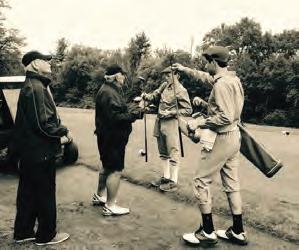

er dependent. This added strain has affected memberships levels, budgets and ability to maintain all the services and amenities and it’s also had a subtle negative impact on the attitudes, camaraderie and of the members and staff alike.
These special anniversary events needed to be more than the traditional “well-done” and the challenge to our management team has been to create something truly special for our members.
Our PGA professional Glenn Davis created a “Disney” type experience that took the members and guests on an historical tour with each hole being a time period in Albany’s long and storied history.
As the members and guests played each hole, they found tee signs highlighting significant events or happenings, members or golf professionals during a specific time in the club’s history.
For example, Albany Country Club began in 1890 as a Hunt Club so at the first hole gentlemen fox hunting with barking hounds greeted members and guests. About 200 members participated in this tournament, dinner and awards presentation including several 50-plus year members invited as special guests.
This year long celebration has had a significant impact on our members and has reinvigorated the club and members’ collective purpose. Our history and culture has instilled a renewed sense of club pride and cohesiveness that has for 125 years been Albany Country Club’s greatest asset. br

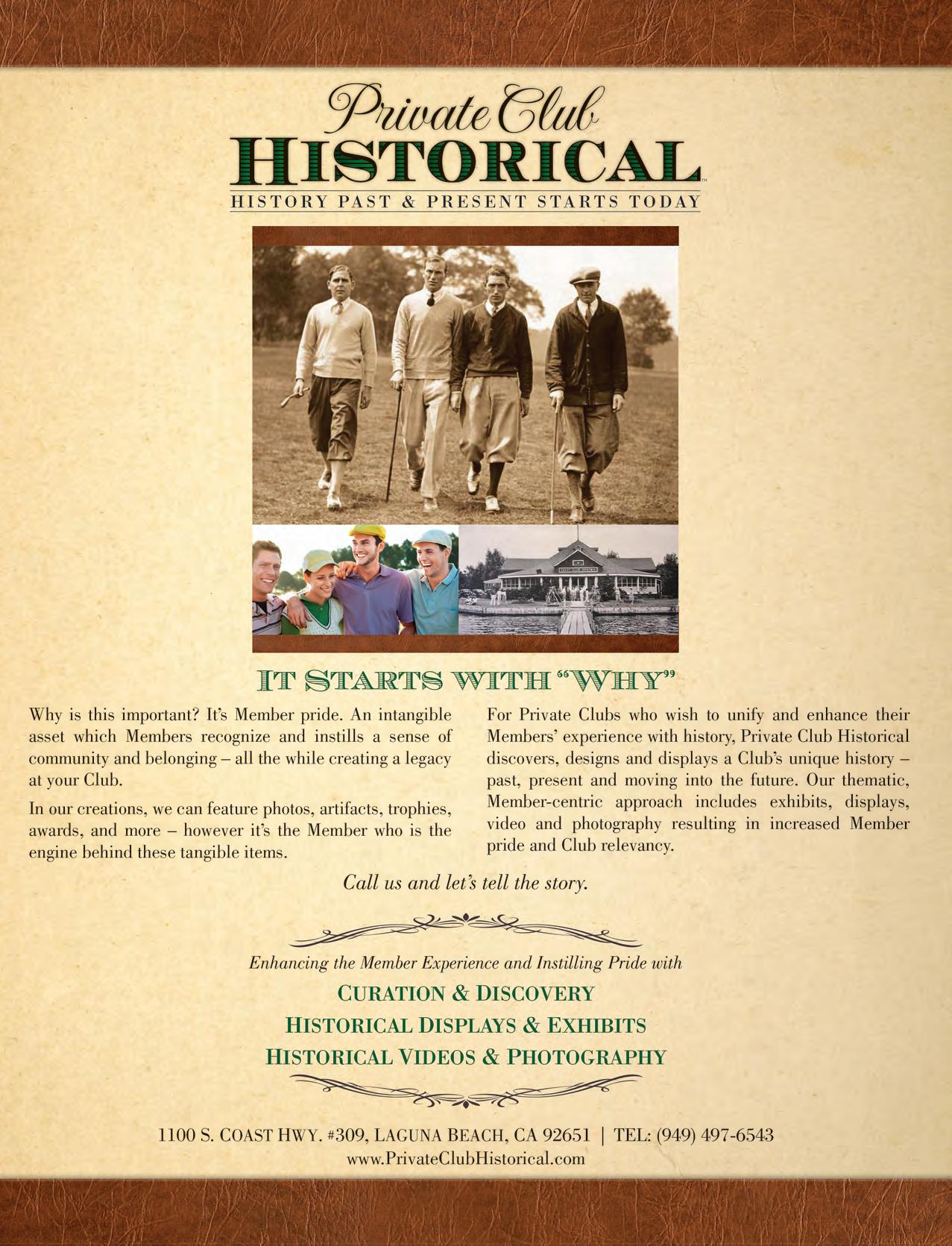

as a designer and clubhouse stylist, i always enjoy discovering new approaches and trends that can aid our club partners.
As a result of the economic downturn, we began implementing a new approach to long term project visioning and implementation, which we dubbed “Strategy based Design.”
I define Strategy based Design as a global approach to the normal artistry of club design and stewardship in which each design strategy and facility upgrade is considered in

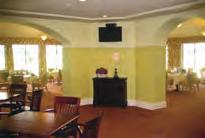
context with the club’s unique brand, membership demographic and overall long range planning strategies.
Strategy based Design has proven to be a primer for implementing positive change at any club. Whether it is a well-tuned club operation, one that has fallen on hard times or even an emerging club property in the early stages of development, Strategy based Design is the common thread that links a new model of thinking when it comes positioning a club for long term success.
five key benefitS of Strategy baSeD DeSign

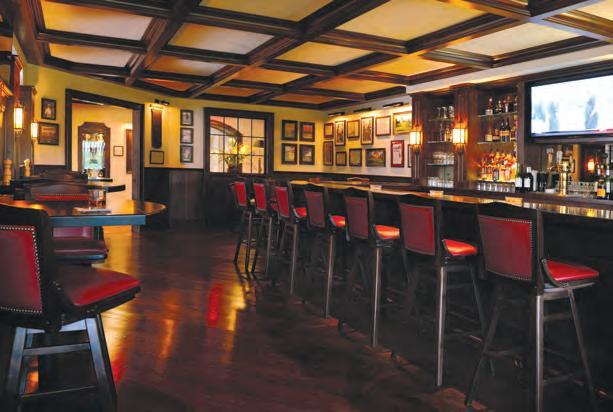




1. Provides a systematic approach to design via strategic long term planning, enabling you to identify, vet and support every clubhouse enhancement being contemplated.
2. Provides design solutions that exude your club’s brand and uniqueness ensuring the improvements you implement are in line with your clubs’ message.
3. It moderates the integration of technology ensuring you strategically weigh which trends and technology are right for your club and member demographic.
4. It maximizes the use of and the return on capital expenditures.
5. Ensures you maintain your competitive edge.
Don’t know where to Start?
Break down the complexity by identifying who you are as a club and where you need to be to stay ahead of the competitive curve. Then develop a multi-phased plan that will achieve your goals and set it into motion at your pace.
Remember no matter your club’s location, size, market demographic or profitability… Strategy based “roadmap” is the key to ensuring long-term operational success and guest satisfaction. br
Craig J. Smith, ASID is a partner and co-creative director at C2 Limited Design Associates, and can be reached at (203) 259 2555 or via email csmith@c2limited.com
before anD after pictureS at wee burn country



as the leading educational organization for tennisteaching professionals, the uSpta is always seeking ways to enhance the value of our certification and membership.
Now our association has added another member benefit that gives our professionals an opportunity to add credibility to their resumes that will be of interest to many club managers. Platform tennis is a rapidly growing sport, not just in the eastern and midwest states, but now spreading to parts of the south and out west. The increased participation means there is a need for more professionals to teach the game, which led the Professional Platform Tennis Association to believe that its members would be best served by combining with the larger USPTA organization.
The USPTA executive committee in April 2015 voted to incorporate the Professional Platform Tennis Association into the USPTA. Then, in May, the governing body for platform tennis – the American Platform Tennis Association (APTA) – announced the merger at its annual meeting in Toronto.Thus, on Aug. 1, USPTA began offering platform tennis certification as a separately tested and certified membership category under the USPTA umbrella.
The Platform Tennis Committee, chaired by Brad Easterbrook, former PPTA president manages the platform certification category. All professionals who become certified in platform tennis will receive all of the same benefits and pay the same annual dues as current USPTA-certified tennis professionals.
There are three types of certified professionals: those certified in tennis, those certified in platform tennis, and those who hold both certifications. Now professionals can be certified to teach both sports under the same USPTA organization, pay the same amount in annual dues and take advantage of all the same professional-level member benefits such as liability insurance, the Retirement Gold+ program, product discounts and much more.
For those pros who currently teach platform tennis but are not certified, this new category will give them the opportunity to be certified by the platform tennis committee with the credibility of the USPTA behind their names. The biggest impact will be felt at those clubs that currently
offer platform tennis as an amenity. We want pros to be fully versed in both games and be able to teach both sports. Courts are expensive, so it makes sense to have your teaching professional certified in both tennis and platform tennis to enhance their expertise.
USPTA professionals who hold both certifications in tennis and platform tennis will be more diverse and marketable to your membership, as they will have more credibility in teaching both games.
And for those clubs that are considering incorporating the sport into their programming, it’s another amenity to enhance the member experience. Platform tennis is a highly social sport, so there are a number of revenue opportunities.
The close proximity to opponents allows players to communicate more easily than a traditional tennis match, which makes it a great option for family programming.
Establish leagues and tournaments to give your members a healthy dose of competition and activity while socializing with other members, and then invite them to spend time before and after their matches to take advantage of your food and beverage offerings. The tennis season is typically three to four months long, but platform tennis – especially in those areas with harsh, long winters – can be six to seven months long. Since platform tennis is a traditional winter sport, it gives your members an opportunity for outdoor activity during those long winter months.
Clubs that provide platform tennis as an amenity are much more attractive to potential members. By offering platform tennis programming, your club can strengthen its membership activity by adding to their health and wellness while also giving them an opportunity to socialize.
And for those clubs that have platform tennis courts installed already, encourage your tennis pros to obtain a platform tennis certification and make the most out of having professionals on staff to teach both games. br
For more information on USPTA certification in tennis or platform tennis, visit www.uspta.com/certification. John Embree is CEO at the United States Professional Tennis Association and can be reached via email: john.embree@uspta.org or (713) 978-7782, ext. 117.




this is a time of tremendous opportunity for private clubs all across the country.
While clubs clearly fit the definition of a mature industry, they also fulfill one of society’s deepest emotional needs – the opportunity to connect with others. That will never go out of favor, even though the ways we make those connections might change from time to time. Here’s a list of some of the best things we see in the evolving world of private clubs:
Member attitudes: Anyone that is a club member in 2015 has thought through the merits of membership. They have determined that membership in a club is important to them and they are there for a reason. The effects of the 2009 financial crisis on America’s psyche have

Growth and change are no longer bad words. In fact, the last place you want to be in a mature industry is stuck in the past. The modern club can only happen if the directors are focused on strategy instead of operations. The governance process must include multiple opportunities throughout the year where your leaders take the time to understand the club environment and look ahead.
been profound and long lasting, and this has left us with very few casual members. The upshot of this is that today’s members want their club to be vibrant and they want to use it regularly. They are more open to new ideas and programs that than prior generations of members. Change is no longer the bad word it was a decade or so ago. Well thought-out improvement plans or the
introduction of new programs are much more likely to meet with a receptive membership. Push ahead.
Availability of capital: Most clubs have access to capital and it remains available at historically low rates. Clubs are in the dues business and making strategic investments to secure and expand your dues revenue is smart. Making capital improvements remains one of the top things a club can do to increase use and attract more members. While higher rates seem to be slower in coming than the Federal Reserve might hope, they will come and the clubs that missed that opportunity will rue it.
Population trends: The U.S will change dramatically in the next 20 years and people will work and recreate in whole new ways. There are opportunities on all sides of the major demographic shifts happening across the country. If you are in the Sunbelt, there are still a lot of Baby Boomers ready to transition out of the workforce. The booming equities market has restored many retirement nest eggs and improved housing markets mean they can sell their primary residence and buy into a new or second home. On the other end of the age spectrum, there are 80 million or so Millennials who are reaching the age where club membership makes sense. From a location standpoint, the new urbanism is helping city clubs that offer opportunities to those who increasingly live, play and work in the city and the gentrification of close-in suburbs can help older country clubs that saw stagnant markets in recent years.
The death of golf has been exaggerated: There remain 25 million golfers in the U.S. and the sport is adopting a new look and feel. The increased focus on practice, fitness and training opens up whole new avenues for how to attract and engage members. Improved practice areas, year-round golf learning centers and introduction of golf fitness programs are some of the top
ways to position your club for success. Junior play is booming. There is a whole new generation of athletic and dynamic professional golfers drawing attention to the game. Golf clothing has moved from the ugly slacks phase to bright colors with an eye toward performance. Dare we say it, but golf is getting cool, which is a good thing.
Interest in health, fitness and wellness is pervasive: Clubs are the perfect place to satisfy the ever-increasing demand for healthy lifestyles. The affluent group that comprises membership has the time, money and inclination to extend their life through healthy living. While your approach may include a fitness center, there are many ways to engage members in wellness. It starts with the camaraderie that can be instilled through engaging social and recreational programs. It extends into food and beverage, where there is unprecedented interest in fresh and new ingredients, ethnic foods and new tastes. The demand for wines, craft beers and mixology is off the charts. This may be the key opportunity clubs face in the years ahead.
Technology: As you can see in this issue of The Boardroom, there are many ways to deploy technology to make your operations more efficient and cost effective, to engage and communicate with your members, identify and track satisfaction and analyze your business model to determine what is really happening on the ground. Tech
can make your club smarter and more responsive. Clubs remain behind the curve when compared with how other hospitality organizations are using technology.
The key in all this is to make sure your governance and management process is such that your club can take advantage of the many opportunities available to it. We continue to find boards that are focused on cost cutting and risk aversion instead of embracing the opportunities before them.
Growth and change are no longer bad words. In fact, the last place you want to be in a mature industry is stuck in the past. The modern club can only happen if the directors are focused on strategy instead of operations. The governance process must include multiple opportunities throughout the year where your leaders take the time to understand the club environment and look ahead.
As with any business, the key to success for clubs is to adapt to the future while remaining true to your core values. Based on what we are seeing on the ground, you are more likely than ever to find an open-minded and receptive membership and marketplace when well-researched and effective plans are put before them.
The chief responsibility of club boards is to assemble and push ahead with these plans. br
Frank Vain is president of McMahon Group and can be reached at (800)365-2498 or via email at fvain@mcmahongroup.com


In speaking each year with hundreds of board members at equity clubs around the country, we encounter a common misconception: Board members often lump their club-funding challenges together with their club-management challenges.
The first step is to identify the problem that truly needs solving.
If a board has struggled to find the right general manager and is committed to self-managing the club, in the tradition of private equity clubs, then hiring an executive search firm such as Kopplin & Kuebler, GSI or Search America is a logical step.
If a board is grappling with governance questions – for example, whether to continue trying to hire and supervise the GM position versus perhaps outsourcing that managerial function –then interviewing Troon, Kemper and other “golf management companies” is a logical step.
Industry observers agree that fully half of America’s private equity clubs already carry debt totaling 50 percent of gross annual revenues, or more. When board members describe to us this type of debt burden, only to circle back to executive search firms and third-party management options, we immediately stop the conversation and back up a bit. GMs are hugely influential employees, but a new one will not solve these capital issues.
Too often, however, we encounter a mash-up of these with the fact that a particular board is grappling with capital-project and debt issues –classic balance sheet funding matters.
Industry observers agree that fully half of America’s private equity clubs already carry debt totaling 50 percent of gross annual revenues, or more.
When board members describe to us this type of debt burden, only to circle back to executive search firms and third-party management options, we immediately stop the conversation and back up a bit. GMs are hugely influential employees, but a new one will not solve these capital issues.
For answers on the capital front, these boards are often looking in the wrong places.
There are literally hundreds of third party, fee-based golf management companies out there: Ninety-five percent of them have no capital. Most have never owned a country club, nor have they ever made a capital investment in a client club.
They are hired operators, paid by the month with annual bonuses to oversee your on-site club staff. It can be a useful service, but one that has zero to do with your club’s balance sheet.
Here’s what I mean by balance sheet issues: Most often, a club has an existing bank loan that funded a clubhouse expansion or greens renovation a few years ago. Today, the club has developed a “master plan” for further golf course or clubhouse work, or perhaps its small fitness room is not competitive with those at nearby clubs.
These are funding issues and if a club is already dealing with debt, the board has essentially three choices when attempting to secure those funds:
Debt — Get a bank loan, add to an existing bank loan, or get a handful of members to act as the lender.
Assessments — Add up the capital projects to be funded and divide by 350 (your current number of equity members). This can be a one-time assessment, or it can be spread over two to three years as smaller “capital dues” payments.
Outside capital partner — Instead of having your members pay, have an owner-operator pay. Concert Golf, ClubCorp and a few other companies will pay for these improvements and retire your debt, while member dues stay the same.
The added benefit of an outside partner like Club Corp or Concert Golf is, these companies also operate the club on behalf of the members (this is likely where the confusion with golf management companies lies).
Owner-operators, as the name implies, typically handle both the funding and management of a club, though there are only a handful of firms who do this nationally – and even fewer have the capital on hand to retire club debt and reinvest in the club via these vital capital projects.
For clubs carrying significant debt, further borrowing (to fund capital projects) would naturally exacerbate the debt issue, though securing this type of financing is difficult.
Banks and other lenders have essentially vacated the golf sector in the wake of the recent recession.
If bank-funded capital is, in fact, secured, dues increases and/or assessments are required to chip away at the debt load. If bank-funded capital is not secured, dues increases and/or assessments also result.
There are several ways to slice this issue, but one thing is immutable: Member-led club governance requires that members themselves pay for these capital improvements.
Many clubs are making this work via the bank loan or assessment route, but many are not.
For the latter grouping, the dilemma boils down to this: To what extent should boards continue to value self-governance over the ability to effectively self-fund these capital projects?
For these clubs, the matter at hand is unrelated to management issues. It’s more serious than an ineffective GM — because funding capital projects is not optional. It’s something private clubs must do today in order to compete and survive. BR
Peter J. Nanula is chairman of Concert Golf Partners (www.concertgolfpartners.com), an owner, operator and all-cash buyer of private golf and country clubs. Nanula is the former CEO of Arnold Palmer Golf Management.
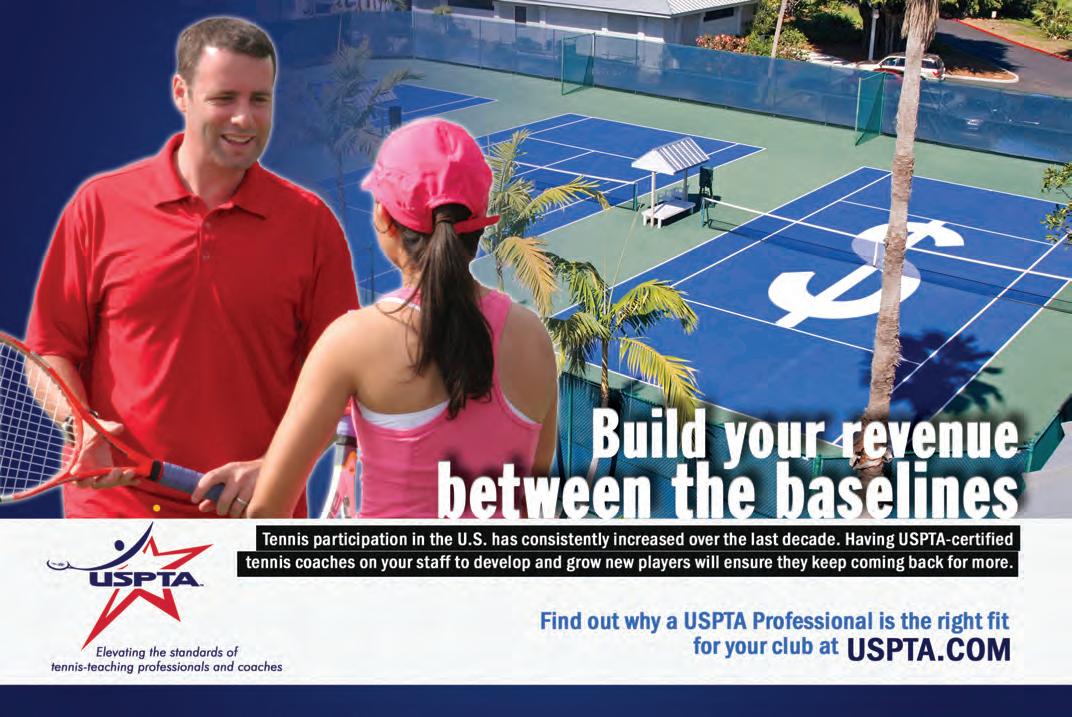


Most people associate technology in golf with equipment, such as how far you can hit the ball with a particular driver, but technology plays an equally important role in other areas of golf as well.
GolfforHer.com, a website designed to create a focal point for women and girls who play or aspire to play golf, is an example.
In May 2013, golf industry leaders attending the GOLF 20/20 strategic planning meeting recognized the need to make women’s golf a key area of focus for the golf industry.
As a result, a women’s task force with representatives from golf’s leading organizations was immediately formed to address this issue and to determine the best strategy to guide the industry’s efforts to increase interest and participation in the game by women.

The task force ultimately decided that the creation of a communication hub to provide access to information on women’s golf would have the most meaningful impact on the development of women’s golf worldwide.
Stina Sternberg, a member of the GOLF 20/20 Women’s Task Force, took on the responsibility to create and launch a website that would serve as an information portal for all things related to women’s and girls’ golf.
Through Stina’s efforts, and those of several others, GolfForHer.com was launched on the PGA Forum stage in January of this year at the PGA Merchandise Show. This would not have been possible without the financial support of ClubCorp and TaylorMade, whose contributions covered the creation and ongoing management of the site.
The response to the site has been very positive. Since its launch, the site has been featured in more than a dozen industry publications. More than 43,000 people have visited the site and have accounted for more than 88,000 page views, as the site grows rapidly. The site’s singular purpose is to create a resource for all women interested in the game — from those who have never played, to those who are returning to the game, to those who play the game but want to engage more with the golf lifestyle.
The site is designed so that visitors will be directed to the appropriate information source, where they may learn more about the area in which they are interested. The site is designed to highlight and promote initiatives, events, people and products that might be interesting to female golfers of all ages and abilities.
The overarching goal of GolfForHer.com is to develop greater interest and participation in the game among women and girls. Specifically, our objective is to move women’s participation in golf from 20 percent of the overall golf population closer to the 50 percent of the U.S. population that women represent. We believe that GolfForHer.com will be a critical tool in helping to achieve this goal.
As facility leaders, here are specific ways that you can help support the site and ultimately grow interest and participation in the game among women:
• Create awareness of the site among your women members and guests by including features in your newsletter about the site, or make announcements about the site at your women’s golf club meetings
• Consider contributing content to the site if you have programs you want to make known about women or girls golf
I encourage each of you to consider what you can do to support GolfForHer.com. BR
Steve Mona is the chief executive officer of the World Golf Foundation. He may be reached at (904) 9404000 or via email: smona@worldgolffoundation.org.



Eating out is one of the great pleasures in our society.
It is also one of the significant benefits of belonging to a country club and the key reason social memberships are so popular. A private restaurant, a fine setting, a specially crafted menu, a dedicated chef: all benefits.
So it was somewhat disheartening to recently learn that the executive chef at Spring Lake Country Club (where I’m a member) had resigned to take on a new challenge. Our general manager sent an email stating, “Our hope is to have our selection finalized and the right candidate in place by late June, but we will take all the time needed to select the right candidate.”
His email got me thinking. In the private club world, exactly what does it take to be the “right” candidate? Exactly what should a club look for in hiring a new executive chef? And, exactly what are executive chefs looking for in their employers?

Nationally – and due in part to the popularity of such television shows as the Food Network’s Iron Chef and Bravo’s Top Chef – the idea of becoming a gourmet chef has rapidly become an alluring profession. According to an article in Time magazine,
It’s been a few decades since we started turning cooks into stars, and still the phenomenon continues to grow. These days, the Emerils, Marios and Gordons of the world scarcely need the qualifier chef — they are celebrities, plain and simple. But between the television shows, the food festivals, the Vegas outposts, [and] the spaghetti-sauce labels bearing their names… it’s easy to overlook the impact that fame has had on the once disparaged profession of cooking. In the Food Network era, the phenomenon of the celebrity chef has utterly transformed the restaurant industry and, in the process, changed the very nature of how we eat.
Not surprisingly, overall enrollment in forprofit trade schools – which includes culinary schools – has increased by about 20 percent a year for the past two years, according to the Association of Private Sector Colleges & Universities. For example, one company, the Career Education Corp., which operates 17 culinary schools in the U.S., has seen enrollment increase by more than 46 percent since 2008.
What this means is that more (and younger) aspiring chefs are entering the job market, where the U.S. Bureau of Labor Statistics estimates that job growth for chefs and head cooks is increasing at a rate of about five percent… slower than the average for all occupations. So, chefs can generally expect to encounter keen competition for jobs, particularly where pay is the highest – at private clubs and upscale restaurants, hotels and casinos.
According to Payscale, Inc., the average salary for executive chefs nationwide is around $56,000 annually, but this varies according to region (California and New York are highest). It also depends on the existence of bonuses and profit-sharing plans, which can add another $10 to $12,000.
Among private clubs, the CMAA 2014 Compensation and Benefits Report reveals that the 50th percentile base salary for an executive
chef is $87,250 (with an additional cash bonus of $5,417 and $2,000 in professional development funds). So it’s easy to see why private clubs are sought as lucrative (and stable) employers.
Demographically, executive chefs are overwhelmingly male (89 percent), Caucasian (81 percent), have been in the kitchen for 11.1 years, and average 40 years in age.
First, keep in mind that the word “chef” means chief in French… so your executive chef needs to be a leader – not only in cooking and running a kitchen, but also in restaurant management. Ultimately, the goal is to deliver mouth-wateringly good culinary dishes, efficiently. As Kevin Green, general manager at Spring Lake Country Club ) put it simply, the goal is “the ability to produce great food.”
Whether it’s served poolside to a 13-year-old, in the dining room to a 65-year-old, or to 250 guests at a wedding reception, the executive chef is responsible for creating the menu and standardizing recipes and techniques, staffing (hiring, training, scheduling, and supervising kitchen employees), inventory and ordering, budgeting (food and labor), adhering to high quality food, sanitation and safety standards, and performing other duties as requested (which typically includes attending meetings).
The executive chef must also have an impressive culinary education and a glowing list of references, exude the high professional decorum, exhibit excellent communication and interpersonal skills, and be able to take any criticism that’s dished out (pardon the pun).
“For private clubs,” Green states, “being able to handle a diversity of responsibilities – simultaneously – is paramount.”
Or, as Red Rocks Country Club’s (Denver, CO) position announcement tantalizingly put it, the executive chef will possess “an artisan approach to the craft coupled with a persona exuding hospitality that is relationship savvy and intuitive creating menu programing that anticipates membership expectations.”
It’s a tall order.
First, according to Chef Adam, sous chef at Crosswater Club in Bend, OR, it’s critically important that the executive chef has a keen understanding of their customers and their culinary desires. This can be tough because there’s an inherent mismatch – a generation gap – between chefs and their patrons.
The average member is a Baby Boomer (over 60 years), while the culinary staff is 20 years – or more! – their junior. So you can’t assume that your “meat, potatoes and
green beans” Baby Boomers will be jumping on-board with baobop, soursop, kaniwa (similar to quinoa) or crickets –all projected to be trendy food items in 2015.
So, troubles could be brewing if your executive chef is a self-proclaimed foodie.
And here’s a thought-provoking definition: A foodie is a person who “likes to eat and socialize about food as a means to differentiate themselves from the non-foodie, but not necessarily for the sake of knowing about or understanding the food itself.”
Consequently, a great question (from Spring Lake Country Club’s chef interview protocol) is, “When you go out to eat, what do you look for in a restaurant? What is your favorite food to eat?”
While the notion of work/life balance is something chefs tend to scoff at – the average U/S. executive chef is working 12-hour days (and nearly 40 percent work up to 80 hours per week, according to Payscale, Inc.) – it’s also something they crave.
So, Generation Y chefs (those born after 1980) may not share the same quest for professional advancement as their Baby Boomer employers. Instead, they appreciate flexible hours… being able to spend time at home or go on an occasional non-Monday night date!
According to one human resources expert, “Gen Ys view time as a resource that they can fill with all of their varied interests, projects, hobbies, families and volunteering. They are willing to work hard at work, but it is only one component of their lives. Time is a limited resource that they don’t want to waste.”

Epilogue: Spring Lake Country Club hired L. Fernando Mojica, CSC, as its new executive chef. He is a Chicago area-trained chef, who claims his favorite hobby is culinary competitions (he uses them as an educational tool for himself and his staff, as well as a networking tool). BR
Special thanks to Kevin Green (Spring Lake Country Club), and Adam Levenburg (sous chef at Crosswater Club) for their thoughtful suggestions about this article. Nancy Levenburg, Ph.D., is a Professor in the Seidman College of Business at Grand Valley State University in Grand Rapids, Michigan. She is the President of Edgewater Consulting, and is a member of Spring Lake Country Club in Spring Lake, Michigan. For more information, contact her at: levenbun@gvsu.edu or (616) 331-7475.
By Dave White, Editor, BoardRoom magazine
BoardRoom magazine annually recognizes the world’s top private club presidents, captains and chairs as Private Club Presidents of the Year, for their outstanding work, their understanding of the industry, and role and responsibilities of the club’s board of directors. In this continuing series, BoardRoom introduces four of the top 22 presidents for 2014.
Private club board presidents play a huge role in professional operations of their clubs as a volunteer working diligently with their board of directors and general managers, striving for well informed, but not emotional decisions.
This recognition by BoardRoom magazine has attracted board president nominations from clubs and other nominators around the world.
These outstanding presidents exemplify the focus on the leadership responsibilities, the accountability and the management of the board providing a healthy respect for the club’s macro management. They are cognizant of the importance of working, effectively and efficiently, with their volunteer boards and the dedication required from everyone with whom they work.
Key elements of a “good” board include commitment, competence, diversity, collective decision making, openness, transparency, effective communication with the management and the membership, fiscal responsibility, development and establishment of the clubs’ mission, vision and policy direction, especially through establishment of a strategic plan.
A successful board president draws upon the expertise of other board members, the club’s institutional memory and stewardship of the club’s resources. As well the board president provides new board members and future board presidents with information they need to perform effectively as board members.
Congratulations to these outstanding private club board presidents.
Five club president profiles on page 58 and 59
Sponsored by

Who is your choice as the top private club board president?
Many people and companies associated with the private club industry are given due recognition for their accomplishments, and now BoardRoom magazine is focusing on selection and recognition of the Private Club Board President of the Year .
BoardRoom magazine, through a nomination and selection process, will honor 20 board president finalists worldwide and one prestigious Private Club Board President of the Year Award.
The top 20 private club board president finalists will be selected by a BoardRoom committee comprised of industry experts and sponsors, who can make an expert judgment, who have an understanding of the industry, the structure of the board of directors, and the role and responsibilities of a club’s board of directors. A third party accounting firm will audit results.
A special section published in BoardRoom magazine will be devoted to the announcement of the top regional club presidents and the “Private Club Board President of the Year.”

Entry and Deadline
Visit www.boardroommagazine.com to download the criteria and application form. Entries must be submitted no later than Thursday, November 17, 2015. For further information contact John Fornaro (949) 376-8889 ext. 2 or johnf@apcd.com


brian Spiller’s calm and focused leadership style has kept Woodfield country club’s board of directors centered and effective, while also cultivating harmony between the board, the club’s management and membership.
With a focus on the future and a dedication to making the needs of the Woodfield community a priority, Spiller took over as president in 2014… a standout choice for the position. He joined the board in 2009 and became vice president in 2011.
Spiller has played an integral part in the club’s long range plan (lrP) from inception through its execution. His countless hours of work on the plan started in 2010 as co-chair of the long range planning committee.
the committee launched an extensive survey to gauge membership opinion, followed by in-depth analysis of the results,
which led to a list of priorities and ultimately to the multi-million dollar renovation project that it is today.
Spiller, as vice president and the ‘voice’ of the long range plan, helped guide the club through its very important lrP membership vote.
As president, he has been entrusted with carrying out the two phases of the lrP to best support the needs of the community and the club’s future.
In addition to the lrP, Spiller’s well-rounded committee work includes serving as chair on numerous committees, including membership/communications, golf, house, human resources and card rooms.
Passionate about the game of golf, Spiller along with the Golf Professional Staff spearheaded Woodfield’s golf certification program.
It’s designed to educate and inform members about golf course etiquette, pace of play, course care and Woodfield’s rules and policies.
An advocate for communication, Spiller sees to it that the membership is fully aware of all pertinent club information and happenings, and always welcomes input from members.
As Phase 1 of the lrP nears completion, the board continues to look to the future – working together with general manager eben Molloy to create the club’s strategic plan, to help direct Woodfield’s future.
brian Spiller lives in boca raton, Fl and enjoys traveling, golfing and spending time with family and friends. BR


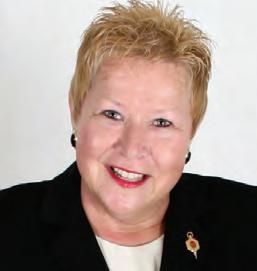
A number of achievements marked the time of Gale Nye Pinckney as commodore of the Newport Harbor yacht club, including the fact it’s the first time in 98 years the club has had a female commodore.
However, her achievements came during a time of somewhat trying circumstances. the devastating illness and the untimely passing of the club’s general manager tom Gilbertson in September, 2014 truly shaped Gale Pinckney’s year as commodore.
Pinckney had worked closed with Gilbertson during his 11 years as the club’s GM, and relied upon his expertise and long-term knowledge of the club’s operations.
“Anyone in voluntary leadership will tell you what a source of comfort it is having a general manager so well versed in the nuances of club operations,” Pinckney explained.
“day to day operations without a GM present became very complicated, and through our conversations with tom, we developed the concept of having an interim GM,” she added.


Old Westbury Golf & country club is back on track with an eye to the future, and much of the credit goes to barry Swidler for his outstanding work as president during 2014.
From its founding in 1961 through 2008, Old Westbury had only three general managers, and another three in the following four years – 2009 until 2013.
Old Westbury was developing a reputation as being “a hard place to work.” As well, during this time, myriad staff problems became evident – a clear result of the “leadership problems.” It was a time for change.
After his election as president, barry Swidler (who some years earlier had served three consecutive one-year terms as president) knew it would be difficult but absolutely crucial to find the right general manager for Old Westbury.
A general manager search resulted in the hiring of Markus rentzing in February 2014, as the club began its climb back.
Once the new general manager was in place, along with the new golf pro, Mike Meehan, president Swidler implemented strict guidelines and a process “to give the general manager authority and direction to run the club without board interference in day-to-day operations.”
As president barry exclaims: “Markus runs the club. I run the board.”
today with the board members melding as a cohesive group, the board is back on track…an engaged group now leading the club to new successes. there is greater member satisfaction and a resurgence of new members as Old Westbury is growing again.
President Swidler also has led the board through a process on how to improve the club’s governance, including several changes, which the club votes on this September.
As president, Swidler’s primary goal is focusing on the big picture and what’s best for Old Westbury’s membership.
With this continuing leadership and a supportive and cohesive board, Old Westbury continues to grow and remains well positioned to retain its place as an outstanding member of the long Island country club community. BR
crystal thomas, a close friend of Gilbertson and a consultant in the private club industry, joined the club as interim GM. “this helped us navigate the water, striking a balance that gave tom comfort, while having boots on the ground to maintain the intricacies of running full-time club operations,” Pinckney intoned.
throughout this time, the club’s leadership under commodore Pinckney pushed on.
the club’s long-range facility planning committee succeeded in getting the club’s rebuild approved in concept by the city of Newport beach. Focus groups and an internal survey enhanced the club’s communication with membership about the rebuild plans.
“For 2014, we focused on overall member satisfaction, camaraderie, sailing, cruising, racing competitively, maintaining our edge on the worldwide yachting stage, and
training our children in a strong Non-calm program,” Pinckney commented.
“We revamped our electronic communications with our membership, instituting a weekly sailing update, as well as condensing our other communications into a single, weekly electronic blast, and worked with the membership committee to enhance and streamline our membership process.”
the club hosted a u.S. Sailing team tour, featuring four Olympic hopefuls. three of these potential Olympians – chris barnard, charlie buckingham and Sydney bolger – are the products of NHyc’s very own Non-calm program.
“And, my piece de la resistance!” Pinckney exclaimed. “We hired lindsay Pizarro as the first female general manager in the club’s history,” during a time in which the Newport Harbor yacht club faced many challenging times and changes. BR
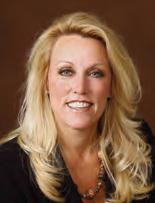
Membership professionals today are tasked with so much more than just taking prospective members through the approval process.
They are no longer administrators, working to grow the membership numbers through tours, referral programs and answering the telephone (when it does ring for membership inquiry).
Today’s membership director professionals truly are marketers, whether they carry the title or not. They are professionals who have to be knowledgeable of all facets of marketing, including the technological resources we have.
Communication tools, customer relations management programs (CRMs), member surveys, point of sales programs, website coding, and developing and updating…the list for membership professionals in understanding technology goes on and on.
Membership professionals are finding two areas that are must-have tools to better preform their day to day roles. They are a well-defined CRM program and an informative, online member survey.
Both of these tools enable the membership professional to accomplish the two most primary areas of their concern – recruitment of new members and the retention of existing members. CRM programs, for years, have been in the sales world in just about every industry. However, until the last year or so, technology entities in the private club industry had not taken note of the need for a CRM program to be developed specifically for the private club industry.
Point of sale programs have included “membership modules.” Unfortunately nothing had been developed giving the membership professional a tool allowing them to manage all points of contact starting with the prospecting phase, and then transitioning easily into the prospective member joining phase, and then storing all of the data in a member profile phase.
Only recently have technology companies, primarily website and communication companies began to realize that membership professionals are challenged by not having a good CRM system.
Engagement starting with prospective members truly sets the pace for the success of any private club’s matriculation efforts. There has been customization of programs such as ACT or Sales Force that have served a good purpose, but in today’s successful clubs the use of better technology is becoming more demanding.
A CRM program that is able to provide one point of data entry starting with the membership prospecting level and move forward beyond the membership approval level into the total aspect of being a member of a private club truly is the way to go.
Having the ability to capture data from a prospective member, use that data automatically defined processes that will take that prospect all the way through the closing cycle of a membership sale is absolutely necessary, giving assurance that not one prospect or prospecting process slips through the cracks.
CRM programs such as eProspect, that have been specifically developed for the private club industry allow membership professionals to utilize the club’s website and communications technology and the club’s point of sale programs, when applicable, to track all points of contact.
It allows all communication with members to be stored in one CRM program, and enhances our ability to monitor trends and information regarding members and their interest, spending habits, usage habits, along with member’s family information.
The fact that it’s a multi user system offers an additional and valuable benefit. Now all department head managers have immediate access to valuable information about prospective members and the general membership at large, providing very smooth access to the 360 concept of membership. BR
Donna Coyne is CEO/Placement Specialist, Professional Club Placement Services. She can be reached via email: Donna Coyne donna@pcps4u.com www.pcps4u.com

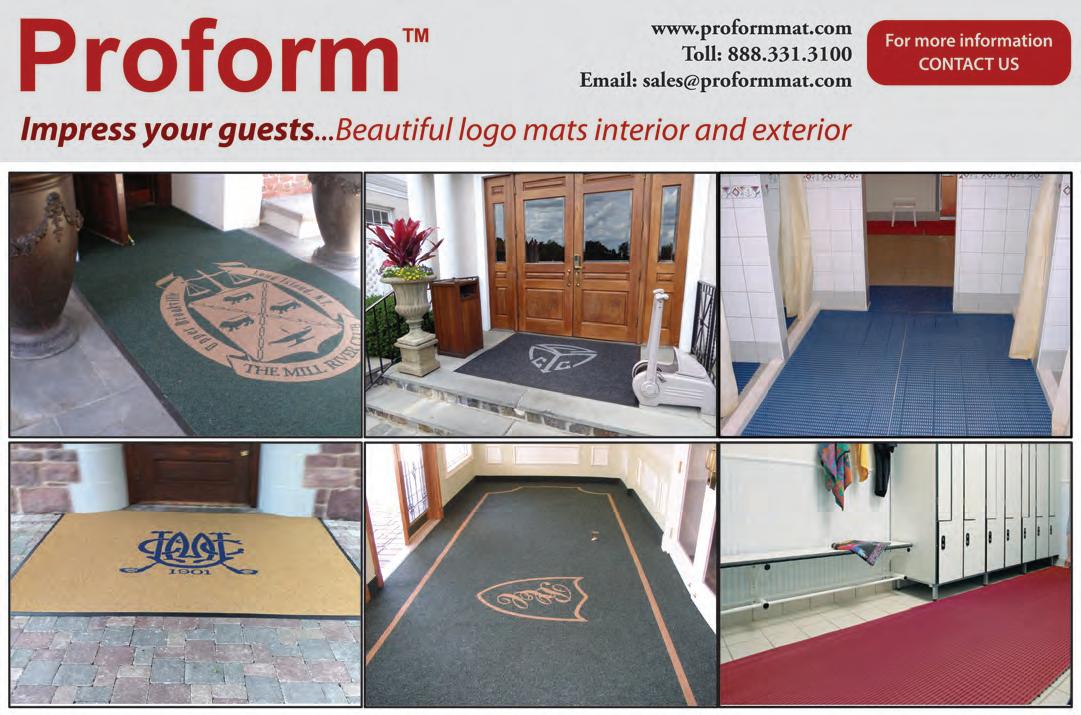
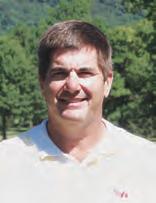
Every club has its controversies. A big one at our club (and most clubs across the country) is pace of play — not the phenomenon itself (everyone’s against that) but its management and enforcement.
When it comes to how we should address these issues, there are as many opinions as members. However, all the stakeholders seek the same result: smooth-flowing rounds resulting in good experiences for everyone.
Scrutiny of these issues has increased of late. My clients are all talking about it and a quick browse of the Internet shows no shortage of articles, videos and other relevant content.
However, most of it focuses on the player, with suggestions ranging from being ready to play, planning ahead for one’s next shot and keeping one’s pre-shot routine short, etc.
The USGA devotes an entire section on its website to pace of play, most of it playerdirected.
It’s high time we all recognize the player represents only one third of the slow-play equation.
In the UK, where pace of play isn’t nearly the problem it is here in America, the R&A has wisely broken it down into three elements:
• The players
• The management of play
• The course.
Having just spent an enjoyable week in Scotland playing typical rounds in 3:45 or less, I promise it enhances the experience.
Because there is so much player-related information at large, let’s focus on the latter two –and a new piece of technology that may help address (if not completely solve) this nagging problem.
Management of play is a challenge at many courses because the staff is generally reluctant to go out on the course and encourage (or reprimand) members/customers to pick up the pace. As such, the course ranger simply rides by in a cart and waves to make sure everyone thinks he’s a nice guy.
At private clubs, a young assistant pro wants nothing to do with confronting Joe Board Member about the two holes open in front of his group. I even recently read of the concept of sending out threesomes (instead of the traditional foursome) at shorter intervals to speed play and generate the same number of rounds in a day.
The concept of creating a time par, to which all players must adhere, sounds useful in theory. Problem is, on any given day the rough or wind may be up, or the greens particularly firm and fast, meaning more time spent looking for errant shots in the rough, looking over putts, etc. Tough conditions mean more strokes, plain and simple.
Because most golfers are higher handicappers, the problems with time par are exacerbated, especially when there’s an event calling for everyone to hole out.
“Time par” is a valid concept, but only when established daily, according to course conditions and the nature/format of play. This was acknowledged at this year’s U.S. Open.
But clubs also need to manage play and set-up their courses more intelligently, to create the conditions that allow efficient play, whether a time par has been established or not.
As one who regularly plays 18-holes in three to three and a half hours when unimpeded, I’m all for picking up the pace, but when I see players rushing around the course, not having the chance to hole out, and otherwise not getting the personal “down time” many play golf to experience, I see why people are leaving the game in droves.
Most golfers want to play the game with minimal waiting. But marginal golfers are apt to abandon the game (and their club membership) if they feel like they’re always looking over their shoulders, fearing reprisals from the golf committee or staff. The animosity created is bad for courses, clubs, bottom lines and the health of the game.
While the four-hour round has become a “rule of thumb” standard in the U.S., there are days when that just isn’t possible. Flexibility when formulating these time pars – on a day-to-day basis
– will communicate to golfers the club is serious but reasonable about place-of-play standards.
The USGA has a new tool (not yet named) that we should all keep an eye on. It attaches to flagsticks and measures “cycle” times. It allows someone from inside the clubhouse to track groups and how long it takes them to play holes, compared to others playing the same holes, under the same weather and course conditions. It shows those responsible for managing play where issues exist, in real time, so they can be addressed before a problem occurs.
USGA technical director Matt Pringle unveiled this tool during a USGA Pace of Play Symposium in late 2014. A group, walking off a green after holing out, and placing the flagstick in the cup, triggers the device. The cup has sensors in it, as does the bottom of the flagstick. It then tracks the time until the golfers in the next group remove the flagstick. These “cycle times”, measured throughout a course, can then be monitored collectively to address issues in real time to try and get groups moving.
“It’s our feeling that there are a lot of golf courses that are going blind,” Pringle told Golf Digest.com. “They have no means of measuring, and therefore controlling, pace in any way, shape or form. The thing is, you really just can’t leave it to chance.
“I feel a little bit sheepish when I talk about this project,” Pringle continued. “I think what we’re doing is very
advanced for golf, but if you were in a factory, Henry Ford would have done this [100 years ago] ... It’s kind of cold to describe it like that, but this is a time and motion study on a very complex factory.”
The key here: This tool takes into account the conditions prevailing on any given day and measures the various intervals of play between groups on each hole. It will be of great interest to see if this tool gains traction. It addresses the problem from a perspective of cycles rather than an arbitrary and more-difficult-to-manage time par.
We know already managing pace of play creates unpleasant confrontations and hard feelings. It’s awkward for the staff, and when committees enforce pace of play too aggressively, they are met with hostile resistance.
Measuring the intervals between groups on any given day, in the context of that day’s conditions, seems like a realistic and objective way to improve pace of play without the reprimands, nasty letters or on-course conflict. Let’s hope new technology throws us all a bone to chew. BR
Larry Hirsh, CRE, MAI, SGA, FRICS is the president of Golf Property Analysts (www.golfprop.com), a leading golf and club property consulting, appraisal and brokerage firm based in Philadelphia. He blogs on variety of club and appraisal issues at http://blog.golfprop.com


In our clubs, we are always looking to raise the bar on our overall member and guest experience.
Raising the bar means elevating our expertise so we in turn elevate the experiences we create. Your offerings, in turn will position you as an expert.
In our catering departments, this could not be more pertinent, because there are so many opportunities to create amazing experiences, partner with industry creative vendors and bring a sense of style and trend-setting fun into club member’s events.
Everything takes time and energy, so the more efficient we can be in our business, the more time and energy we can use to infuse the fun and creativity into our clubs, jobs and events we host.
Being efficient means taking advantage of technology and systems that create a better work flow. It also contributes to your professionalism as well as successfully managing our time by having the necessary technology, systems and proper tools at your fingertips. Here is a list of the tools and technology that should be in place in an optimally functioning club catering department:
1. Club-specific catering software program: This one very important item provides a prospecting system, event order generation,

forecasting and sales management reports and tickler system for follow-up.
It works amazingly well under one condition –that it is being used properly. The system should be populated with current club information (menus, inventories, equipment, member roster, etc.) and the catering team that is using the system needs to be trained on how to maximize its use.
Training is KEY! Spend the time and money if necessary to receive training from the source. Do not rely on someone else at the club. If you are currently using Word and Excel to manage your events, please take the time to investigate how a good catering software system can change your life!
2. Room diagram software: This not only saves an incredible amount of time, but can provide an accurate space plan of the room, which not only is ideal for the event host, but for your operations team as well that will be setting up the room.
This one thing can definitely bring the “wow” factor to a proposal or presentation. Most programs now are available in 3-D and will allow you to even specify the linen colors for a true picture of what the room will look like.

3. CRM software system: A good customer relationship management (CRM) system is a must for any serious sales person. It allows you to organize, automate and track every member and prospect in order to provide the very best in member/customer service. Oh, and it helps to increase sales, too (wink).
4. Social media engagement: The purpose of social media for our clubs is simple – we engage our club community in an online community as well. We connect with them in as many ways possible.
Our members engage in social media, so by the clubs doing it as well, we stay relevant and in tune to the lifestyle of our members. All social media can be kept “private” if you wish so only your members can view the club’s sites or pages.
For the catering departments, one of the fastest growing social media platforms is Pinterest, where you can create boards showing décor and themed event ideas. Some clubs also showcase “real weddings” as a Pinterest board (with the permission of the couple) to show actual weddings that have take place at the club.
LinkedIn has also become a valuable sale tool to help prospecting technique to target corporate or charitable groups. Cold calls become warm calls with a little research on LinkedIn to connect to the right company contacts.
5. Online content calendar: If your club engages in social media, then an online content calendar is a must. Typically, different department heads will be contributing
content and sharing the responsibility of who is posting on what site and when, so a content calendar helps to keep you organized and sending a consistent message. Social media should be consistent and tell a story.
6. Social media attending our events: This is the new rage for social and even corporate events. Engaging the audience at the event with social media and encouraging them to post and “live-tweet” the event to raise excitement and awareness.
This can be accomplished through electronic “Tag Boards” or Tweet Walls” where posts are projected onto a wall or screen the second they are posted so guests can see social media interaction while still at the event!
7. Online sales tools: There are so many aspects of event planning and execution that have “gone tech” that it would be impossible to explain them all in detail here, but you can now use online sales tools to help in venue sourcing (helps events hosts and meeting planners find venues); trade show lead retrieval systems; event marketing and promotion; online event registration and check-in, and live event streaming. Everything is also not only “tech”, but it must be mobile as well! Websites, event apps and mobile ticketing are a must for some industries when planning events. BR
Lynne LaFond DeLuca is the executive director of the Association of Club Catering Professionals and a private club industry consultant. You can reach Lynne at Lynne@TheACCP.com, or visit the website www.TheACCP.com.
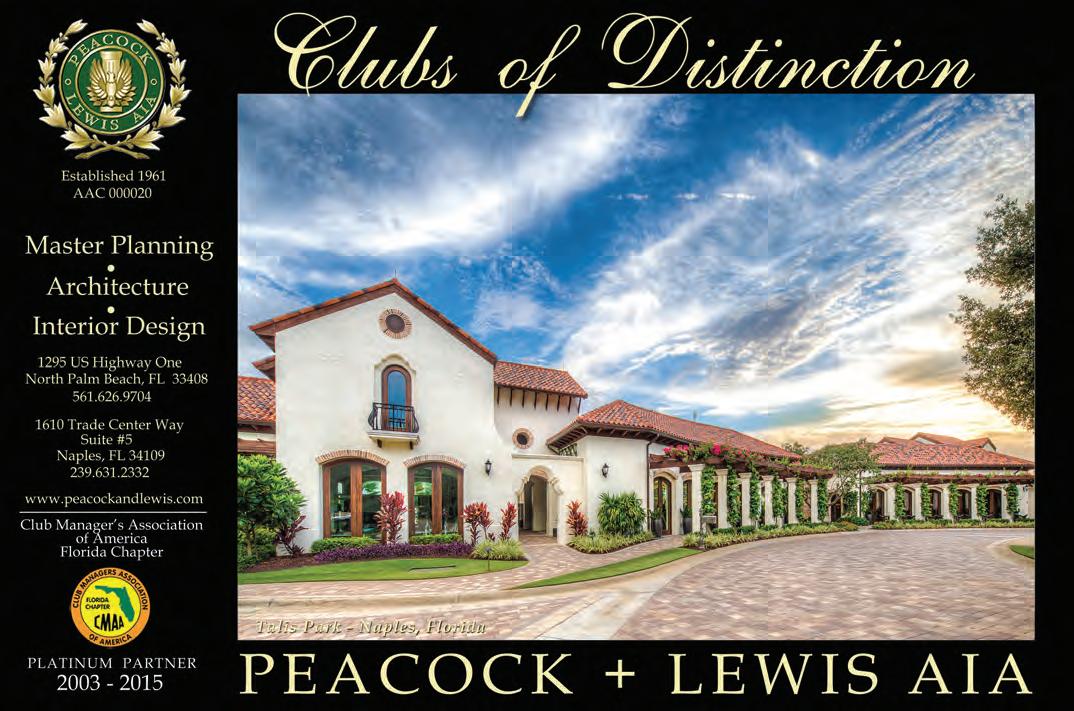

Many times golfers looking to improve their game will sign up for a golf lesson with their pro. And to be sure, there are times when golfers have wondered about their pro’s teaching philosophy, and who’s been teaching (or has taught) their teacher.
For Jim Hardy, rated as one of the country’s top 100 instructors, it’s been an evolutionary thing. Hardy with his philosophy, theories and teaching methods has certainly helped some of the best in the game become happier (and better) golfers.
Hardy’s ideas have developed over the years. In 2005 he published a book “The Plane Truth for Golfers”, postulating that there are two categories into which all swings can be divided and analyzed. The elements in each set of fundamentals work together to create the correct, repetitive impact for a golfer.
“The sole purpose of a golf swing is to produce a correct, repetitive impact. The method employed is of no significance as long as it achieves those goals,” Hardy explained. So once golfers understand their swing, how does a person develop an approach to make sure this correct, repetitive impact always happens?
That’s been the mission of Jim Hardy’s Plane Truth golf instruction. But Hardy’s investigation and teaching is also indicative of how professional teachers help their students, whether they be high handicappers or one of the country’s top pros.
“Teachers learn from other teachers and from experience by examining their own failures,” Hardy explained. “When hearing new ideas, you always need to keep an open mind to opposing views on teaching to your own. Do not be dismissive of them.
“If those ideas have gotten positive results, learn why. In examining your own teaching, never assume a failure was the student’s fault; always assume it’s yours. Failures occur when the instructor either has misdiagnosed the problem, didn’t communicate correctly or the information was wrong.”
So how do, or should teaching pros approach a teachinglearning program for each participant?
“Too many instructors assume the reason the student is there for a lesson is to change or remake their swing,” Hardy suggested. “In fact, the overwhelming majority of students are there to overcome a specific problem.
“It may be a big ball flight miss (hooking, slicing, topping, fat or thin shots, etc.), or lack of power, their short game or any similar issue. The instructor should first discover what
the golfer’s biggest ball flight issue is, what is causing it and how to correct it.
“A golfer should never have to change more than a maximum of two things to achieve an improved impact and ball flight. By doing this you are constantly improving a swing, not remaking it.”
Change, in many facets of our lives, including golf, can be daunting, but despite the ‘fear’ of lessons, teaching professionals can contribute to a golfer’s enjoyment of the game.
“Golfers fear lessons for two reasons: 1) change can be a fearful adventure, and 2) they believe they will get worse before they get better,” Hardy remarked.
“If the instructor can correctly diagnose the fact the student’s problem is ball flight and impact – not some individual unorthodox quirk the player happens to have in their swing – and immediately solve that problem, the results are positive for both the student and the instructor.
“Imagine how many instructors would have ruined Jim Furyk, Bubba Watson, Jack Nicklaus, Lee Trevino, Fred Couples (to only name a few) because they decided to attack an unorthodox element of their style instead of simply getting rid of the hook or push, etc.
“A student leaving a lesson hitting the ball better with only one or two simple things to look after is a happy student. One who leaves the lesson with a long shopping list of complicated items to look after, and hitting the ball worse, feels like a failure and that golf is too difficult a sport for them to play.
“We, as instructors, need to get off the train of swing shape perfection and accept that a correct and repetitive impact, regardless of how peculiar a swing may appear, is the sole judge and jury of our profession. When we do that, the more golfers we will help enjoy game,” he intoned.
“The fact is, happy golfers play more golf and spend more dollars.” And of course, that what all golf clubs want today…more happy golfers, spending more. BR
Jim has spent his life in golf as a player, instructor, author, TV commentator, architect, golf course owner and operator. In addition Jim has instructed and coached numerous PGA Tour players including Peter Jacobsen, Scott Piercy, Olin Browne, Duffy Waldorf, Tom Pernice, Matt Kuchar, Paul Azinger, Brad Faxon and Scott McCarron. Honors he has been awarded include PGA National Teacher of the Year, Texas Golf Hall of Fame and a 2015 Inductee into the World Golf Teachers Hall of Fame.
With a common goal of attracting a younger and more vibrant member demographic, many clubs are looking beyond the fairways and greens and earmarking capital expenditures for clubhouse makeovers.
The trend, ranging from a fresh coat of paint to complete remodels, is helping to update even the most classic and timeless properties.
While the old “country club” palette of emerald green, maroon and gold has been replaced with varying hues of blue, gray, brown and bronze, textures are appearing in wall paper, applied moldings, and embossed leather upholstery. There has also been a shift from traditional to contemporary seating with roomy surfaces and clean lines dominating where the wingback chair once ruled.
In the dining room, more conversational soft seating and bistro tables are appearing versus the standard, linen-topped square four-tops. Although fine dining remains a favorite at some clubs, wood and stone surfaces are modernizing the experience – and don’t expect to find many manufacturers still offering rollers on chairs.
Budgets can vary based on the scope of the project. As with residential remodeling, any space with plumbing – such as kitchens, bathrooms, and locker rooms – will eat up a renovation budget the most quickly, as will any effort that completely rearranges rooms and moves load bearing walls.
For $750,000, one club was able to completely renovate the dining room and bar, giving it an entirely new look and feel. This included all new furniture, finishes and lighting, as well as the addition of a state-of-the-art simulator to create a new pub amenity.
All new pool furnishings and a kids’ area complete with new jungle gym and basketball halfcourt were also added. They replaced tired and faded awnings, giving the exterior of the club a completely different updated look as well.
Another facility played off its very traditional look with rich saturated colors complemented by modern molding and wallpaper. With a $1.1 million renovation budget, new wood floors helped to retain a timeless feel, while the lobby and dining and banquet rooms were updated with pops of color, textured wall paper and all new furniture.
On a much larger scale, another club is about to embark on a $2 million makeover, which is serving a dual purpose of supporting the repositioning of the newly renamed facility within its market. With a scope that includes locker room and Grill Room and lobby renovations, the price tag also covers new paint and carpet throughout.
The 1980s look of columns and metalaccented moldings and polished marble soon will be gone. Walls and doors will be moved to expand the views from the front door all the way out to the 18th green at the back, slick marble surfaces will be honed to a matte finish, and stacked stone accents and uniquely shaped light fixtures will add texture and warmth to the space.
Clubs looking to take on a renovation would be wise to have a few trusted advisors on hand, such as a licensed and bonded general contractor, a talented interior designer who understands the vision and an architect skilled in private club remodeling.
Vendors who hold contracts with the club can also be a great resource.
Finally, a makeover of any scale can be challenging for both staff and members. Plan well, stay organized, and utilize the off-season for major construction.
Repair to deferred maintenance items can force expenditures in areas that nobody will ever see, which can make it difficult to justify (especially at member-owned clubs where a remodel results in assessments).
SEE CASE STUDY | 123
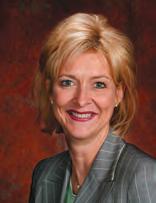


“We need to fill these Saturdays with business. I never see anything about what’s going on at the club on Saturdays. Chris, we need to do more marketing!”
Revenue numbers were strong, but the finance committee wanted to make better use of the Saturdays. As responsible financial agents of the club, the committee saw this as an opportunity for general manager Chris to get more business – a very reasonable and sound suggestion.
Though Chris believed that the logic behind the suggestion basically is sound, he felt that the proposed course of action ultimately was rather shortsighted. The finance committee had observed that there was little or no marketing for club events or outside activity.
However, Chris knew that exclusivity is a very important part of membership in a private club, and that advertising is often detrimental to the long-term success of the business for a variety of reasons, which would be challenging to explain to the finance committee. Chris needed to engage the committee to review the sorts of marketing activities most beneficial for this private club.
With a month’s lead time, Chris worked with Beth, the banquet coordinator, and Sally, the person in charge of club communications, who was also responsible for multiple other duties because it was very hard to convince the finance committee to earmark significant budget to a communications position.
The team worked on a presentation outlining specific activities used to both inform the membership and create interest in using the club for private events.
The first issue: What Saturdays are available? The team put together a chart showing the “unused” Saturdays over the past five years and the banquet revenues for each of those years. The chart showed a very nice progression of consistent year-over-year revenue increases.
The team agreed that keeping Saturdays open allowed for special revenue opportunities – the
revenues could certainly be improved. But the chart clearly illustrated the general principle, and showing the finance committee examples of revenue growth helped alter the perception that the Saturdays were not being utilized.
However, there was still no question that designing a marketing campaign to encourage Saturday events was a challenge for a private club. Because the team knew that the marketing it did for the membership was very strong, it decided to address this issue early in its presentation.
First, the team discussed the value of normal advertising, along with the issues that it caused for a private not-for-profit club. The team then presented each committee member with a personalized letter explaining the amenities the club could offer them, and inviting them to consider using the club for business retreats, golf outings, dinners, and other possible events.
These were examples of letters Sally sent out every week to encourage members to hold Saturday events at the club. Sally had mined the computer for information about which members were affiliated with which businesses, and individually contacted 10 different members each week to encourage them to plan events at the club.
Sally also shared this information with senior service staff that would follow up in person with these members to further emphasize the value of club events for themselves and for their businesses.
Fortunately the team corrected the misperception that staff did not do much in the way of marketing to the membership. Sally and Beth tag-teamed an overview of its marketing program. They showed that each member event went through a six-week marketing program tracked on an event whiteboard in the office.
A flier and “Week-at-a-Glance” (WAAG) email posted six weeks out started the process. The WAAG message went out every Wednesday with information about upcoming events, along with pictures, club news, and menus for the week.
Four weeks before the event, information was placed in the menus and a website flier created. At three weeks, the flier was reposted in the menus and placed in the check presenters; a link in the WAAG was also posted.
At two weeks, each of these marketing strategies was reinforced with verbal marketing: staff casually mentioning these events to members as they were serving them. Verbal marketing is a very friendly and personable way for staff to remind members of an event and invite them to attend.
In the final week before the event, the verbal marketing continued, along with the WAAG email reminders. Last of all, on the day before an event, a text message reminder was sent if the event wasn’t already sold out.
For example: “6 PM Tiki Party Tomorrow! Please call Beth for reservations at (408) 123-4567.” The text was a nice “last chance” for members who had postponed their commitment to an event.
After Sally reviewed the club’s internal marketing, she went over their “post-event” marketing strategy, describing how they post pictures that best capture the member’s experience the day after an event.
These photos, displaying the stunning venue and arrangements, are posted on the club webpage, WAAG, Pinterest album, and Facebook page.
They also capture the members having a great time, give attendees a chance to reflect on their club experience, and may cause members who didn’t attend the event to consider attending the next one. Sally and Beth made clear that with their solid six-week marketing program, no event slips by.
Bill, the finance committee chair, suggested that Facebook was an excellent way to showcase the club. Sally and Beth explained that the cub had two FB pages: one for internal member use, showcasing items such as pictures and stories of club activities, and a public page with only generic pictures of activities or group photos, where no members or guests can be recognized.
In the end, the finance committee was very pleased with the club communications and clearly saw that the Saturdays were being well-utilized. All it took was good communication. BR
Rachelle Reali is the director of member communications and MacDonald Niven, CCM, CCE is the general manager at La Rinconada Country Club in California and can be reached at (408) 402-7475 or via email: rreali@larinconadacc.com and (510) 4398522 or via email: macniven09@gmail.com respectively.



“Your employees come first. And if you treat your employees right, guess what, your customers come back, and that makes your shareholders happy. Start with employees and the rest follows from that.”
That’s a quote from Herb Kelleher, co-founder of Southwest Airlines. We can improve member satisfaction by improving our employee experience. So the question is: Are you focused on employee satisfaction?
Any successful business or club strives for happy customers and members as detailed in the book, “Raving Fans” by Ken Blanchard and Sheldon Bowles. But Hal Rosenbluth’s book, “The Customer Comes Second” based on the premise that happy and tenured staff members almost always lead to happy customers and members or “raving fans”, tells the true story.
Remember Abraham Maslow’s hierarchy of needs (the pyramid)? The foundation of the pyramid focuses on the most basic needs, moving up to the top and the most complex including our physiological, safety, emotional needs, self-esteem, and finally self-actualization or achieving one’s full potential.
Employers play an important role in fulfilling these needs. The employee must earn enough to support themselves and their families, be secure in their jobs and safe at work, have a feeling of importance, inclusion and teamwork, feel as though they are accomplishing and contributing, and believe that they are achieving their full potential by being entrusted and growing professionally. This applies to all employees, not just managers.
So how can you continue to improve and measure your employee satisfaction? Here are some key ideas on improving your employee experience.
Know your employees: You should know all of your employees by name. The best GMs even know the names of their employees’ children
and what is going on in their children’s lives. Who is starting college? Who is getting ready to graduate? Who broke their arm? Everyone beams when they get to talk about their kids. Show a genuine interest and you will receive loyalty and support in return.
Improve communication: Employees feel a greater power of inclusion and teamwork when they are informed about what is going on at the club including events, plans for the future and financials. Even when those decisions and operations don’t affect them directly, it certainly makes them feel included and creates a more cohesive team. Beef up your communication with all staff with a newsletter, email communications, team and clubwide meetings, etc.
Addison Reserve Country Club in Delray Beach, FL has a monthly educational newsletter that focuses on financial topics called “Finance in 15.” The newsletter shares updates on the latest financial topics at the clubs and includes learning points such as setting up a new vendor, coding invoices, the purchasing cycle, etc. Not only is this a powerful learning tool and improves operations, it also provides inclusiveness for team members.
Create teamwork across service lines: While each department should have excellent communications and be high performing within the department, how can you expand that team spirit across service lines? You are hopefully already conducting club-wide employee meetings and end of season outings to thank your employees for the work that they do.
Some clubs such as Atlanta Athletic Club have an Employee Wellness Expo where vendors are invited such as health insurance providers to talk about health and wellness, banks to talk about purchasing a first home and the importance of savings, etc. The club educates their employees on important mat-
ters outside of work as well work-related education to improve quality of life.
Measure employee satisfaction: Successful clubs normally use a group of standard metrics to measure the progress and success of their desired goals and objectives. The top two metrics, which often drive the rest, are high membership and staff satisfaction. Look at your turnover rate as one measure of staff satisfaction (we recommend separating voluntary from involuntary turnover).
Turnover rate is the percentage of employees in a workforce that leave during a certain period of time. To calculate monthly employee turnover rates, divide the number of employee separations in one month by the average number of active employees at the worksite during the same period.
Another measure of employee satisfaction is conducting ongoing employee satisfaction surveys. We offer a comprehensive employee satisfaction survey with ClubInsights or you can set up your own employee satisfaction survey through the many online survey services.
Some of the questions you should ask include, on a scale of one to 10, do they feel appreciated, do they feel that their opinions and input are valued, do they have the tools they need to do their job, are they being fairly compensat-
ed? Ask them for comments on each and be sure that it is an anonymous survey (or at least make that optional).
As Anne Mulcahy, former chairperson and CEO of Xerox Corporation said, “Employees are a company’s greatest asset - they’re your competitive advantage. You want to attract and retain the best; provide them with encouragement, stimulus, and make them feel that they are an integral part of the company’s mission.”
Focus on your employee satisfaction and measure it and your member satisfaction will improve as a result! BR
Lisa Carroll is a search executive and consultant with Kopplin & Kuebler, LLC, a consulting firm providing executive search, strategic planning and data analysis services to the private club industry. The company has offices in Scottsdale, Jupiter and Atlanta. Lisa can be contacted at (561) 596-1123 and at lisa@kopplinandkuebler.com.
John R. “Jack” Sullivan, a 40-year veteran of the club industry, is an associate with Kopplin & Kuebler, specializing in strategic planning and other private club issues with offices Naples, FL and Grosse Pointe, MI. He can be reached at (239) 229-5153 or at jack@kopplinandkuebler.com.


ROBYN NORDIN STOWELL
Generally medical and wellness facilities and services at 501(c)(7) tax-exempt clubs generate “nontraditional income” and have potential to generate “non-member income.”
Some clubs are on “high alert” but they are all interested in knowing if this possibly can work at their club.
What drives this interest? Today’s medical industry doesn’t necessarily deliver the desired services at the prices and locations and in the time frame some members want and, frankly, some club employees need.
This is an opportunity for clubs to offer something their members and employees see as a major value addition. Can your club do it and how do you do it properly?
First, many members recognize that U.S. medical care is based on diseases, diagnoses, procedures and medications – not necessarily health and wellness.
“The average doctor’s visit is seven to eight minutes,” says Dr. Ellen Lebow, medical director at Optimal Wellness Physicians at Turnberry Isle Resort & Golf Club.
In addition, many insurance plans do not reimburse for funds spent on prevention.
Why is this important? Because 80-85 percent of health status is dependent upon lifestyle choices. Heart disease, cancer and chronic lower respiratory disease are the top three causes of death in the U.S., and they collectively account for 50 percent of all deaths. But they are modifiable by lifestyle, according to Dr. Lebow, and are significantly impacted by nutrition, obesity, inactivity, smoking, alcohol use, and stress, all of which are tied to life choices.
Many club members are focused on wellness and the quality of life. Clubs are rightly looking at additional ways – beyond recreation and exercise – that they can provide some of what
these members and future members will demand.
Don’t forget your employees. If properly situated and managed, having easy, inexpensive (maybe subsidized) onsite access to basic health needs may save immeasurably on the club’s costs from employee sick day expenses – not just from employee who takes a full day off to visit the doctor, but also from employees who show up sick and infect coworkers and members.
“Presenteeism”, a recently coined term referring to workers reporting to work ill and not operating at their customary level of performance, is estimated to cost U.S. employers over $150 billion annually.
Can your club add wellness opportunities? First, it does not require an entire spa remodel or suite of rooms and offices to house a medical or wellness operation.
A club with limited space can offer a rotation of services that take turns using the few rooms available. It can be as simple as adding services that create a healthy, active, lifestyle environment for your members or as extreme as including personalized medicine, bio-feedback and on-call private physicians, says Tammy Pahel, president of Spa Management Solutions, Inc.
With more than two decades in the spa and fitness industries and having led development of 12 world class resort and club spas, Tammy says there are a number of ways to do this with the unique specifications of any property despite its size, square footage or budget.
So, what am I seeing? Medical and wellness facilities at clubs can cover a range of possibilities, from medical services offered in a distinct doctor’s office on site to a range of wellness practitioners and alternative medicines housed in the spa.
Clubs, particularly in retirement regions, are looking at their spa facilities because it is a place of relaxation that has available space that can function for added services such as healthy food, exercise programs, meditation, massage, client education, and much more.
Specific programming can include weight management, nutritional restoration, stress management, hormonal restoration, cardiac health, detoxification and sexual wellness.
Medical services can provide a concierge level of doctor relationship if desired, and/or can emphasize natural and bio-identical treatments: wellness consultations, nutritional management, hormone replacement and cutting edge diagnostic testing.
Medical team members may include those who provide chiropractic, acupuncture and oriental medicine, biofeedback, lymphatic drainage therapy, massage therapy, physical therapy and nutritional counseling.
So, what are the high level legal and tax issues to consider if your club wants to add these facilities? The club must identify a licensed physician partner to provide and supervise medical services and/or true wellness medicine.
There are a number of possible relationships that the club can structure with an outside provider, which can
limit club exposure to liability and reduce nontraditional income. The members can make payments directly to the provider and the provider can rent the club space.
The physician that runs this program and delivers the services must operate with medical malpractice insurance, general liability insurance and property coverage, just as they would in a traditional practice.
The club should be named as an additional insured and the lease should include broad indemnification of the club for any medical claims (be sure to review the club’s insurance).
If you provide employee access, the provider should accept the medical insurance the club provides its employees to facilitate the process and you should provide careful segregation to address confidentiality.
There are many issues to consider when adding medical and wellness services, and it may be worth the effort. BR
Robyn Nordin Stowell is an attorney with Sherman & Howard in Scottsdale, Arizona. Robyn can be reached at (602) 300-5326 or via email: RStowell@shermanhoward.com.
Dr. Ellen Lebow can be reached at (305) 933-6930 and Tammy Pahel can be reached at (702) 524-4505.


Sometimes the so-called ‘poor second cousin’ does win! And that’s the case with the tennis program at the Country Club at Mirasol.
The Palm Beach Gardens, FL club, a BoardRoom Distinguished Emerald Club of the World, has always been able to offer its members and guests a ‘golf experience’ but always hasn’t been so for the club’s tennis program…until recently.
“In 2010 our tennis members voiced their opinions…they saw themselves as second class members, so this really offered us the opportunity to make changes,” explained the Mirasol’s general manager Matt Lambert.
“Sometimes small details can turn into bigger problems and that’s something we wanted to avoid,” added Lambert. So The Country Club at Mirasol initiated the idea of a tennis concierge.
So far as everyone at Mirasol’s concerned, that’s made a huge difference. Now in its fourth season the tennis concierge has helped build the members’ participation in the tennis program, and the club’s revenue has grown strongly, both from teaching and tennis products.
In short, the tennis concierge is the club’s liaison with members, customizing and personalizing their tennis experience, something that cannot be provided by the pro shop staff or teaching staff alone.
“The key to success is recruiting the right people for this position,” Lambert suggested. “They need to have exceptional customer service skills, a warm welcoming personality, be a great communicator…outgoing and capable of marketing and recruiting, organized and proactive.”
And of course, anyone working the tennis concierge needs to have extensive tennis knowledge, the ability to play the game at a high level and also play ‘customer tennis.’

So the club hired Kristine Mendivil and Donna Schlockman…both active players with these attributes, to operate the concierge. The club’s tennis program hasn’t looked back.
“It’s allowed our club pro to stay on the court where he can provide the best service,” said Jeremy Barker, Mirasol’s director of sports who oversees the tennis program.
The tennis concierge staff will arrange games, fill in as needed with members’ play when someone is missing, and can handle daily issues, like court challenges that might arise.
“Having someone actively manage the daily court use allows members to play longer than the designated 90 minutes more often,” Barker explained. “By having our tennis concierge control the flow in real time enables us to maximize the course use and of course, it contributes greatly to our member satisfaction.”


Mirasol budgeted for the additional labor expense and witnessed a growth in the tennis activity revenue within the first year.
Prospective members can meet with the tennis concierge staff before joining the club and because tennis has a language of its own, the staff is better able to help perspective members make a decision to join Mirasol.
The concierge staff is the proactive in helping new members increase their participation through the promotion of events, socials, teams and championships. “It all brings a personalized touch,” Lambert ventured.
It also shows in the club’s member satisfaction score…the ratings of the concierges – for availability, knowledge, friendliness and being responsive to players’ needs – have grown steadily each year. And it’s also been a plus for the club’s bottom line. The club’s tennis revenue for retail, repairs, tournaments, instruction and teams has increased steadily since 2011.
“Obviously not all of these increases are related directly to the to tennis concierge’s role but it sure illustrates the growth an effective well-organized program can have,” Lambert concluded. BR


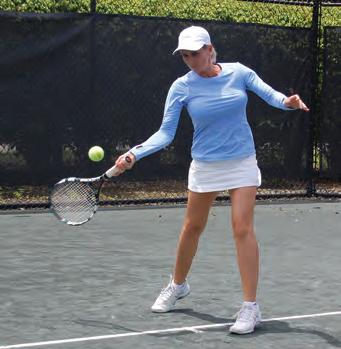




Revolution not evolution…That’s been the recent motto for San luis obispo Golf and Country Club, a BoardRoom distinguished Gold Club of the World. And it’s happened!
As recently as 2009, the club just wasn’t meeting members’ needs and something needed to be done, if the club was to survive. That became the genesis of the club’s revolution.
“We needed to fix the club, quickly,” explained the club’s general manager Mike Stanton. “We had been a typical golf-centric country club. With golf on the decline, the economy of 2009 and the demographics of our area, we couldn’t ignore what potential new members were looking for if we wanted to survive. And we just didn’t have the luxury of deep pockets to take our time,” Stanton cautioned. So the do-over began.
“The golf course was already in very good condition, but we had to overhaul the basics first…service in particular and upgrade our food. The next big decision was to become family-friendly… not an easy sell to all board members or members in general.”
But it has happened and today “I’d say we’re family-centric,” enthused Stanton.
The difference for the southern California club is huge, and “all you see when you go into this club is smiling faces,” touted John Fornaro, BoardRoom’s publisher following a visit to the club.
“As we attracted more families (and kids) some older members who had been very comfortable with a sleepy golf club did not care for all the activity and especially children running through the clubhouse,” explained Stanton.
“We encountered space problems with no really good way to separate families and adults in the grill at meal times. As the younger members began to request more activities like fitness classes and youth activities we did a lot of juggling of our existing spaces.”
Today there’s a new normal with kids around the club, and some of the old guard is benefitting as well from the change…in fact, many of them are taking their grandchildren to the club.
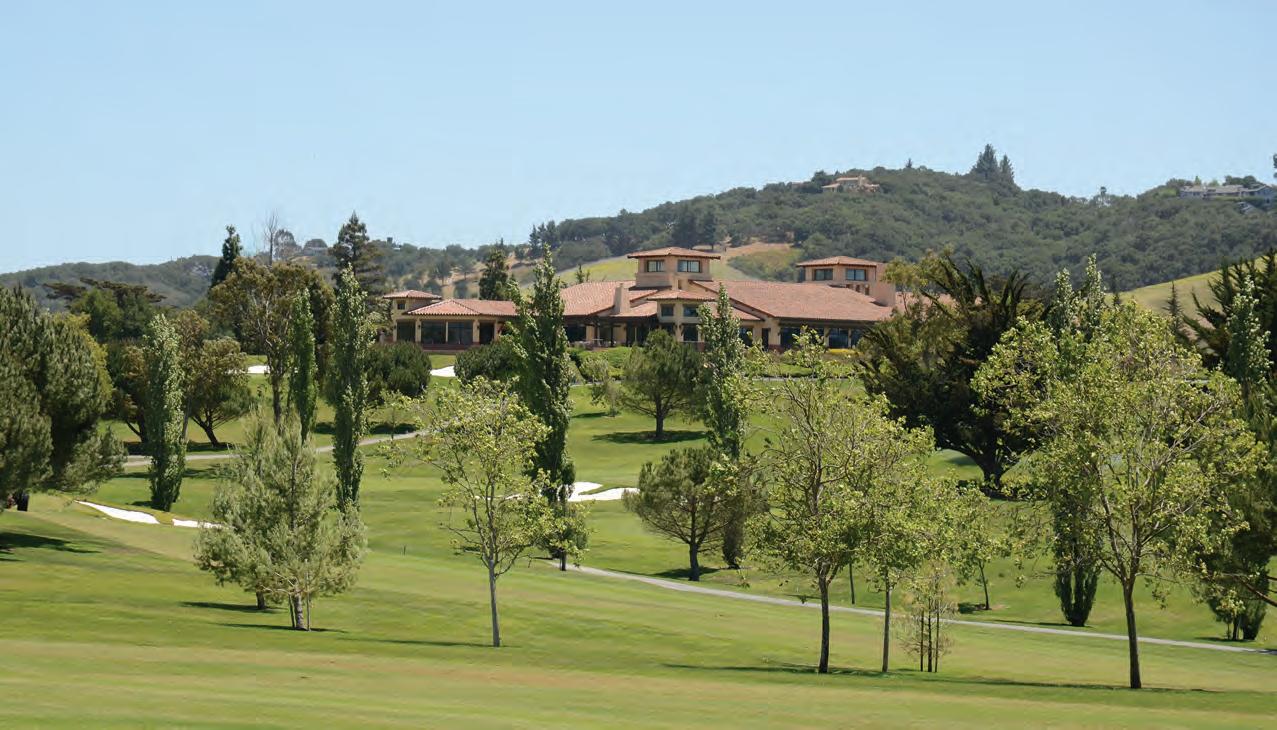
“The face of our club now is a vibrant, very busy family centric club. Interestingly enough the ‘old’ members who grumbled about the kids and dress code violations are still with us and more active than ever as we have added more programming for them as well,” Stanton commented.
The impact has been life changing. . San Luis Obispo this year, reached a capacity 468 golf members, up from 370 in 2010.
The total membership sits at 711, up from 485 in 2010 and revenue this year will top $7.6 million, an increase of over $2 million. This has allowed the club to significantly expand the club’s facilities, including a 5,000 square foot fitness center and other amenities.
“This all adds value to their membership,” Stanton added. Several membership classifications have been added, including a junior executive (under 37 years), fitness memberships, and senior memberships.
“We’ll now add an ‘equity pending’ classification to allow those on the waitlist to have access to the club. Our fitness membership waitlist is approximately one year, tennis membership is six to eight months and equity golf is about six months and growing,” Stanton enthused.
As many clubs across the country have discovered over the years, it’s not easy to change the culture of a club and have people embrace it quickly. However, San Luis Obispo Country Club has accomplished its revolution…very successfully.
“It did take longer than I expected but we are now known as a family centric country club with activities for the entire family. We have outstanding facilities that we are always looking to improve upon.
“We have multiple people coming through the front door every day to enquire about membership after being referred by another member. Winner winner!!” Stanton exclaimed. BR
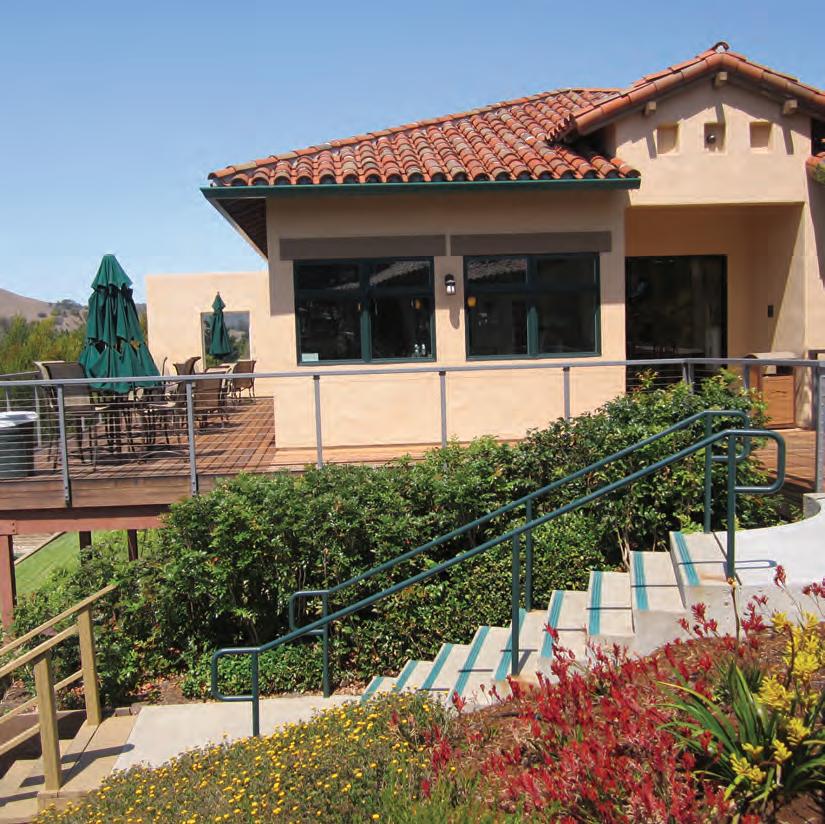



In a recent cartoon, there were two men sitting in a bar…one said to the other “I used to call people, then I got into emailing, then texting…now, I just ignore everyone”!
This really made me chuckle as it got me thinking about my own life and how much the communication with my family, friends and business associates has changed. I’ve realized that many people do not take calls anymore, especially my own kids.
Is the same thing happening in your members’ lives? Are they shutting down on the traditional means of communication, gradually tuning you out along with their family, friends and business associates? The tough question facing club executives is this: Are you evolving with your efforts to communicate or working against the trend?
With the Clubster App, members now have one place to check all their club information. The simple fact is, members want it all in the palm of their hand.
The Clubster App gives you a voice and now delivers this opportunity with incredible power and functionality.
While the list of technology-based solutions to keep your club running is crucial, most of these are behind the scenes…members don’t think much about them. However, in the area of club communications, there are some very interesting, new and exciting technology solutions your members will really enjoy and appreciate. Members want to communicate with the club and fellow members, but they want it short, easy and simple. Relying on members to go to the
club website or read the newsletter for information is yesterday’s answer. I’m convinced that the solution today is social media on smartphones and tablets.
Many clubs have tried using Facebook and Twitter as tools to communicate. These do have some benefits, but these public platforms also carry along real privacy concerns in an industry where privacy is paramount. So, let me introduce you to Clubster, a truly private social network, created as a solution for the private club industry. Clubster provides your club with its own private mobile communication platform offering a flexible and effective way to share club news, course updates, events, links, documents, messages, photos and video in real time. Clubster is a native app, available for iPhone and all Android smart devices.
Only those members of a club who are “invited” to access Clubster can view the information from and interact with their specific club. Clubs and members feel comfort knowing that information stays private and cannot go “viral.” Clubster navigation tools, ease of use, content controls and security features are exactly what club management and members are looking for in a communication tool. The continued growth of Clubster is validation that a truly private social network represents an important trend in the way private club members share, learn and connect with their club and fellow members.
With the Clubster App, members now have one place to check all their club information. The simple fact is, members want it all in the palm of their hand. The Clubster App gives you a voice and now delivers this opportunity with incredible power and functionality. For a short online demonstration, please contact Brooke Price at Clubster, (800) 800-5509. BR
Donald N. Williams is the CEO of ClubTec and Clubster. For more information, please contact him at (800) 800-5506 or by email at dwilliams@clubtec.com.You can also visit our websites – www.clubtec.com or www.clubster.com

“For a list of all the ways technology has failed to improve the quality of life, please press three.”
~Alice Kahn
Technology gets a bad rap in life; when it is functioning perfectly, you don’t give it a thought, but when something goes wrong then all hell breaks loose. When I co-founded Northstar over 13 years ago, it was the melding of two passions of my life – technology and enabling to make life a little easier and more enjoyable for people.
We at Northstar Club Management Software have always been proud of being on the forefront of technology but it was never technology for the sake of technology alone. The Northstar software is built and designed specifically for the club industry – with just one goal in mind “to ensure clubs get the best technology that is user friendly and enhances the member experience.”
There are many software companies in the private club market – all claiming to be fully integrated with real time data. I can state with utter confidence that Northstar Club Management Software is the only club management software in the market that is built on a single database – what this means is there is no need to integrate since the software is built as one system.
Points of integration are the talking points between two systems and generally tend to be weak points where failures can happen, especially when changes are made to one system and the links get misaligned. By having just one system, we have eliminated these weak links and have a more robust system that the user can rely on to get the job done.
Northstar Connect, the new and improved website product, is another example of technology enhancing the user experience. The Northstar website is a fully responsive website
and enables club staff and members to access the full functionality from any online device be it a desktop, laptop or mobile phone, regardless of location. Members can now make dining reservations from the golf course and make their tee time reservations while sailing on the yacht!
Northstar Club Management Software is constantly evolving and we are adding new features and modules to increase productivity and provide the tools that enable member services to be taken up another level.
To this end, Northstar introduced the Stream Alerts which lets a club employee know if it is a member’s birthday or anniversary or if the member has returned to the club after an extended absence; customized personal calendars enable the member to see activities at the club that are of interest to them while the recently launched Grab-N-Go module offers members convenience to quickly place their food orders be it from the locker room or pool when they are on a tight time schedule.
The Northstar mission is to provide a superior product that helps create the best member experience. To this end, over 150 employees of Northstar are working diligently to improve the software, better the customer service and to ensure that the users of Northstar have a worldclass experience. BR
This article was submitted by Prasad Suryadevara, founder and CEO of Northstar Technologies Inc.For questions, contact Prasad at prasad@globalnorthstar.com or at (888) 240-3501.
For more information about Northstar Club Management Software, please visit www.globalnorthstar.com.
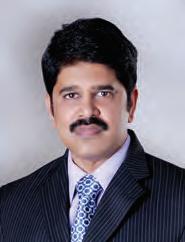


At clubsystems group, we strive to be your technology partner for life by providing responsive and reliable support, extraordinary professional services and product development for the long-term.
In keeping with the Software for Life mission, 2015 has seen the release of many innovations to the comprehensive solutions offered by clubsystems group. Susan Lyle, president of CSG relates, “One of our annual projects is to reach out to clients to see how a particular product can be enhanced. Teams of employees are tasked with researching customer suggestions to better understand how modules currently function, and how they can be improved. Ideas are presented and the
CSI GlobalVCard specializes in digitizing the accounts payable process, taking what was once a check-based process and bringing it into the 21st century. By replacing hand written checks with a onetime use MasterCard® to pay vendors, the GlobalVCard platform is able to significantly streamline the AP process.
resulting efforts create a focus for future enhancements and improved customer processes that will have the most impact on our user’s day to day operations.”
Anne Connolly, club controller at Chartwell Golf and Country Club comments, “This is a great way to get staff to accept each other and work together.
“Coming up with software improvements that would benefit myself and other clubs makes me feel that I’m part of the solution and an integral voice for ideas.”
In response to our inquiries, many of our accounts payable clients were specifically seeking a more efficient way to pay their vendors. Susan Lyle continues, “When reviewing the CSI GlobalVCard solution, we realized what a significant benefit the cash back rewards could be to our clients – on top of the convenience of a secure method of payment.”
CSI GlobalVCard specializes in digitizing the accounts payable process, taking what was once a check-based process and bringing it into the 21st century. By replacing hand written checks with a one-time use MasterCard® to pay vendors, the GlobalVCard platform is able to significantly streamline the AP process.
The integration between clubsystems group and CSI GlobalVCard is offered to CSG clients free of charge as part of the Software for Life policy, and is already helping clubs digitize their AP Process. One early adopter of the platform was Diane Hatzis at the Golf Club of Purchase.
As a controller, she is a proponent of the digital AP platform, and specifically, the cash back rewards the club now earns as a result. Diane said, “My AP process hasn’t changed, but now I’m getting cash back for it. Money coming back into the club is always good money!”
With a focus on adding value for clientsnot just through software but also the proven services and industry partnerships we develop - it is the primary goal of clubsystems group to continue offering new solutions which benefit the entire club.
By following our Software for Life mission, our experienced team and innovative products will ensure for the continued success of your club. BR
Susan Lyle is president of clubsystems group based in Hatboro, PA. clubsystems group specializes in innovative software solutions to improve member services in the club management industry. Contact Susan Lyle at (800) 356-4242 or via email at slyle@clubsys.com. www.clubsys.com



Club food and beverage operations are among the most complex of any type of foodservice organization.
Because of this complexity, club management systems typically include only rudimentary F&B inventory and procurement capabilities, leaving a rather large hole in the accounting system. This hole is usually filled with spreadsheets, manual processes and sometimes stand-alone software utilities like recipe costing programs. If F&B revenues represent 30 percent of the club’s total revenue picture, then the hole represents a lack of strong control for 30 percent of the club’s business.
The FOOD-TRAK system completely fills the hole, replacing the need for myriad spreadsheets and supplemental systems. Requisitions, transfers, competitive bidding, ordering, receiving, inventory, central storage control, recipe costing, menu analysis, nutrition reporting, item usage variance tracking – in short ALL aspects of food and beverage management are handled in a single system that integrates electronically with all the related existing systems. And filling the hole typically results in a savings representing four to eight percent of total F&B revenue – all of which ends up on the bottom line. For each million in F&B sales, the ROI is at least $40,000 annually..

With over 35 years of constant innovation and expansion of the system, the FOOD-TRAK System is specifically built to handle complex operations. We have also learned how to properly implement the system by building the databases ourselves, and then training and transition existing staff in its use. We design and implement customized business process flows that take full advantage of the system’s capabilities for each client, providing accurate reports, data transfer integration with existing accounting, POS, distributor ordering systems and catering systems, while reducing labor at the same time.
Our clients have been able to consolidate procurement processes so that fewer people can commit club funds. They have been able to accurately track menu item costs and performance, and identify variances in food and beverage usage. They gain checks and balances for receiving, inventory and culinary control. They no longer rely strictly on a talented food and beverage director or chef to determine the proper operation of their club’s food and beverage department. That’s where the savings we mentioned comes from. Savings remain consistent and drop directly to the bottom line, reducing the need for subsidy.
On top of the F&B savings, our clients reduce labor through the use of scanners, pads, cell phones and other mobile devices which make it possible to collect data at the source. In this more mobile-centric world, staff members love the idea of using these devices to eliminate paper forms. With this approach, critical management information is instantly available in real time, making it difficult for costs to get out of control, only to be discovered when the statements are run at the end of the month.
There is no question that the FOOD-TRAK System is an investment, more expensive than stand-alone recipe systems, liquor control systems, basic inventory and procurement systems. But these piecemeal approaches are typically self-implemented and few integrate with existing systems. As a result, the overall impact is typically far less significant than a professionally implemented, fully integrated system can ever be.
And thanks to the cloud, we can now offer our system at a much lower upfront cost, eliminating the need for servers, updates, backups and other IT-related tasks. Now even mid-sized clubs can afford the capabilities our large club clients have enjoyed for years. Perhaps the time has finally come to fill the hole in the accounting system. BR
Bill Schwartz is president of System Concepts, Inc. (SCI). Based in Scottsdale Arizona, SCI specializes in F&B procurement and inventory management, and is the developer of the FOOD-TRAK Food and Beverage Management System. Bill can be reached at (480) 951-8011 or bills@foodtrak.com.












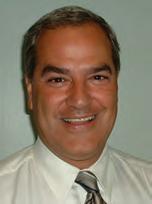




These top executives have taken their clubs to a higher level by implementing a better approach for managing club food and beverage departments. Building on a foundation of best practices, checks and balances, and integrated business flows, they incorporated leading-edge food and beverage automation and reduced labor by tying all their systems together.
The controls, disciplines and reports produced by this approach make it possible to run food and beverage departments at peak efficiency, substantially reducing clerical labor and food costs. Innovation. A better way to do business
Just what you would expect from leaders at this level.




The other day I overheard a conversation where a man was enthusiastically telling his friend about his new smart watch.
His friend proceeded to ask “Yeah, but what does it do that your phone can’t?” His response was “Lots of stuff! I don’t know. I mostly use it to tell time.”
His response made me laugh, but also made me wonder how much he was missing out on. Not because he didn’t have the right tool, but because he hadn’t invested the time or interest in understanding what it was capable of helping him achieve. The most successful clubs are the ones who understand investment comes in two forms – investment in things (technology, infrastructure, etc.), and investment in people. Yet so often, clubs choose to overlook the importance of investing in their employees. More accurately, they choose not to invest in the expertise of their employees.
When asked about this idea, Rob Martin, clubhouse manager at Wycliffe Golf & Country Club commented, “During my career, I’ve seen a lot of clubs who just don’t utilize their software system to its fullest potential. Most probably take advantage of less than 20 percent of what the system can actually do.” Martin continued, “We recognize that technology in the club world is advancing quickly, and we’re committed to doing everything we can to stay at the forefront of that advancement.”
Located in Palm Beach, FL, Wycliffe Golf & Country Club is building on its existing success with a revitalization of its food and beverage program. Their plan includes the addition of a new dining venue, new kitchen talent, and an indepth marketing program designed by Brad Lieberman to excite and entice members.
As Martin puts it, “Food and beverage is a primary amenity at Wycliffe, and we’re trying to maximize this revenue stream. That’s why we’re so aggressive with our professional development program. A well trained team means we can enhance our service performance and create a better experience for our members.”
Wycliffe Golf & Country Club makes continuing education a focal point, and emphasizes employee engagement through their professional development program. In late July, Wycliffe’s food and beverage cost controller, Sammy Tebib, attended a Jonas Club Software training seminar. The full day session highlighted new features designed to help create a more personal and memorable experience for Members. “I’m very excited to implement the new features within the Jonas Club Management system. I’m confident it will take our service levels to new heights,” Tebib said.
Attention to detail and overall member service are at the core of why Wycliffe Golf & Country Club focuses so much attention on continuing education, and by ensuring their staff attend live sessions, the club sets the bar high. However, for clubs seeking lower cost alternatives or programs offered in smaller doses, there are no shortage of options.
A multitude of educational opportunities are available to Jonas Club Software clients including an online knowledge base, monthly webinars, video instruction and more. All of which is in addition to our yearly user group sessions which take place throughout North America and the UK.
As more and more clubs turn to their technology investments to help enhance member experiences, so too are clubs recognizing the importance of ongoing education and professional development for their employees. After all, having the best tools in place doesn’t mean much without the expertise to make the most of them. In most cases, all that is needed to optimize your initial investment is a little time and interest. The result, in the long run, can be a whole new experience for your members. BR
Jim Fedigan is president of Jonas Club Software based in Markham, Ontario Canada. Jonas Club Software provides fully integrated, customizable, enterprise management software solutions to the club industry. Contact Jonas Club Software by visiting www.jonasclub.com, emailing sales@jonasclub.com, or by calling (888) 789-9073.


BY JAMES COBALT
As clubs transition more to digital, some of the most common concerns we hear are on the effectiveness of emailed newsletters.
For the past five years at MembersFirst (plug time: an award-winning agency and web developer for clubs), I’ve had the honor of working with some of the most prestigious clubs in America… but even they are occasionally guilty of the most egregious email newsletter practices. Here are some common transgressions – and how to fix them.
1. MeMBeR eMAIl FATIGue
If I had a dime for every email a member receives from their club, I’d have enough money to pay their dues and F&B minimums. Email frequency and read rates are negatively correlated; the more you send, the less engaged your members will become.
Solution: Consolidate your content to no more than one big email a week. If you can pull it off, newsletters sent every two weeks are sometimes better. Send smaller, targeted emails only as necessary to fill in the gaps. Urgent golf announcement? Send to golfers only – not the pool membership.

2. non-ReSponSIve eMAIl
According to a study by Litmus, in 2011 just 8 percent of emails were read on mobile devices, but by early 2015 that figure reached 53 percent. Yet, clubs still send emails as though everyone is on a PC. Too often, members receive multi-column emails with tiny text and tiny links that are too much of a bother to engage with on a tiny touch screen; they’re likely to be deleted or ignored rather than read later on a desktop.
Solution: Responsive email templates change the size and layout of your newsletter content based on the member’s screen size, ensuring it’s easy to peruse regardless of device.
3. oveRWhelMInG
While a member may sit in their favorite lounge chair and flip through a printed version of your newsletter during downtime, digital versions are usually read while processing their inbox. They don’t “read” emails any more than they “read” web pages - they skim to find what’s relevant or interesting and then click through to get to the full content.
Solution: A good email designer understands your newsletter needs to transmit your brand, announcement headlines, and calls to action within the 15 to 20 seconds the average person spends looking at a non-work email. Treat it like a table of contents for your site; not the site itself.
While a minority of members may prefer getting a tome delivered to their inbox thrice weekly, or having double columns on mobile, best practice data makes clear what needs to be done to improve engagement with the majority: combat email fatigue, ensure good mobile compatibility, and treat the newsletter like an index to the content on your website.
Need help? I happen to know some pretty talented designers… Get in touch at EmailDesigners@MembersFirst.com BR
James Cobalt is the Senior Marketing Manager for MembersFirst, an award winning agency and provider of web-based club software for online reservations, tee times, and account statements.



There is a shift occurring in the mindset of those managing private clubs.
The dated outlook of technology only creating distance between members and their club is beginning to crumble as the latest online and mobile booking trends inspire the member of today. Not only are members demanding this from their private clubs, but the newest technology is providing the kind of personalization that members desire — the ability to define their own experience.
The member of today wants more choice. As a result, private clubs are becoming more horizontally complex in terms of their offerings to appeal to a wider market of members. Access to golf, activities, classes, spa services, lessons, lodging, retail, dining, events and more, are amenities being presented in a new class of private club memberships. More choice means that

clubs are now looking for ways to simplify the planning and booking process for their members to ensure they are using all facilities the club has to offer and remain engaged.
While older members may still appreciate calling or visiting the pro shop and speaking with a live person to book their next tee time, the new generation of members may only find the time to plan their next round between meetings or long after the pro shop has closed for the day.
The one constant in this generation’s busy, everevolving world is their fixation on having up-todate information via access to the online world.
While the new generation is the main proponent for the use of mobile technology in private clubs, the demand is increasingly drawing from all age groups. In the second quarter of 2014, according to a monthly survey conducted by Neilson of 30,000 plus mobile subscribers over 13 years of age in the United States, while an unsurprising 86.2 percent of 25-34 year-olds owned a smartphone, 70.8 percent of those aged 45-54 and 46.3 percent of those aged 65 and over, also carried smartphones (Neilson, 2014). That’s nearly half of all Americans over the age of retirement, and an even split across the board between men and women.
Members want to feel a connection to their club, and since more members are connected to their wireless devices than ever before, creating self-service access to online and mobile booking of tee times, services, classes, lessons and the ability to view details about their membership and statements is key to member satisfaction and retention. Giving members the power to define their own experience not only allows them to personalize their own experience, it also leaves club staff available for more face time with their valued clientele.
Personalization via online and mobile engagement is the new expectation across your entire membership, across all generations. Clubs that deliver on this expectation will see their clubs thrive with strong engagement, strengthened loyalty, member growth and solid retention. BR
Frank Pitsikalis is founder and CEO, ResortSuite and can be reached at (416) 259-0715 x 2010 or via email at frankp@resortsuite.com.
References: Mobile Millennials: Over 85% of Generation Y owns smartphones, Mobile. (2014, September 5). The Neilson Group. Retrieved from http://www.nielsen.com/us/en/insights/news/2014 /mobile-millennials-over-85-percent-of-generation-yowns-smartphones.html



Your members are your customers… and your livelihood. Some are at the club now. Most are not. Your job is to reach out to all those people wherever they are… and get them more involved and more enjoying the experiences at the club – now and always. The good news is that almost all of them have equipped themselves with a perfect tool to accomplish this goal – their tablet or smartphone. Just provide a tailored app that allows you to reach them… and them to reach you. Your own “concierge” in their hands, providing information about what’s going on at your club or resort, promoting your events, telling them what is being served in your dining areas today, allowing them to make reservations for tee times, dining, fitness, tennis, rooms, activities… and buy things. Your concierge app allows them to submit requests, comments or questions…and to get personalized responses. Give them instant rewards for their participation. Reach Out with Concierge. BR
Butch Lesniak is president of Abacus 21 and can be reached at (800) 544-7310 or via email Butch@Abacus21.com


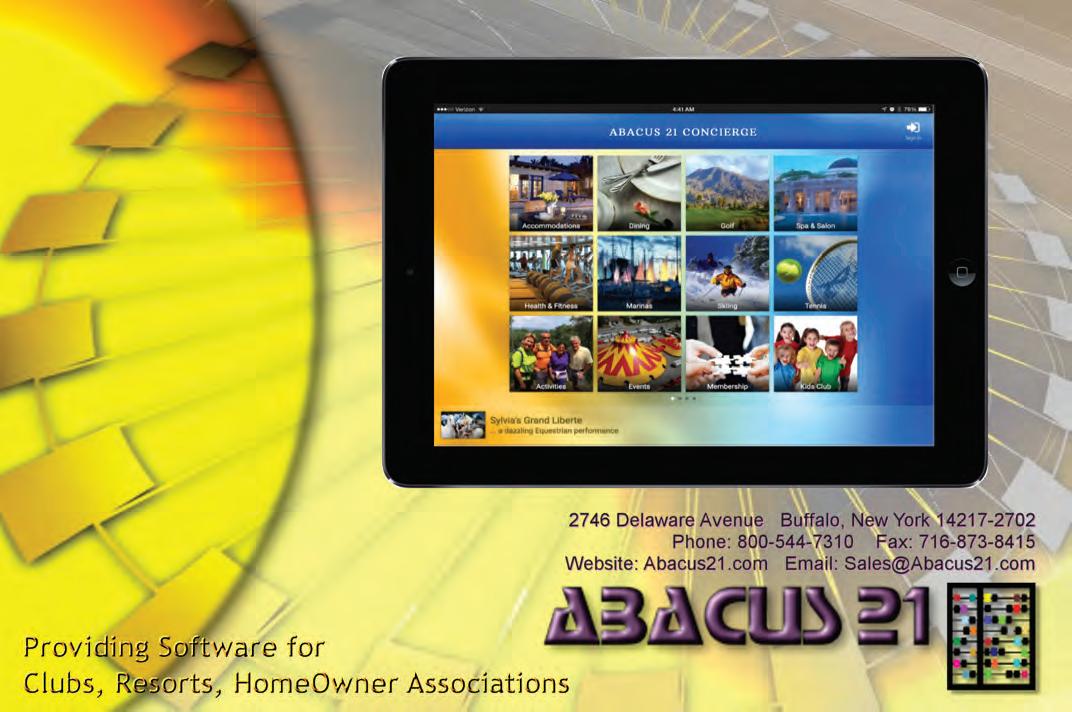

We all know there are many key elements to operating a successful business: knowing your market; knowing your demographics; knowing your product, and so much more.
But in order to get to such success, you often need to dig deep into your club’s day-to-day operations and be aware of sales patterns and member expenditures and activities. In the world of software, they call this data mining. At Buz Software we like to call this a stepping stone for further success for our clients; and we have been at the forefront of providing data mining capabilities since 1997, continuously assisting clubs with data mining tools.
Let me give you an example. At a recent Buz Software user’s group meeting, Steve Ducat, a client from Rideau View Golf Club in the Ottawa, Canada area, approached Buz Software president, Howard Stulberg to develop a custom report that would allow Ducat to detect member spending and facility utilization patterns. This was crucial to a hypothesis that Ducat had that intermediate members provide the club with as much or greater monetary value per round than the club’s senior members, even though the intermediates
pay lower membership fees. He believed the 20 and 30somethings in the intermediate category tended to spend more money in the food and beverage operation as well as the pro shop but didn’t have all the facts to prove it.
From this request, the Buz Software development team came up with the concept of the Member Engagement Timeline, a simple graphical view of member activity and spending over time that allows the user to compare different groups within the club based on tee time use, F&B spending, retail spending and so forth. Comparisons can be made by member category or even by member, and the timeline can be as granular as daily or as high level as annually. Buz Software is confident that Ducat will acquire all of the information he needs to help him, and his board of directors, make informed decisions and improve sales and profits for the club. In the future, Buz Software looks forward to leading the way in data mining to help our clients dig for gold! BR
For further information on Buz Software and their Data Mining products please contact: Howard Stulberg, president, Buz Software, at: 1 (888) 294-9015 x 706 or via email: hstulberg@buzsoftware.com



The latest version of our Cloud Software can be run on a club’s in-house file server, hosted at the CSI data center or hosted at a facility of your choice.
• Update our software to utilize the latest technologies.
• Reduce the club’s IT costs by eliminating Windows applications from our software.
• If you do host your server with CSI, we will take care of upgrading your server every five years.
• You will be billed a monthly lease fee for your server.
• We are a MS SPLA, which means we can lease your server software to the club, cutting down on up front costs every five years. This
also means if new server software comes out and we need to upgrade it, there is no charge.
PREVIEWING AT THE EXPO
Club Software will introduce a new Cloud POS designed exclusively for any tablet the club prefers. We feel when you can set up a POS unit in five minutes and spend $400 on a quality product; it’s an unbeatable offer! The new Cloud POS will offer electronic signature capture and which then uploads the ticket with the signature to the club’s website immediately. BR
Terry W. Hackett is president of Club Software Inc. based in Atlanta, GA and offices in Dallas, TX. Terry can be reached at terry_hackett@clubsoftwareinc.com or visit www.clubsoftwareinc.com
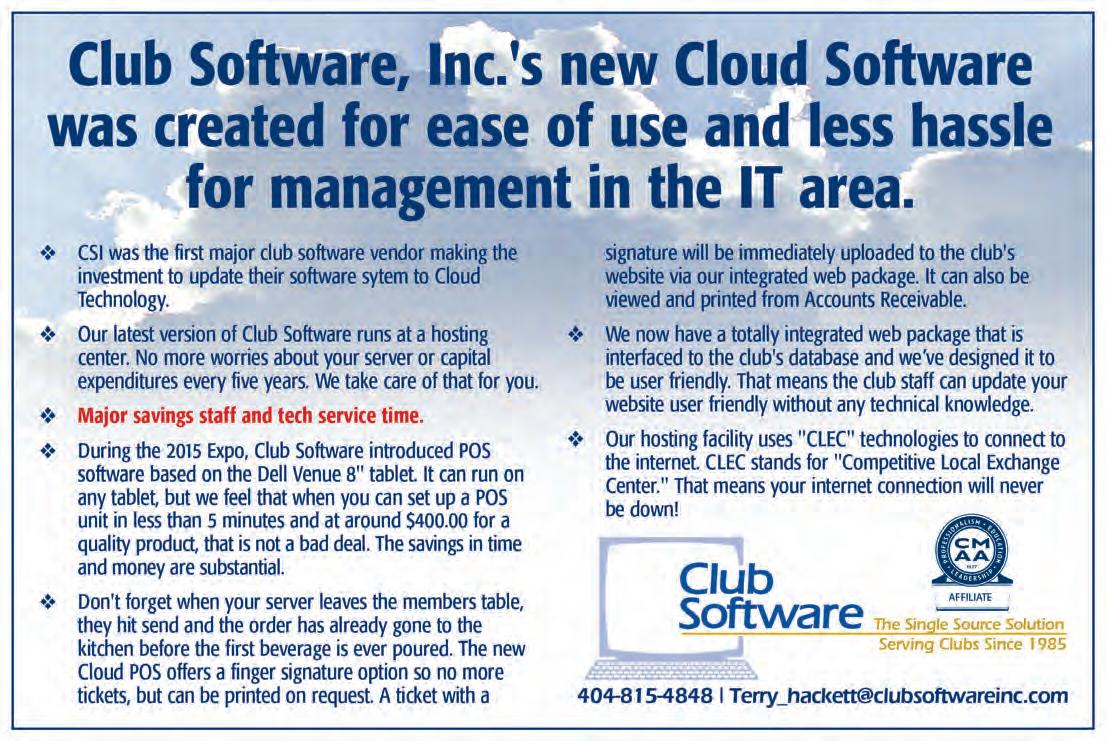

Catering to a select group of members with exceeding expectations, and keeping their participation engaged at the club is no short order.
On a basic level, clubs compete on reputation, facilities and service. The common denominator being your club’s best competitive advantage, and for most clubs the biggest expense, your employees. Unlike other work environments, many clubs do not have the resources of large corporations to confidently face evolving regulatory compliance and are finding liability for non-compliance costly. IRS reports up to 40 percent of small businesses processing payroll in-house are fined for inaccurate returns, plus wage and hour violations can easily run tens of thousands of dollars. Avoiding loss is actually gaining profit.
However, some administrators fear outsourcing payroll means loss of functionality, control, or access to their own data.
This fear was realized for River Bend Golf & Country Club when their payroll provider was unable to meet functionality needed to streamline their payroll processes. They needed an integrated Payroll and HR service solution that
could support Jonas Software integration, flexible reporting, and provide exceptional live support training. ClubPay delivered on each of these needs.
ClubPay’s outsourced human resource solutions, benefits administration, and web-based payroll processing tools has simplified these processes for River Bend Golf & Country Club, offering flexibility and control over this part of their business operation. Assuring compliance protection, allows River Bend to confidently manage their club employees without the administrative hassle.
“Since streamlining payroll with ClubPay, we have quicker payroll time and less headaches” says, Asst. Controller at River Bend Golf & Country Club, Great Falls, Virginia.
From pre-hire to retire, ClubPay streamlines operations with a custom suite of outsourced HR and Payroll solutions configured to meet your club management needs. Learn More: www.clubpayroll.com BR
Christine Fox is marketing coordinator, ClubPay and can be reached at 1-877-729-4258 or via email info@clubpayroll.com
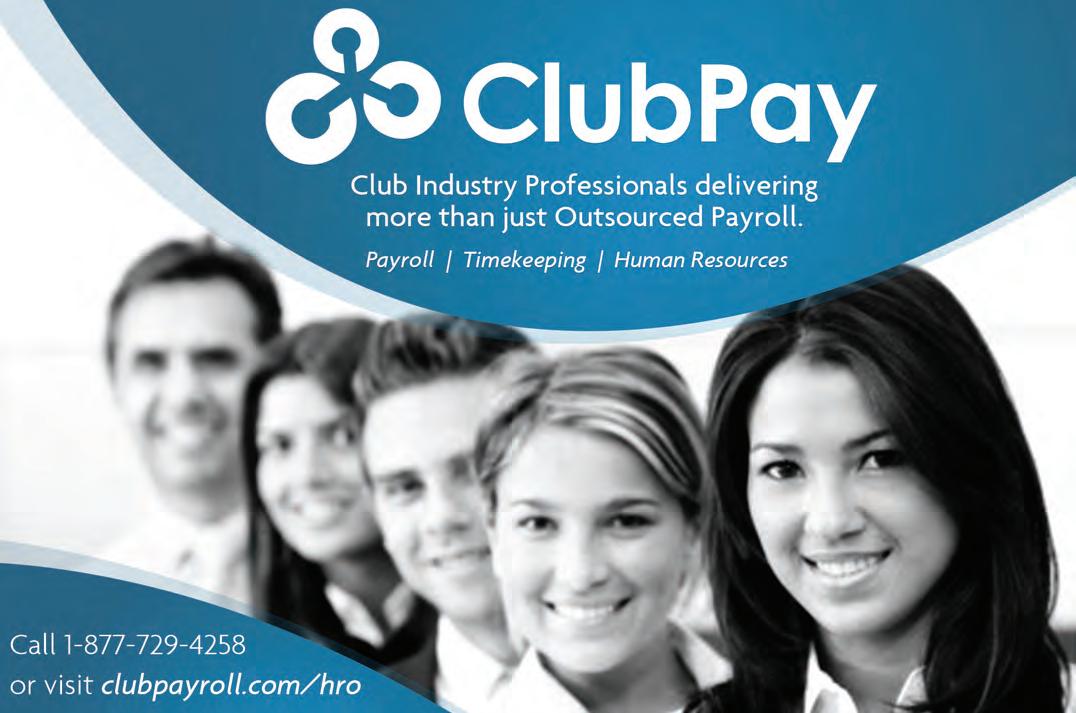


1. Extend asset life: One of the key benefits to increasing your preventive maintenance is extending asset life. It’s the equivalent of changing the oil in your car to save you from replacing the engine. Having to pay to replace a major piece of equipment is costly, and not to mention inconvenient to your members who experience the downtime.
2. Reduce costs: Reactive maintenance costs at least twice the amount of preventive maintenance, plus takes longer to complete because the problem may be more extensive. Preventive maintenance also saves money because it helps equipment run at peak operating efficiency and studies show this can save you 12 to18 percent on your energy bills.
3. Improve member satisfaction: The maintenance team can catch problems before they are catastrophic failures and fix them before they affect your members. This minimizes complaints and allows employees to perform their jobs to ensure your club is running smoothly without interruption or trouble.
4. Reduce liability exposure: Your staff and members are using your facilities every day; by having a preventive maintenance program in place you are not only helping ensure their comfort but more importantly their health and safety. If any liability issues were to arise within your facility, it’s important to have documentation that proper preventive maintenance work and inspections have been performed.
5. Maximize staff: Your people are one of the club’s greatest assets and through preventive maintenance you can more efficiently use your maintenance team. A proper preventive maintenance program equals a more structured day for the team and less time spent responding to crises. They know where to go and can plan the most effective route to get work done. Managers anticipate upcoming work and can ensure needed parts and employees will be on-hand to complete jobs. BR
Kate Donnelly is marketing programs specialist at FacilityDude and can be reached at (866) 455-3833 or via email: kate.donnelly@facilitydude.com


LED Lighting saves between 50-85 percent of the lighting cost in a club, so it’s become an attractive way to reduce expenses.
However, finding the right LED lighting solution for every lighting application in your club presents an incredible challenge, as the right products are not easily found in typical purchasing channels. The other challenge is that the manufacturers don’t provide products for all the club’s applications that are the best fit for the club.
We found that while one manufacturer makes a great lamp for a chandelier in the main entrance to the club, they may not have the best LED solution for replacing a fluorescent lamp in the kitchen.
You can try to buy LED on your own, but you are most likely NOT going to have a successful outcome. With high, medium and low output options, varying brightness, beam angles and light temperatures, the bottom line is, if you’re not in the LED business, you’ll most likely make mistakes.
When you buy from a retail outlet, you also get residential-grade products. After all, there is a reason they call it “Home” Depot. Commercial-grade LED’s have a longer life and better components.
The other common mistake on buying LED is going for the cheapest. All cheap LED’s we have seen have high failure rates and therefore wouldn’t qualify for utility company rebates. In the long run, they become more expensive if the prematurely fail, and more importantly, the net-cost of a more expensive rebate qualified lamp is less expensive by using commercial-grade products.
Using a professional company is paramount in finding the right solution, administering the rebate applications, procuring the right products, installing them correctly and servicing warranty issues. Let us know how we can help!
Nelson A. Scott is COO of SES Lighting and can be reached at NScott@SESLights.com or (855) 594-4878 x703
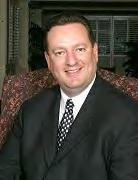
NELSON SCOTT


BY MICHAEL SPARKS
Times have changed and mostly for the better. The convenience and efficiency improvements in clubs made by technology allow you to do more, with less effort and greater savings than ever before.
Members have come to expect the same level of service, if not greater, than they do outside the club and technological changes allow you to deliver. Additionally, your ability to communicate to your members has increased with the availability of more delivery options.
As you expand the ways you communicate, don’t forget to bring your in-club communication up to date. Digital signage, when done right, will not only increase the effectiveness of your communication efforts, but also allow you to carry your heritage into the future. Quality design, classic presentation of displays, and integration with existing communications make digital signage a good fit for the club environment.
Clubs that have moved into this new era of communication are enjoying benefits that go well beyond their
expectations. Members have become more engaged with the clubs and rely on digital signage to keep informed.
Marketing personnel have been able to do more, with less effort, and get greater results by using digital signage. At Signera we specialize in the club market by offering the services needed to make digital signage a good fit with integration of popular club software, custom design services, and ease of use.
Our clients are using digital signage throughout the club; in clubhouses, pro shops, locker rooms, fitness centers, tennis and racquet facilities, restaurants, and snack bars. Lead your club into a new era of convenience and efficiency with digital signage. BR
Contact Signera at (877) 998-7446 or visit www.signera.net to learn more.


The club software industry continues consolidating as some software vendors strive to gain a bigger share of a shrinking market.
While it is true that no vendor’s system fits all, it is equally true that all of the major vendors have a good system.
So whom do you choose? As the consolidations continue, the choice comes down to either working with a large impersonal, expensive vendor or a vendor who believes in putting the client first.
TAI differentiates itself by championing support and your rights. TAI is a sole-source provider having all of the applications needed for today’s clubs. TAI also believes that your club is unique and should have the opportunity to use the products and services that will make you successful. We accomplish this by giving you freedom to choose our products or a product from a vendor that you believe is right for you. Then TAI takes responsibility to make it all work together and backs that up with tremendous support.
By focusing on our clients and our product, TAI is not shackled by the need to have an, inflexible product that screams one-size-fitsall. Instead, professionals that are familiar with you, who answer the phone and respond in a timely manner, handle our support; no service bureau, contracted service desk or untrained phone support personnel for us. Imagine how your member’s would feel if every time they visited the pro shop there was new staff who didn’t know the member and all they could do was take a message; welcome to the support of the big box guys.
When you are looking for a new technology partner, don’t get painted into a corner! Those that choose bigger expecting better are usually disappointed. Demand support, quality and the freedom to choose and consider TAI Club Management –your partner in club technology. BR
Michael Talbot is the president of TAI Club Management Systems and has over thirty-five years of experience as a system designer and solution provider. Mr. Talbot can be reached at (248) 723.9700 or via email at mtalbot@taiconsulting.com



If your club is looking to save more money, here are some ways technology can help reduce costs: electronic delivery of member billing statements and electronic delivery of member communications.
Across the private club industry we see a high availability rate of these technologies, but a relatively low member adoption rate. So most clubs have the technology available and they use it, but a low percentage of the members actually adopt these technologies.
Why?
Most clubs provide online statements and check detail on the club’s website. Many also allow members to pay their bills online - primarily with ACH bank draft but some with credit cards.
The potential cost savings are in two areas: printed materials and postage. These are substantial dollar savings, sweetened by a reduction in labor hours needed for folding, stuff-

ing, stamping and mailing. In spite of these obvious benefits to the club, the typical member adoption rates remain relatively low.
The second technology is e-communications: email delivery of promotions, announcements and club newsletters.
Again significant dollar and labor savings, with a higher but still disappointing member adoption rate. So why the low member adoption rate? The answer is simple: poor deployment strategies. When clubs launch these technology initiatives they typically make little or no effort to encourage members to get on board. That lack of emphasis dooms these technologies to low member adoption rates. So to help you improve your club’s adoption rates, here are three deployment strategies that we’ve seen clubs use successfully. Require members to opt out of e-billing and e-communications. Many clubs have found this to be a real key to their success. When members are invited to opt in, you get a relatively low participation rate. But if you opt all of the members in and allow them to opt out, the participation rate skyrockets.
Automatically the members begin receiving emails and statement notifications.
They see the communications and over time they become more comfortable with the technology. Then later, when they are encouraged to “go paperless”, their receptivity is much higher. Of course the members always have the ability to opt out, but amazingly, most don’t.
Promote the cost savings and environmental green impact of electronic communications. Clubs are finding it effective to show the members what will be saved over a five or 10-year period.
Even better, take those figures and show the members specific capital projects that could be funded with the projected savings. Clubs are also emphasizing the green side of the equation - providing projections on the positive environmental impact (number of trees saved, reduction in carbon footprint).
Members have different motivations for wanting to participate. But typical savings for a club that mails 1,000 member statements a month is $12,000 annually – or $60,000 over 5 years, or $120,000 over 10 years. Even with a 50 percent participation rate, that’s not chump change!
Add other printed/mailed items such as promotions, announcements and newsletters to the statements and the savings are even greater.
Encourage member adoption through ongoing reminders. Clubs that regularly communicate with their members about cost savings and green impact see steady increases in their member adoption rates. Establishing specific goals and regularly reporting on accomplishments is proving to be a very effective strategy. The silver lining is that a substantial amount of the promotional work can be offloaded to this committee, rather than burdening staff with another time-consuming activity. BR
Bill Boothe is president of The Boothe Group, LLC, an independent consulting firm that helps clubs understand computer technology, make good decisions and receive the highest value from their technology investment. Bill can be reached at bboothe@boothegroup.com.

Culinary Software Services is the leader in back-office technology for the foodservice industry.
CorTec and ChefTec software provide state-of-the-art inventory control, recipe and menu costing, purchasing and ordering, sales analysis, production management, event management, and nutritional analysis. Country clubs need back-office software that is sophisticated but easy to use. They require seamless integration with vendors’ ordering systems and POS systems such as Jonas. Clubs must be able to run multiple revenue centers, cost out functions, and manage requisitions and transfers. Thousands of clubs already use CorTec and ChefTec software for streamlining processes and keeping costs under control.
ChefTec Software offers specific features and functions that are essential to the complex operations of today’s dynamic country club enterprise.
• Multiple profit centers in ChefTec allow you to track inventory, costs, sales and more for various revenue centers.
• Costing out complicated banquets and events is fast and easy with ChefTec’s powerful recipe and menu costing features.
• Use ChefTec’s sophisticated Production Management features to keep production schedules tight and precise.
• Interface with POS systems (Jonas, Aloha, etc.).
• Interface with major vendors’ online ordering systems (Sysco, US Foodservice, etc.) for seamless integration of orders and invoices. BR
Call (800) 447-1466 today so we can help you find relief from rising food costs. Save time and cut waste with ChefTec software.

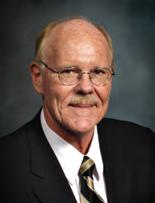
Sometimes it pays big dividends to take a look back. Mark Twain was heard to say, “Get your facts straight and then you can distort them as you please.”
So we went back in the archives and pulled out five of the best ideas from the past decade. As much as these ideas have been touted as great opportunities for the club to make progress, they are not as widely implemented as we should hope. So the question becomes, “Why Aren’t You Doing That?”
The ideas represent five major areas including governance, membership, planning, food and beverage and capital funding, each with a successful track record at clubs that have implemented them. Why aren’t these concepts universally used? So let’s look at the following concepts with an open mind.
1) Make your members your sales force: Develop a membership enhancement program that cuts initiation fees temporarily without really cutting initiation fees – a program that energizes the members to act in a timely fashion. Follow the steps below:
1. Develop a voucher good for an initiation fee discount of a minimum 20-25 percent or higher.
2. Provide a letter and gold sealed certificate for each member. Congratulate them for supporting the club and give them the certificate that they can use as a gift to give someone else.
3. Have a time frame attached. Zero to 90 days full value. The certificate reduces in value 25 percent for each additional 90 days.
4. Offer a food and beverage credit to the sponsor so they can take the new member out to dinner at the club once they become a member.
The keys to the program are simple.
1. You never actually cut the initiation fees. If you started as a $10,000 club you are still a $10,000 club.
2. It gives members a reason to think about sponsoring a member.
3. The program has a time aspect that encourages immediate action while the voucher is worth full value.
4. It feeds the egos of members by providing them an opportunity to give someone something of value.
5. It is not a giveaway program that undermines operating income.
This program has generated new members for dozens of clubs who have implemented it.
2) Establish a board resource chair: What, you ask, is a board resource chair? Many times the GM has difficulty insuring the BOD completes critical governance responsibilities. They need a committed partner on the board. We suggest the vice president fill that role. The duties would include working with the GM to insure:
1. The nominating committee meets at the beginning of the year and fully understands their responsibilities.
2. Insure a board retreat is scheduled to plan for the year.
3. Work with the GM to schedule board education programs.
4. Insure mandatory new board member orientation is scheduled prior to the first board meeting.
If each element is accomplished, the VP who is moving up the chairs will have a much better presidential year.
3) Develop a living document: The most effective way to manage the elements of your strategic and operational plans is to develop an organizational document that provides an ongoing review of all operational and strategic initiatives. The document design is a living document that can be modified and updated on a regular basis.
The plan management system must have timelines, resources needed, persons responsible, and a coding system to track the status of completion.
Clubs take the plan to the annual membership meeting and tell members this, at a minimum, is what they can expect from their club this year. Members are updated each quarter. Basically this becomes a living strategic and operational document that is the ongoing focus of the club from year to year.
4) Find out if the club is a top three choice: Food and Beverage service is the glue that holds a club together, as the only thing every member of the club does is eat. Too often members write off the club as a destination location in favor of other establishments.
The measure of how the club stands in members’ minds is if the club is a top three choice of a casual dinner or a formal dinner. When a member decides to go out to dinner, a few favorites immediately pop into their mind. The goal of a club is to be one of those favorites. Two critical survey questions include:
1. Is the club a top three dining choice when you want a casual dinner?
2. Is the club a top three dining choice when you want a formal dinner?
Good club F & B operations will get about a 65 percent yes on the casual dinner question. However, it is difficult for clubs to average over 50 percent on the formal dining question. Do you know how your members rate their club? You should, and you
should also have a plan to increase satisfaction ratings and monitor that progress.
5) Fund major clubhouse projects for two steaks a month: Many times clubs will develop clubhouse renovation projects that concentrate on improvements to the club dining experience. There is a boom in new casual dining opportunities in clubs. So how should a club fund the project?
The first question I ask the club is, “Do you have a food and beverage minimum?” More than not the answer is yes. A great concept is to take the part of the F&B minimum and roll it into capital dues. The net cost of the club does not increase. Members lose the food they would have gotten for the portion of the minimum that is now dues.
For example, if you have a $150 per month minimum that’s reduced to $75, the $75 becomes dues for the debt service and the club can pay the debt down painlessly. What did a member used to get for $75? You get two steaks a month. Your marketing program is set. It works. We have funded several capital projects on that concept very successfully.
Remember what Henry Ford once said, “If you think you can, or if you think you can’t, you’re right.” BR
More information on these concepts can be found at Clubwiseconsulting.com/publications.
Jerry N. McCoy, MCM, is the president of Clubwise, LLC, a consulting firm specializing in strategic planning, master planning, operational audits and governance issues. Clubwise was the 2013 Consulting Company of the Year by BoardRoom Magazine. He can be reached at www.clubwiseconsulting.com or CMAAMCM@msn.com

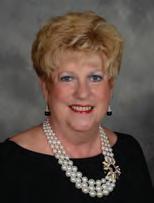
The technology revolution has happened so fast that many people have never stopped to ponder just how much of their communications really depend on technology.
People have “friends” they’ve never met on social networking sites, and a whole generation is already tired of cell phone calls and has given them up in favor of texting. Don’t you just love saying Happy Birthday to someone you don’t know? We all do it.
Email is currently the most popular form of online communication, even after discounting the large volume of spam messages sent. According to readwrite.com, about 188 billion emails are sent out per day. In addition, there are three times as many email accounts as Twitter and Facebook accounts combined.
So here is an outline of some the leading forms of technology and how they can be used in our recruitment and retention of members.
Millennials are the biggest next segment of population growth, they are 15 – 30 years old today, and send over 2,000 text messages per month. Fifty-seven percent of Millennials say losing their phone would be worse than losing their car. At roughly 77 million, Millennials make up about one-fourth of the U.S. population.
Developing a strategy now to determine how you are going reach this segment for the future will a big part of your success. For invitations to young executives, stop putting your website on flyers and posters. No email address. No phone number. On the bottom of all of your promotional material can be one simple call to action: Text MILLENNIAL to 23232 for more info on our programs for you.
When someone new texts our keyword (Millennial) to your short code number (which is not really 23232), a couple of things can happen: 1) They become subscribers to your group texting list – so they’ll get updates and invitations via text message, and 2) they receive an immediate text back with info on whatever we’re promoting at that time.

Texting: This has become the most personal form of business communication. Whereas you might give your email address to too many people, your personal text number is reserved for a few close associates. Your communications by text tend to be more urgent than email.
To capture existing Millennials within your membership, buy a $50 gift card (Starbucks, iTunes, Chipotle, etc.) and create a cool flyer to pass around the club pool, teen rooms, etc. The call to action on the flyer is simple: We’re giving away a $50 Starbucks gift card.
Text FREECOFFEE to 22222 to enter on the spot. You get the benefit of capturing their information for the future.
Instant Messaging: This can be done through websites or instant messaging applications and can contribute to the success of your negotiations. Instant messaging tends to be for
longer discussions than texting. You can engage someone in another city, state or country in a conversation that can lead to a lucrative business deal. The advantage of this electronic conversation is that you can take time to think before you respond. In face-to-face conversations, it can be difficult to pause long enough to gather your thoughts.
Social Networking: Social network sites such as Facebook and MySpace can be essential to getting your message out.
You will have to adjust your communication style to a more informal approach. You gather “friends” on these sites, because they are places to do relationship marketing.
Instead of sales pitches, place messages on these sites that sound like you have a good deal for your friends. Pinterest and LinkedIn have also had their share of visitors, with LinkedIn used primarily for business connections and Pinterest used largely by women.
Use LinkedIn to find out who else works with your members for referrals. According to Trevor Coughlan, director of marketing for Jonas Club Software, if Facebook were a country here’s where it stands against the population figures of countries:
1. Facebook
2. China
3. India
4. U.S.
5. Indonesia
Tweeting: The website Twitter allows you to broadcast very short messages called “tweets” to people who have elected to follow your posts.
This is not the place for a long treatise. Instead, briefly refer to a
new product, message or development your company is excited about. This may not result in immediate sales, but it will result in awareness of your company in the marketplace. Tweeting is perfect for dining specials or special events.
Blogs: The word “blog” is short for “web log.” Amateur often write on these sites, but getting a blogger to review a product or service can be a good way to spread the word about your club.
Contact bloggers by email, usually listed on their blogs, and ask them to take a look at you.
Zillow.com is an excellent source for new owners in your area and Nextdoor.com helps you research addresses. Mention.com and Boardreader.com both give insight as to whether your club name or neighborhood is being discussed and don’t forget to set up a Google search to notify you when your name appears in print.
No question about the use of technology in membership…certainly makes ‘cents’ to me. BR
Susan Greene is a 28-year veteran in the private club business. As an award winning vice president of membership and sales for ClubCorp, Susan coached the managers, membership, catering, and retention teams of 21 clubs. In 2005, Susan assumed her first General Manager’s position and served on the education committee for her CMAA chapter. In 2012, Susan returned to her first love and is the director of membership and marketing for The Oaks Club in Osprey, FL. She serves as the incoming national president of PCMA (Professional Club Marketing Association). Susan can be reached via email: sgreene@theoaksclub.com


Today, clubs are comprised of unique and diverse memberships that require a variety of outlets for communication.
Traditional tactics utilize the club’s newsletter to relay information. Over the last decade, clubs have embraced periodic email blasts as well as posting information on the club’s website. These remain important avenues for communication, though the new age of technology has introduced yet another option – social media.
During facilities improvements, it is important to keep members as up-to-date as possible about the progress being made and any changes that are occurring at the club. As club members are becoming more reliant on smartphones, tablets and other mobile devices, we must embrace the role that social media plays in their daily lives. Does their club have a Facebook page? Use it to post updates regarding construction, dining limitations or temporary facilities. How about Instagram? With its pictorial
nature, Instagram offers a great opportunity for weekly posts of photographs to show progress of the improvements. And for video updates, there is YouTube. Developing a members-only YouTube channel will allow the club to post videos of construction areas, and some clubs are even investing in their own drones to capture aerial footage throughout the process.
Regardless of which outlets you choose to utilize, the key to the successful implementation of any facilities improvement program is to develop a clear communications plan for members –After all, it is their club! BR
Rick Snellinger is president & CEO of Chambers, which provides planning, architecture, interior and food service design for private clubs across the country. A strategic and master planning specialist, Rick can be reached at (410) 727.4535 or rsnellinger@chambersusa.com. More information available at www.chambersusa.com

Event Equipment Sales (EES) is the leading supplier of portable event products for over 22 years.
Our award-winning and innovative designs have helped forge the path of the hospitality and special event industry. EES spends countless hours developing quality products that are durable, efficient and effective. Our primary focus is manufacturing portable dance floors, LED bars, product handling carts and event tables.
Event Equipment Sales’ patented Florlok® system means no tools are required to install their portable dance floors or LED Bars. The portable dance floors can be set up in half the time of their competitors, the event seating is unparalleled in scope and quality and their event tables are proudly made in the USA. BR
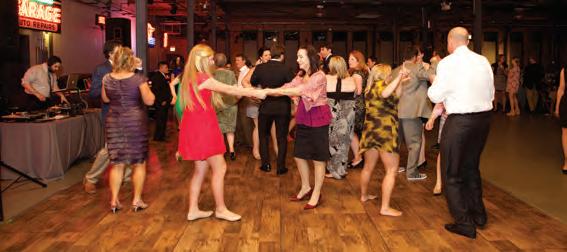
“I started my hospitality career working as a houseman setting up for large events at the contemporary resort at Walt Disney World. We would have to set up dance floors sometimes for over 1,000 people. The dance floors back then were the old tongue and groove with an Allen’s wrench set screw to keep the panels in place. Any operator who has had to use this antiquated system will agree too many backbreaking hours were spent setting up and tearing down these floors. Since my days at Disney, I have purchased two Florlok® modular dance floor systems and have used them over the last 16 years at two different country clubs. The unique design of this floor is so user friendly….no tools, no kicking, no frustration. The people at Event Equipment Sales are so friendly and their service is great. Their prices are reasonable and their selection of banquet equipment beyond dance floors is amazing. I highly recommend Florlok® portable dance floors from the great people at Event Equipment Sales.”
Mark P. Miller, CCM, General Manager/COO Irondequoit Country Club, Rochester, NY

From single pieces to full uniform packages, High-End Uniforms offers hospitality apparel to the club and resort industry that is consistent in the quality of its cut and the sophistication of its design.
High-End understands the complex concerns of the club industry and offers a range of solutions well suited for club venues. As group establishments, you demand a deep pool of design options in assembling uniform packages that represent your distinct look consistently across every position.
From casual, outdoor service staff to formal banquet service and everything in between, High-End Uniforms’ extensive product lines, exceptional sourcing capabilities and experienced designers are fully equipped to create cohesive and fashionable uniform packages that bear your club’s name and express the unique personality behind it.
Whether you’re looking for classic cuts that convey a sense of exclusivity or contemporary styles that fuse the latest in fashion with essentials in function, High-End Uniforms is dedicated to creating distinct uniform packages that elevate your presentation and reinforce your image. Additionally, their in-house embroidery service allows them to ensure attention to every last detail. BR
Thirteen years of exceptional uniforms from 40 years of collective experience. When a veteran chef and a fashion designer join forces, what do you get? Apart from the best fed, best dressed couple around, the dream-team partnership behind High-End Uniforms: Debbie and Kym Surani. Want to learn more? Please call us at (707) 746-7011 or visit www.highenduniforms.com to learn more about how we can help you refresh your look, boost staff morale, and reduce your long-term uniform costs.

Did you know that KECamps is the leader in operating country club day camps nationwide?
If you have been looking for a new way to add a fresh, friendly and functional service to your club atmosphere, it’s time to focus on the kids! Positioning your club as familyfriendly is the way to keep your members engaged and prospective members interested, and offering a variety of child-related activities throughout the year is a wonderful way to get started. To truly round out the experience and provide families with a consistent and quality option, an allaround summer day camp is the way to go.
Offering a summer camp at your club will have minimal impact on your day-to-day operations while providing measurable rewards. The children enrolled in the program will be more likely to sign-up for golf and/or tennis lessons and clinics throughout the year after their exposure to these sports at camp. The parents of the campers will be much more likely to use the club on a more frequent basis as they will be there when dropping-off/picking-up their children. And finally, you can feel confident that you are offering a service that is truly worthwhile, convenient and FAMILY-FRIENDLY!
KECamps makes offering a top-notch children’s summer camp at your club easy by doing the work for you. Not only will camp be an exciting option for your current membership, but it will work to engage prospective members as well. KECamps will provide you with an outstanding day camp experience for your members, both parents and kids alike!
The KECamps program includes recreational golf and tennis, swimming, athletics, arts & crafts, kids fitness (such as martial arts or yoga), fun with foods, group games, super science activities, special events, Wacky Wednesday theme days, and weekly Thankful Thursday community service projects all geared toward campers ages four to 10. We work with you as a team to customize the camp program to suit your club’s individual environment and space. Operating a day camp is a large undertaking with many moving parts. That is where KECamps comes in! We handle it all: insurance, licensing, programming, staffing, payroll, administration, marketing materials, registration and customer service.
For 16 years, KECamps has been providing a truly unique day camp experience to thousands of children at our 80-plus clubs nationwide. Bring the family back to your club by offering a summer camp run by true camp professionals. BR
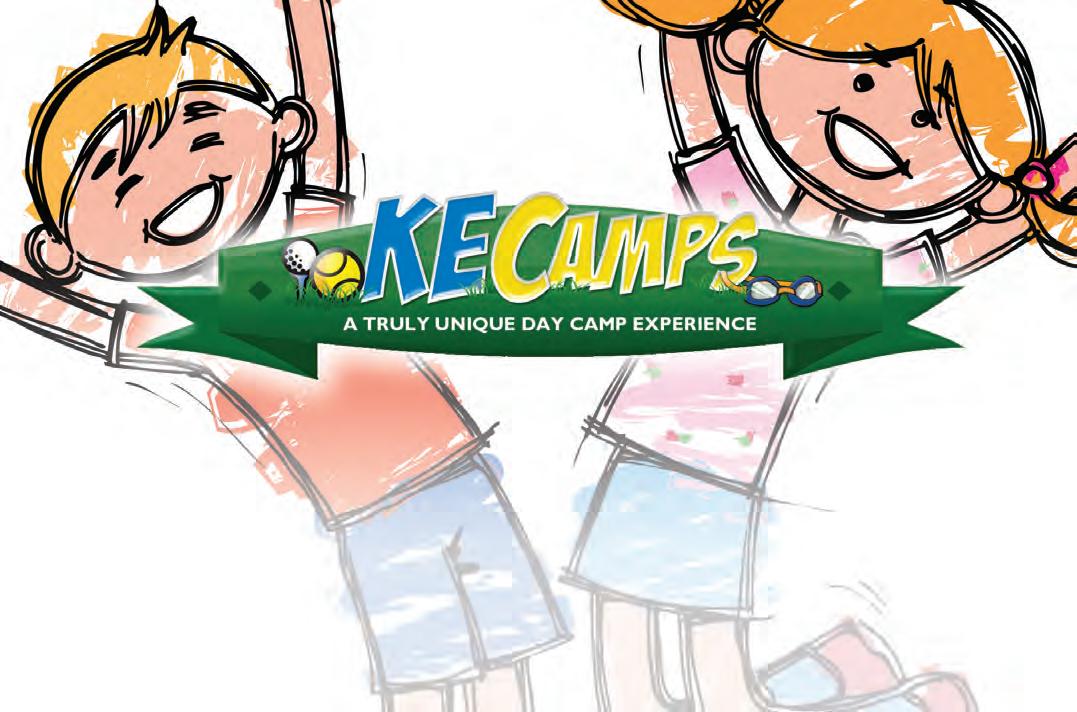
Bring beauty into your dining room and enhance your wedding events with Palermo, the newest addition to our European damask collection.
This new pattern is available in warm neutrals, and the rich colors of Palermo will enhance any room in your club. Add a splash of color with an overlay or brighten up the room using floor length coverage.
Palermo is rated for commercial use and is 100 percent polyester machine washable, offering the consumer a cotton feel and giving the club the durability of a polyester fabric. Palermo is colorfast and custom designed with the club and hospitality industries in mind, and at 135 inches wide, it provides a seamless look on any table. This product is available in
other textures for a mix and match of tablecloth to napkins.
We are now offering faux linen in three colors, perfect for an underlay or printing a full repeat pattern. The linen is featured on the Palermo color card.
Something Different Linen is a full-service tablecloth manufacturer with over 30 years in the business. We offer fabrics milled in the U.S., and we are a Milliken distributor with exclusive patterns, colors and prints designed on premise. Call your sales representative today for a sample or catalog. BR
For more information please visit www.somethingdifferentlinen.com or call us toll-free at (800) 422-2180.

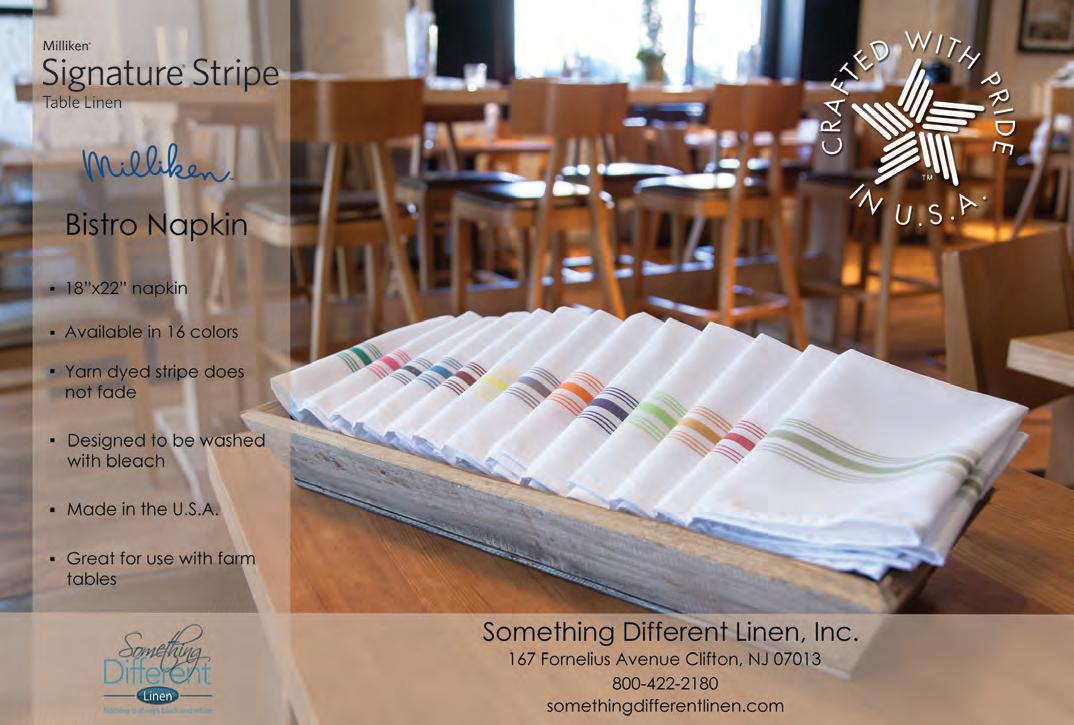
More than ever, golf courses need to explore all opportunities that could either increase an existing revenue stream or create a new one.
Golf cart management and cart GPS systems have evolved over the last decade to fill both of these opportunities.
Golf courses that currently use a GPS product recognize the importance of enhancing a player’s experience, but club managers also understand the product’s potential to generate revenue. The most obvious advantage is the ability to target a captive audience. Using the advertising module

available on most full-featured systems, clubs can reach customers already on site. By advertising their pro shop, restaurant, events, tournaments or other services offered by the course, additional revenue can be generated from existing customers. Golf cart GPS is the most cost effective in-house promotional tool.
Other revenue streams include increased food & beverage sales, and this has been proven at multiple facilities that are using a food and beverage ordering system on a golf cart GPS. The most successful courses offer this service course-wide without any loss of revenue seen at their halfway house or snack shacks.
Cart management and cart GPS systems are no different from any other tool, they are most effective when used properly. If your club is considering a golf cart GPS system, talk to your local sales representative about how your club can benefit the most from operating their system. BR
For more information please visit www.stayprime.com or call tollfree at (800) 649-5924.


Four-way management, what’s that?
After spending three days at a wonderful golf club in Mohnton, Pa., I couldn’t help but comment to the club’s superintendent about the friendliness and professionalism of every one with whom I came in contact.
How is the club able to maintain this atmosphere? He answered: Four-way management to those above, below and to each side of him.
The general manager, green committee and the board of directors are above him.
Below him is the grounds crew; to his right are his two assistants and mechanic, and to his left is the club’s members and their guests.
What a simple and respectful code of conduct. When I asked his two assistants how long they had been at this course they each answered about 10 years. The mechanic who is as good as any I have worked with apparently had a reputation of not staying at one place very long, yet he had been at this course for four years.
When I asked the question to each of why they stayed, the answer I received was the same from everyone – they were treated fairly and with respect. They were family.
During dinner with the superintendent one evening, I observed the general manager still working and conversing with the entire staff. She was practicing four-way management to the staff, board members, entire families, golfing members and their guests. The GM was pleasant, professional, and friendly, and this after a 12-hour day.
Just before visiting this Pennsylvania course (which is now one of my top five all-time courses to visit), I encountered a completely different and opposite atmosphere at another course, which by the way, was in tremendous playing condition.
The superintendent shared that the relatively new general manager knew very little about golf course agronomics and therefore was not in a position to explain to the club’s board and
members practices that needed to be conducted to keep the course in tip top shape. The superintendent felt his job was in jeopardy, and he was right.
In spite of the course being in excellent condition the superintendent was fired shortly after my visit. Apparently the president didn’t appreciate some of the superintendent’s practices –aerifying the greens – when he, the president, wanted to play golf, even though the aerifying was conducted at a time approved by the green committee and the previous board.
In my opinion, the aerifying procedure used was the least disruptive and the main reason why this club’s greens have remained firm and maintained the speed as required by the members.
This club’s president definitely does not practice four-way management.
The successful clubs I visit have one thing in common. There’s no micromanagement…the board sets the policies and then lets the general manager and superintendent carry out and implement those policies. Why hire someone to do a job and then not allow them to do it?
Four-way management must start at the top and be implemented throughout the entire club if quality employees are going to be able to provide the type of service and atmosphere that members deserve and to which they are entitled, and if the club wishes to retain its quality staff members.
Four-way management must start at the top and be implemented to all levels from the agronomic side if we are going to achieve and maintain the quality course conditions that club members deserve. Micromanagement be gone! BR
Dave Doherty is CEO and founder of the International Sports Turf Research Center, Inc. (ISTRC) and holds three patents regarding the testing of sand and soil-based greens. He can be reached at (913) 706-6635 or via email: daveistrc@hotmail.com www.davedohertyistrc.com .

Our customers asked us to design different sized shot glasses to use for liquor and smaller tasting platter items such as desserts, soups and condiments.
We began working on some preliminary designs, but from the many trade shows that we participate in on a yearly basis, we took the feedback from our customers as to what they would, and should, expect from our new shot glasses.
With that added feedback we proudly introduced three different sizes, 2.5 oz with a 2 oz pour line, 1.7 oz with a 1.5 oz pour line and 1.25 oz with a 1 oz pour line.
Prior to these new designs, our only existing shot glass did not have a pour line on it, so the new shot design includes this much needed element.
The shots were also designed for more versatility. Customers of our growing segments of the business, food catering, had asked us to come up with a shot glass that could also be used for desserts, soups and small condiments. So now, not only do we have true shot glasses with pour lines, we have also broadened our line to fill existing opportunities.
The shot glasses are produced in a tempered Polycarbonate material, which allows them to be used in the fridge or freezer. The material helps keep the desserts or condiments colder for a longer period of time. That’s right BETTER THAN ACTUAL GLASS!
Coupled with sheer elegance and clarity similar to glass, these new shots are dishwasher safe and virtually unbreakable, thus reducing the cost of replacement.
Adding this line of shot glasses is just a natural step for Strahl, and for your food and beverage department as well. BR
For more information about Strahl products of the new line of Strahl shot glasses, please visit www.strahlbeverageware.com or call us at (800) 884-4543.


BRUCE R. WILLIAMS
Golfers are well aware of the many technology changes related to balls and sticks but few are knowledgeable about some of the newer technologies on the golf course operations side.
Here are a few things that you might want to look into for your golf course to elevate the standards of your golf course conditioning.
When I think of technology I always think of Dana Lonn, managing director of the Center for Technology for The Toro Company. Dana has the rare quality of being able to think five to 10 years ahead for the needs for the turfgrass industry, and he shared a few things that clubs should consider.
Many parts of the U.S are struggling with water issues, including affordability, availability and quality. Therefore water usage is not only important for how the golf course plays but also for economic and environmental reasons.
A new Toro innovation, Turf Guards, measures moisture in greens. In earlier days the application of water was done by feel and now it’s much more of a science in allowing golf course superintendents to apply water only where needed. Several companies offer tools for a variety of measurements including moisture, salinity and temperature.
Precision Sense is another Toro technology innovation allowing a course to map soil moisture and measure irrigation performance as an auditing methodology.
Aside from irrigation, Dana is real keen on the 5010H mowing unit, a machine that allows for fuel conservation with better efficiency and it also reduces leak potential (dreaded by both golfers and superintendents alike).
More electric power and/or hybrid energy equipment is now being manufactured resulting in less fuel consumption and a side benefit is being able to work around noise ordinances in many cities.
Bob Vaughey manages Rolling Hills Country Club in Rolling Hills Estates, CA, not far from my home. He’s a cutting edge guy with technology and provided me with a long list of things golf courses should consider.
Bob loves the latest drone technology. While it appeared as a gimmick a few years ago it has now been refined and is both quite affordable for golf courses and much more user friendly. Drones, for example, can be used golf course flyovers, capturing before and after shots or documenting changes on the golf course. While GoPro can be incorporated with the drones it can also be used independently to do some of those same things.
GPS likely came out of the space program and is used on the golf course for marking distances of holes, as well as irrigation layouts and cutting patterns. In the last few years we have seen GPS systems on golf carts that enhance the golfing experience by adding distances with beautiful graphics.
The latest GPS use now includes carts that will signal the driver when they are about to enter restricted areas that might be steep slopes, endangered species areas, and within 30 feet of greens. It is like having an automatic golf course ranger on your golf cart!
Apps also are endless for golf course use. Of course that means taking your key personnel and outfitting them with the appropriate Smart Phones, tablets, laptops, etc. Google docs, cloud storage, mathematical conversion and apps that aid in identifying problems with weeds, diseases and insects.
“My point with technology is to take the hour or two to learn a new tool and it will save you hundreds of hours in the long run,” suggested Vaughey.
Many long time golfers remember the days when golf courses did not have enough trees and it became a trend to plant trees. In the 1960s and 70s there were thousands of trees planted on many courses at the discretion of either the superintendent or more likely green committees.
With the loss of species like the American Elm there appeared to be a panic and for every tree that was lost there were four or five planted for each lost one. By the time we hit 2,000 many clubs were suffering with the loss of grass –attributed to competition between grass and trees, because as science has shown most grasses require a specific amount of sunlight to survive.

The power of social media is real, and it’s affordable and the response to the “Thank A Superintendent” Campaign proves it!
If you showed appreciation for golf course superintendents as much as some of the greatest golfers in world, you had a chance to win a trip to the 2015 PGA Championship in August at Whistling Straits in Kohler, Wis.
The sweepstakes, part of the Golf Course Superintendents Association of America’s (GCSAA) “Thank a Golf Course Superintendent” campaign ran earlier this year.
Commercials from the campaign continue to air featuring a montage of clips from Jack Nicklaus, Rory McIlroy, Michelle Wie, Nick Faldo, Rickie Fowler, Graeme McDowell, Matt Kuchar, Johnny Miller, Davis Love, Nick Price, Colin Montgomerie, Jason Day and Karrie Webb…all thanking superintendents.
GCSAA used print and radio to spread the “Thank a Golf Course Superintendent” campaign, golfers responded via social media in a big way. Paid posts on Facebook and Twitter, which cost just a few thousand dollars, got golfers to take action. Golfers were asked to thank a superintendent directly through www.gcsaa.org to be entered in the sweepstakes drawing.
In three weeks of paid promotions on social media, “thank you” letters doubled and put the campaign beyond
The usual culprit with turfgrass loss on greens is shade and root encroachment. Knowing that club members are sensitive to most tree removal it can become an emotional decision for many clubs. But these decisions become easier when backed up with scientific information and previous case studies to show where strategic tree removal has enhanced the turf quality on many golf courses.
ArborCom is a Canadian company that I have had the good fortune to work with and recommend for years. This company has developed a very scientific approach to measuring the impact of shade and the trees that affect that shade on grass. We all know that shade changes by season and their approach will allow for the measurement of shade in various seasons and on specific dates at various times of the day.
Most golfers are unaware of the difference between morning sun and afternoon sun but a golf course superintendent can surely tell you the difference. ArborCom has
its goal of 1,000 letters of thanks. There were nearly 95,000 Facebook views, with 4,000 clicks — 522 likes, 79 comments and 262 shares. Twitter gave us 70,000 impressions — 1,559 clicks, 45 re-tweets and 29 favorites.
In the end, GCSAA got more than a successful campaign. There was effective exposure and interaction with golfers like Murray Calhoun, a 71-year-old from Columbus, Ga., who won the sweepstakes by thanking his long-time superintendent William Smith.
“I can’t even remember what I wrote about him,” said the stunned winner of a trip for two to the PGA Championship. “It isn’t hard to say nice things about William. He is a quality guy who does great work.”
“Superintendents do their best to provide great playing conditions within the realm of keen environmental stewardship,” said Rhett Evans, GCSAA CEO. “We wanted to give golfers the chance to recognize and thank a superintendent for contributing so much to the game they love, and we gave them the chance to attend one of the game’s major championships.”
The “Thank a Superintendent” campaign enters phase two this fall, when GCSAA will introduce another sweepstakes. Social media will undoubtedly again be a valuable way for the association to reach out to golfers. BR
patented calculations that allow the golf course staff to know the impact of individual trees. This allows for removal of only certain trees and backs it up with the science that should convince almost anyone when it comes to making challenging decisions.
The technology available today for golf course management is endless. The take home message here is that for clubs should embrace that technology and make it a part of their operations.
In many cases it is a small cost for a significant return on investment. As Bob Vaughey said, “Any new technology is only worth the time an individual invests in it to make it work for your facility!” BR
Bruce R. Williams, CGCS is the principal of Bruce Williams Golf Consulting as well as Executive Golf Search, which specializes in headhunting for golf course superintendents and industry positions (www.EGSinc.net). Bruce may be contacted at Bruce@WilliamsGolfConsulting.com or (310) 991-9176.

In my old age I’ve become a governance radical. A revolutionary!
After three decades at The Beach Club raging against executive sessions, I’m now convinced that “executive sessions” are a “must do” for boards and committees in any “high relationship club culture.”
Sacrilege!!! Traitor!!!
Stuffing my “I’m The General Manager and I Won’t Be Left Out” thinking into my back trouser pocket, I finally took a cold, hard look at club governance in our “Long-Time-Big-LoveBetween-All-Parties” club culture, and saw a logic I’d never seen before.
Great clubs are blessed when there’s a strong personal relationship between the general manager, the board and the committees. In a high relationship club culture, people not only know each other but they really, really like each other.
Making the bond and reflect opportunity a routine part of the club governance model will eliminate the by exception only executive session scenario that so annoys general managers and eats away at the relationship between manager, boards and committees. Radical stuff for a general manager who’s raged against executive sessions – for decades!!!
There are huge pluses to a love-fest like ours – the manager and members glow when they meet, they give and get respect and they want nothing less than the very best for “the other
side,” their friends.
And there’s the rub.
Because the manager likes the members and the members like the manager, either or both might remain silent when controversies arise, wary of offending their friends on “the other side” of a given issue. And when people keep their opinions to themselves and let comments go unchallenged, good governance suffers.
For example:
The Easily Intimidated Committee Member: The manager’s been here a long, long time, members love her, the club’s booming, she has a great reputation “out there” in clubdom, has published lots and lectured lots in lots of places to lots of people and the last thing I want is to look foolish by asking “the dumb question” or offering “the dumb answer”—-so I’ll keep my mouth shut and speak my piece in the bar over cocktails after the meeting’s done.
The New to Committees Committee Member: I’m a new committee member. Even a newbie can see that the GM loves a good argumentative tussle with long standing committee members. And he usually wins…convincingly! Better keep my mouth shut and avoid embarrassment.
The Board Member Who’s The Parent of a 10Year-Old Orientation Graduate: “My kids just went through the General Manager’s 10-Year-Old Orientation. The manager put three hours into orienting and entertaining my kids and they love him. No way I’m going to contradict what he says or argue against any recommendations he makes!
The Older Member Now Serving on the Board: The manager officiated at my father’s funeral and she deserves my loyalty, and I won’t make suggestions or ask questions that go against her thinking.
The Committee Member Who Just Got Married: The manager officiated at my wedding. Spent four hours interviewing my fiancée, and me; spent four hours writing the
service and spent four hours performing the ceremony and socializing at the reception. No way I’m going to contradict or criticize him after all that. “yes, I agree”, is all he’ll ever hear from me.
In a high relationship club environment, it’s understandable that committee members who like the manager, who respect their years of service and who appreciate the manager’s reputation as a professional might be reticent to voice an opinion that contradicts the GM’s position. It’s easy to see how a high relationship club culture could lead to bad policy decisions if comments or solutions are left unspoken because of the warm, personal and long-standing relationship between manager and members.
To overcome the potential downside of relationship governance and to preserve the advantages of relationship governance, I’m suggesting a new norm for boards and committees. Consider this:
1.Troubles: The manager identifies, articulates and prioritizes the “big issues” that a given committee and/or the board need to address.
2.Research: The manager researches the issues and gathers the facts applicable to that issue, without bias or winnowing, and presents them to the committee and/or the board for discussion.
3.Historical principles: The manager gives the committee and/or board the principles used historically by the board to evaluate “the facts” and to draw a conclusion. For example: The dining room is a community building / marketing expense and not a profit center.
4.Alternative principles: The manager gives the committee alternative principles that could be used to evaluate the facts, which would lead to a different conclusion. For example: The dining room is a profit center subsidizing dues.
5.Discussion: The manager sits in the committee and/or board meeting and discusses the issues. This is “The Danger Zone” in relationship governance. The manager, beloved and knowing, can become a “bulldozer”, leveraging their relationship to silence objections and stifle suggestions. Imagine the after action whining and excuses by members who never spoke up, i.e. I wanted to ask about the dining room subsidy but didn’t because Newbies like me shouldn’t ask questions that make ‘em look dumb. Or, I wanted to object but didn’t because I didn’t want to look like a chump. Good governance becomes the victim of good relationships.
6.The members’ only bond and debrief session: Every board and committee meeting should end with a members’ only bond and debrief session during which issues and ideas that were left unspoken when the manager was present can be aired and discussed. The chair or president will guide the debrief, respond as needed and record the comments.
Fact is, members will “bond and debrief” after a board or committee meeting regardless of the policy, either openly in the boardroom where there’s balance and constraint or in the shadows at the bar where emotions and rhetoric will rule.
7.President and/or chair-manager debrief of “the members only bond and debrief session.” Following the members’ only session, the president or chair will sit with the manager and reviews the issues discussed, concerns expressed and recommendations made.
This meeting is a candid “no holds barred” detailed discussion of the thoughts expressed during the members only debrief.
8.Follow up white paper/memo analysis: The manager then drafts a memo addressing the bond and debrief issues, provides further background, gives analysis and ships the memo to the board or committee for their review and comment.
9.The discussion continues: If required, the issues raised during the bond and debrief session, and the Manager’s response, are discussed at the next board or committee meeting.
Great manager-member relationships can lead to good club governance or to bad club governance. The high relationship governance model I’ve outlined will allow the good parts of relationship governance to flourish and will mitigate the bad.
Making the bond and reflect opportunity a routine part of the club governance model will eliminate the by exception only executive session scenario that so annoys general managers and eats away at the relationship between manager, boards and committees.
Radical stuff for a general manager who’s raged against executive sessions – for decades!!!
But I’m now a believer, convinced that an end-of-everymeeting member only bond and debrief session is the right thing to do in a high relationship club environment.
Give “bond and reflect” a try.
And enjoy the journey—- BR

The regulatory agencies in Washington, DC, have been busy this year, promulgating new rules and regulations.
Unfortunately, much of the regulation will be impactful for the small businesses, which comprise the club industry. Take a dive into these two substantial issues for our industry.
In early July, the Department of Labor announced a proposed rule to change the existing overtime regulations under the Fair Labor Standards Act. The last updates to the DOL’s overtime regulations occurred in 2004.
New salary thresholds: The DOL’s proposal establishes the standard salary level at the 40th percentile of weekly earnings for full-time salaried workers. As proposed, this would raise the salary threshold from $455 a week (or $23,660 annually) to about $970 a week (or $50,440 annually) in 2016.
The total annual compensation requirement needed to exempt highly compensated employees (HCEs) will increase to the annualized value of the 90th percentile of weekly earnings of fulltime salaried workers (or $122,148 annually). These percentiles are based on data from the Bureau of Labor Statistics.
Annual updates to thresholds: The DOL is also proposing to automatically update the standard salary and HCE total annual compensation requirements. The DOL has suggested two options: (1) maintain the levels of 40th and 90th percentiles of earnings for full-time salaried workers respectively, or (2) adjust the standard salary and HCE compensation amounts based on changes in inflation, as measured by the Consumer Price Index for all Urban Consumers (CPI-U).
Duties test: While the DOL is not proposing any specific changes to these, it is seeking input from the general public and industry on the existing duties test. Further, the DOL is soliciting feedback on the possibility of including nondiscretionary bonuses to satisfy a portion of the standard salary requirement.
Based on estimates by the DOL, these proposed changes will impact five million workers nationwide. The proposed regulation was published in the Federal Register on Monday, July 6, 2015, and public comments were due September 4.
On March 27, the Environmental Protection Agency (EPA) and the Army Corps of Engineers (Corps) announced the final Clean Water Act (CWA) (aka Waters of the United States) rule, previously referred to as the Waters of the US (WOTUS) rule.
Many water bordering golf courses including rivers, streams, creeks, wetlands, ponds, ditches and ephemeral drainages may now be subject to federal jurisdiction. This will impact operations and budgets as clubs will be required to obtain costly, federal permits for any land management activities or land use decisions in, over or near these regulated waters.
Four new categories will be regulated under the CWA, in addition to the existing four categories of (1) Traditional Navigable Waters (TNW); (2) Interstate Waters; (3) Territorial Seas; and (4) Impoundments
The CWA will now regulate (5) Tributaries ; (6) Adjacent Waters ; (7) Enumerated Regional Features with a Significant Nexus ; and (8) Waters in the 100-Year Floodplain/4,000 Feet of a Water of the US with a Significant Nexus . The final two cate-
gories are jurisdictional where the EPA and Corps find, after a case-specific analysis, they have a significant connection to TNWs, interstate waters or territorial seas. Further, there are 10 enumerated exclusions. [For a full list and complete interpretation, visit www.cmaa.org/legislative.aspx. ]
The final rule is slated to become effective at the end of August, and opposition to the measure is mounting in Congress and the judicial system. In May, the House of Representatives passed HR 1732, the Regulatory Integrity Protection Act of 2015. The measure passed 261 to 155. The bill directs the EPA and the Corps to withdraw the CWA rule within 30 days of the bill’s enactment. The agencies would be required to develop a new rule that relies on further consultation and input from several organizations, including state and local officials.
In June of this year, the Senate Environment and Public Works Committee (Committee) approved S.1140, the Federal Water Quality Protection Act. The bill requires the withdrawal of the joint rulemaking revising the definition of WOTUS under the Clean Water Act. S. 1140 then provides to EPA and the Corps the procedural and substantive direction necessary for development of a more reasonable rule that will protect the nation’s “navigable” waterways.
To date, S.1140 has not been brought up for a vote by the full Senate. However, the committee continues to assert pressure on the EPA to substantiate its actions and provide legal justification for the CWA rule.
Meanwhile, the White House has already indicated its inclination to veto any measure that impacts the CWA.
As of the date of this article, 29 states have filed suit against the EPA and Corps for overstepping their authority and infringing on the right of the states to manage and protect intrastate waters and lands. It is likely this rule will be further debated through the legal system well beyond the enactment date. BR
Melissa Low is the senior director, Communications and Government Relations for the Club Managers Association of America. For the latest information on these and other issues affecting the club industry, please visit CMAA’s Legislative Report blog at www.cmaa.org/legislative.aspx.
Fast-paced and rapidly changing, the foodservice industry demands total involvement from its designers, suppliers and consultants.
With more than three decades of experience, DEI is ideally positioned to provide cutting-edge technology, knowledge and industry expertise. These qualities enable DEI to help commercial and institutional foodservice businesses remain competitive, profitable and innovative in the 21st century marketplace.
Country clubs have become a big part of our business. With over 30 country club projects successfully completed to date, DEI works closely with general managers, executive chefs and food and beverage directors to assure that the project we design meets all of their requirements, as well as those of the club members.
Situated on the southeast Florida coast, in Hollywood, Florida, DEI is ideally located to serve companies in the United States as well as South and Central America, Mexico and the Caribbean.
Count on DEI to offer only the best in design, equipment and service. From inception through completion, DEI partners with suppliers and manufacturers that are among the finest in their fields. This commitment to quality, in every phase of the process, provides long-term cost effective solutions for foodservice operation worldwide.
The owners of DEI assure high customer satisfaction by overseeing factory involvement, integrated training, standards, service and quality installation on every project.
DEI invites you to experience total package excellence for all your foodservice needs. BR






derful it is at the club and that builds desire, which leads to exclusivity, “Stavros added.
“Brand is everything,” injected ClubMark’s CEO Rick Coyne. “Luxury brands exude total quality, inclusive to a culturally diverse consumer and generally with costs relative to the experience.
“Clubs serve two markets – their existing members and those that are not yet members. Everything that a club does internally for its existing members is projecting to potential members what they can expect.”
Coyne feels it’s vitally important to know your market before branding your club.
“You shouldn’t plan a brand until you fully understand your market. Club communities that brand in a luxury lifestyle are generally positioning similar to a high-end resort. Clubs too can likewise position, but if your market cannot afford a luxury brand it would be foolish to try.
“The only way a club should position itself with a luxury brand is if the market supports the position,” he explained.
“Clubs like any luxury brand have customers, or in a club’s case members who have a choice,” intoned Tom Neill, president of Private Club Historical. His Laguna Beach, CA firm curates, discovers and designs historical displays, exhibits, videos and photography, highlighting a private club’s unique history.
“What’s unique and extraordinary is the connection between the club and its members. No other luxury brand has a relationship like this. So it’s imperative the behavior parallels the fact that it’s the members who own the brand and by respecting them, listening to them, you earn their trust.
“Through my experience,” Neill added, “I clearly see two entities of branding: external and internal.
“External as represented by tangible items such as logo marks and websites, but more importantly for a club, is internal emotional branding as represented by a member’s pride in their club. For example, this can be accomplished by historical displays and exhibits featuring past and current members and is important for creating a cohesive positive member experience,” Neill suggested.
“It’s important because each club has its own unique brand, its own history, its own character, its own thing that it should be known for,” stressed Keith Jarrett, president of BoardRoom’s Distinguished Club program. “And the most successful clubs highlight their brand throughout the walls and displays of their clubhouses.”
There’s a general consensus benefits accrue with a luxury lifestyle brand.
“The club will attract the communities most influential and important people. The city’s major events will be held at the club. Major decisions affecting commerce, politics and social issues will be made at the club,” Gore suggested.
“Once the club is associated with a luxury brand the club’s image is enhanced, important people will consider membership in the club and the club can attract top talent for department heads and other important staff positions,” he added.
“The benefits are numerous, especially the benefit of a member belonging,” Neill stressed. “It’s the belonging to a brand that creates the greatest impact upon the member. It’s the unique sense of accomplishment and achievement and that they have arrived at their goal.
“By belonging, this brand emotion manifests itself when justifying initiation fees, dues and assessments,” he expressed.
Coyne however, cautioned, “Unless the market is capable of affording a luxury brand, there is no benefit to your club trying to supply something the market cannot afford. If the market can sustain a luxury brand, you will stand out in the marketplace.”
And if “the market can afford a luxury lifestyle brand, the benefits are attractiveness to a discerning market capable of affording the fees endemic to the experience,” Coyne explained.
What about younger generations? Will luxury branding make any difference for these younger, potential members thinking about private club memberships?
The sheer number of younger people and their interest in brand name products does make that likely. For example, Pace Setter Technology suggests there are 12 million Millenials considering taking up the game of golf.
So what’s the private club industry doing to attract them and are Millenials more influenced by branding and the product names.
“Indirectly,” suggested Pace Setter’s Stavros. “They are more influenced by relevant consumer feedback.
Millennials are far more likely to get a recommendation or confirm through online reviews. When branding is effective, it creates a buzz. It’s about the four Es – emotion, experience, exclusivity and engagement,” he injected.
Does having a strong brand attract new members and staff? “Absolutely.”
Does having a strong brand attract referrals?
“Absolutely.” Does having a strong brand increase the value of an initiation fee or justify the dues? “Absolutely,” Stavros maintained.
“The younger generation has always enjoyed associating with the most admired trends, products, and brands,” Neill commented. “It’s how they feel about a company, it’s rational but mostly emotional.
“Social media has also expanded the brand’s communication through multiple channels. Many of these channels can track where you came from and are going, and use incredible algorithm to communicate and hone a brand to the user.
“Younger generations, or future members are exposed to this like never before,” Neill added. “The logo, the graphic elements are simply a visual and emotional cue, which I call an ‘intertangible’, the moment the visual transitions to the sublime and the emotional branding takes over.
“A club’s strong brand, a high-end, luxurious look will attract new members and win the hearts and minds of those who are seeking to join their first club. By offering them a luxurious experience, this will appeal to those who are now in the market for an added benefit to their lifestyle.
“However, a major part of a club’s brand is its history and for many, we see clubhouses, which look like a hotel chain lobby. There is nothing on the walls or any exhibits, which depict the club’s historical significance and more importantly, the member.
“Clubs that do have this historical presence use their displays as their premier tool when touring prospective members,” Neill stressed.
And does a strong brand attract both new members and staff?
“This has been validated many times. The brand specifically may not attract new members, but when a member is proud of their club, they refer friends and business associates to membership. A strong luxury brand creates pride in belonging the basis for referral,” expressed Frank Gore.
“A historical display depicting a club’s history can embolden a strong internal emotional brand identity,” Neill explained. “This in turn, sparks pride with members and a sense of belonging and this is relayed to referrals. Imagine having 500 member tour guides!
“Yes, a strong luxury brand increases member usage and pride. Member pride can solve a lot of a club’s challenges by justifying initiation fees, dues and assessments,” Neill concluded.

The next generation of members, the Millennials, are branding fanatics. They buy Apple products, wear Nike and drive BMWs. This generation has been raised on branding, and I believe to reach this next generation of private club members your club must stand out.
Your club needs to have a strong brand. And not just a strong brand, because by the time Millenials can afford to join your club your club needs to be a luxury brand. There are myriad reasons why.
For years, my wife has been buying Louis Vuitton purses. I’ve always wondered why, because 90 percent of each of these purses is made of canvas, not even leather. Yes, there must be some appeal, yet they all look the same. Louis Vuitton is written all over each purse and is very expensive. So what’s the appeal?
She buys Louis Vuitton, I believe, because it makes her feel good. She feels she has arrived. And that’s no different than your members when they join your club. They feel like they have arrived. They enter your club with a feeling of pride and accomplishment.
When you walk into a Louis Vuitton store, there’s a feeling of luxury, exclusivity…the stores look classy, staff is very well trained and professional. The walls covered by photos of 100-year-old luggage…pictures of Louis Vuitton suitcases on old cruise ships, in antiques cars, and the like, giving an air of longevity and exclusivity.
When you are in their store you feel as though you are in a special space…with the products that ooze history and distinction.
I mention the Louis Vuitton store as an example because the key aspect to branding and treating your club as a luxury brand is that people feel they are in a special space when they walk into your club. It’s the way they want to be seen and treated.
Many clubs today look like a Marriott hotel lobby, and when walking in the front door that’s the feeling one gets…not that there’s anything necessary wrong with a Marriott hotel, but it’s certainly not a luxury private club.
I’ve actually seen the same pictures on the walls at three different country clubs…all with similar interior designers. Or they have pictures of flowers and maybe even pictures of some other golf course, not that there’s anything necessarily wrong with flower and golf course pictures, but…
Cover your walls with history, picture and artifacts from the past, from previous members, events and guests. Show your members your club is proud of its history, because you want prospective members to feel and know they are in a special place.
Remember, clubs are selling more than the functional product (for example, a clubhouse, tennis courts and a golf course) itself. There is something else, and it’s symbolic. Clearly it’s the identity, the intangibles, which the club confers upon each and every member.
Some members might see their membership as being of superiority. I believe it’s common for luxury brand customers to sense that link to something special. It may be a link to a story, a founder, or a creator or a specific time. But, it’s something special.
I also believe many buy luxury products because of authenticity. Today, more than ever, people feel dislocated from any sense of authenticity. Walking into and around your club you must feel the purity of belonging to ‘this’ club, which sends a message saying, ‘this is something you can be part of’, to which you say, “This is something I can and want to be part of.”
Over the last three years, we have visited hundreds of clubs and a common message we have received from club staff and management is this: We are the home away from home for the members. We are there second home and so on.
But it’s also interesting in that many of the clubs we visited don’t look like a home…they look and feel like hotel lobbies.
When you walk into one of your members’ homes, you see history. You see photos of their trips, their family, present and past, and mementos from the past. You can tell a lot about a member by walking into their home.
Shouldn’t the club really look like a home away from home? The only difference is that your club members are the family, the history is the club’s history and the mementos are from the club’s past.
Branding your club like a luxury brand will help you in many ways. Membership recruitment, retention, and the feeling of community it provides.
How do you currently defend the price of your initiation fee? The board sets the price or the member sets the price, based on what? A luxury brand.
Treating your club like a luxury brand will make it easier for you to defend the price, which of course, increases not only the value of the club, but also the value of the club to your members.
At least that’s the way I see it! BR
John G. Fornaro, publisher
If you have comments on this article or suggestions for other topics, please contact John Fornaro at (949) 376-8889 or via email: johnf@apcd.com




Usage –The head spinning change in consumer attitudes and overall cultural changes have kept the industry guessing, but there is science and technology to mitigate the uncertainty. Member surveys, mini-surveys after events, and just plain asking how we are doing, can provide a wealth of planning opportunities that will keep your members coming back and telling their friends.
Member usage should be indexed to determine who might be at risk for leaving. Usage is also a barometer of how members will invite friends and recommend new members to the club. If you are not offering what they want and/or what may be relevant to their family’s needs, you probably are at high risk.
Satisfaction – A contented member will tell friends what a great club you are. They will be using the club frequently because you took the time and used the technology to find our what they wanted, and the by-product of it all is that they will spend more money, bring more friends and your sustainability index will increase exponentially.
Technology is a good thing, but not if it diverts our attention from what is essential to growth, retention, usage

and satisfaction. Write yourself a report card in each of these areas. A and B grades probably don’t need too much additional attention. Anything less than that suggests that technology, resource or more organizational effort needs to be placed in these most important of all areas that will drive your club toward long term sustainability.
Seek to understand, have the courage to change and embrace the technology that can get you where you need to go. It’s all at our fingertips. BR
Rick Coyne is CEO of the Professional Club Marketing Association. He can be reached via email rcoyne@clubmark.com
from Course Design | 22
Determining need to remodel: When remodeling, obtain professional opinions about existing conditions, optional approaches, safety matters and setting priority for the basic goals established by the ownership/membership.
Many different conditions trigger remodeling plans at courses. Some of the most common are:
• To improve or enlarge greens
• To restore historical integrity
• To improve and emphasize distinctive features
• To improve drainage to eliminate flood conditions and poor turf
• Rework, reposition, or add new bunkers
• To upgrade or replace irrigation system
• To add multiple tees to make the course more playable for women, juniors and seniors
• To add additional back tees to accommodate longhitting low handicappers
• To reroute to make course safer and increase speed of play
• To add or remove trees, bushes and natural vegetation to positively impact aesthetics, playing conditions and maintenance budgets
• To add water features to collect storm water and provide more visual appeal, and
•To toughen course to attract local and regional tournaments.
A golf course architect can assess the need and feasibility of each of these remodeling plans and provide assistance in all the steps that follow.
ASGCA has many resources available to the private club that can help smooth the renovation process, including “The Golf Course Remodeling Process: Questions & Answers,” “Selecting Your Golf Course Architect,” and the one-page “Life Cycle Chart” which lists such components as irrigation systems, cart paths and even bunker sand and gives each components’ life span. Any of these publications may downloaded by visiting www.asgca.org/free-publications.
from Global Perspective | 16
vates your club profile on search engines. Remember the axiom that one is invisible if not easily found on the first page of a Google search. The most effective means for using social media to increase search engine efficiency includes a steady flow of Pinterest, Instagram and Twitter.
• Leverage content marketing capabilities by increasing traffic into the club’s website so that people see photographs of your club, learn its history and see images of your members. This segment wants to see that your club is top-tier in its market. Hosting competitions is another signal of accomplishment to international golfers.
from Bylaw Committee | 30
Do you require a thorough introduction and indoctrination for new board members as part of their orientation?
Enforcing the bylaws is part of the board’s fiduciary duty. If the board fails to follow the bylaws, the club’s
from Club Management | 67
• Become acquainted with club managers across the globe. See that international managers know you and feel welcome to contact you to ask that you accommodate and look after their members. Personal referrals are the backbone of international membership growth.
There is a world of opportunity for increasing international memberships for many clubs. Is it time for your club to “go global?” BR
Henry DeLozier, a recipient of the BoardRoom magazine Lifetime Achievement award for 2014, is a principal of Global Golf Advisors. You can contact him at hdelozier@globalgolfadvisors.com.
D&O insurance may be in jeopardy. Are your “shalls” and “mays” as you wish – Are they being enforced?
Ugh! And this is only a start at making sure your club’s key governing document is a boring tool for the positive and not something that terrorizes the general manager. BR
To ensure member satisfaction, know what’s important to them and show as much attention to those areas as possible.
At many clubs, food and beverage ranks nearly five times higher in importance than golf, so be sure to address dining areas where members spend much of their time (and money).
If a complete overhaul isn’t in your club’s future, remember that even a fresh coat of paint in a new color palette can make a big impact.
Although the private club industry has always presented a conservative image, there’s no reason an old dog can’t be taught new tricks.
A well-executed clubhouse renovation has proven to deliver the best of both modern style and traditional luxury, which can be one of the best steps toward sustainability that a facility can make. BR
Cindy Anderson is the vice president of clubhouse design and development for Troon, the world’s largest third-party club management company. She can be reached at CAnderson@Troon.com or (480) 606-1000
Thanks to club specialist attorneys Jack Wilson of Theirl Wilson PLLC and Robyn Nordin Stowell of Sherman & Howard for their help with this article.
Ted Robinson is a partner with Private Club Associates and can be reached at (478) 741 7996 or via email: tcr@privateclubassociates.com
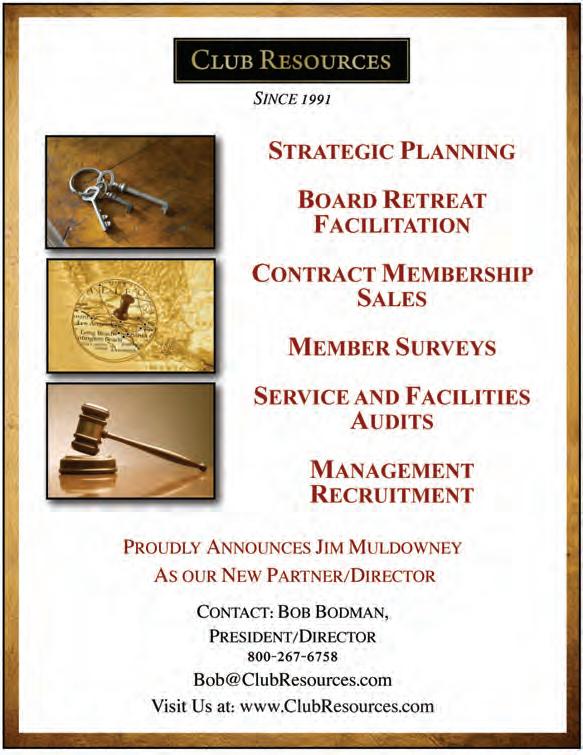

Marketing is almost a forbidden world in old-line private clubs.
Ask a tenured member at the nation’s top clubs about the subject and the response may be: “Why would you market when our members should already know what’s going on at the club?”
Reminds me of what Steve Jobs said about his aversion to focus groups and surveys: “A lot of times, people don’t know what they want until you show it to them.” Wouldn’t that be nice?
Our niche industry is also still behind the times with technology. How do we get the two – marketing and technology – to work for us?
Marketing doesn’t have to be a dirty word in clubdom. It’s really all about rallying the troops for events at the club. It’s also about just making sure people are informed about changes and new happenings – yes, even at old line clubs new things can happen. With a good protocol in place and an individual focusing on these protocols relentlessly will help get the word out.
The absolute best way to get members to show up for event is to get MEMBERS to promote your events. From the golf committee to the entertainment committee to the house committee, it’s every member’s responsibility to help promote events, games, the pasta buffet or the new dinner menu in the Grillroom.
Experts say that to reach a marketplace, you need seven different versions of a marketing effort to be sure to get your audience’s attention. I suggest a plan for eight, and technology is a key aspect in marketing these days – using the right equipment the right way to get the word out!
Some of these things you may be doing now and some are ideas for improvement. Some may seem redundant, subtle differences in some and major differences in others. Let’s explore each:
1. Newsletters – How often does it come out? Every month? Does it have a good look? A catchy front page? The design is very important and creates your brand – the face of your club. Hard copies have a good use. Target – All members get a hard copy; it’s available on your website or in emails as a PDF attachment. Content –It is trying to encompass all events for the following few months. Production – Target is to have it in the member’s mailbox the weekend before the last weekend of the month, giving them the time to peruse it.
2. Weekly e-news – This is a weekly email sent out membership-wide every week to encompass all upcoming events for the week ahead. Frequency – Delivered every week on a regular day in the early morning to all members’ emails. Content – The first section should be what is happening in each area of the club that coming week. The next section could show what is expected the next coming week. The weekly email would also have a section for “Highlighted Events” that can feature all event flyers for the next 30 days. Each section would have flyers or notices attached in a PDF format for downloading. Production – E-news emails should be sent year-round to keep your members engaged.
3. Targeted emails – These we send to groups who opt-in for specific marketing like ladies golfers, tennis players, bridge players etc. Tennis and golf coordinate flyers weekly, and entertainment events and special notices coordinated directly with event.
4.Posters – This effort includes flyers posted or placed in locker rooms, sports shops and bulletin boards, and also coordinated with larger club entertainment events for poster production for the main lobby.
5.Bill stuffers – This is an avenue that can easily get the attention of the person opening the monthly billing statement. A small slip
with highlighted events or a special content/printing on the billing itself.
6. Special notices - Sent to specific groups or all members for special notices like “The Grill room will be open for dinner this Monday, Memorial Day” or “Main road closure this weekend, use back gate.” This can be a perfect solution for groups who have handicap issues and may need special help during events.
7.The WORD – Nothing better than good comments but this is more for employees to pass along. The “WORD” sheet – a notice on all employee bulletin boards where schedules are posted for employees to stay informed and help promote events. Pre-shift meetings are good times to review this information. All should be included. Even a grounds keeper on the course or a cook who’s working an omelet station can be asked about an event or get an opportunity to promote an event.
8. Committees! – The absolute best way to get members to show up for event is to get MEMBERS to promote your events. From the golf committee to the entertainment committee to the house committee, it’s every member’s responsibility to help promote events, games, the pasta buffet or the new dinner menu in the Grillroom. Distributing flyers once a month to each faction (golf/grounds/house etc.) and the chairpersons asking for them to promote events in their circles is the best way to get a good turnout.
One final note: Proofing…this is the hardest thing to get right.
How are you going to possibly do all this, you may ask? It really looks like a full-time job! Well, it really is, and I’d recommend you set specific parameters of timing and formatting. Make sure everyone knows who is producing the content, and then get some help to get the weekly production schedule up and running.
Remember, marketing can be a good word, technology can be a good thing, and don’t forget the “High Touch” too. If we use the both correctly and just try to get members to come to the club, we’ve succeeded –Lead ON! BR
Christopher Boettcher is the GM/COO at Burlingame Country Club near San Francisco, CA and a regular contributor to BoardRoom magazine. He can be reached at chris@boettcher.com

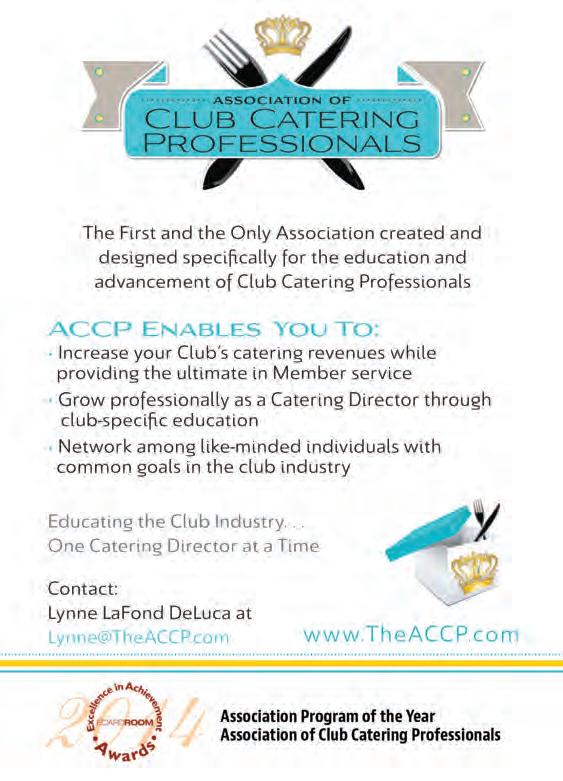




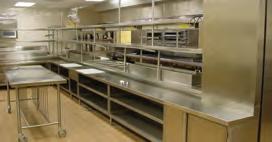


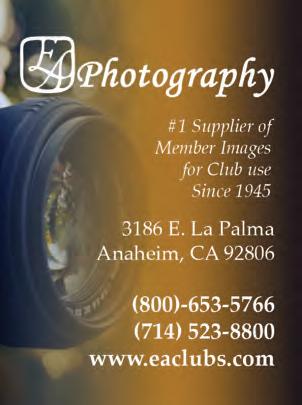



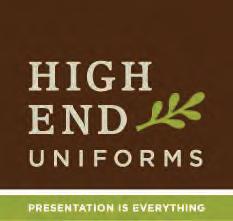







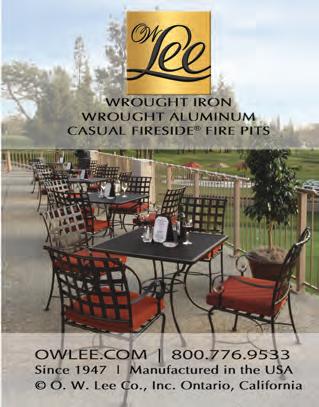











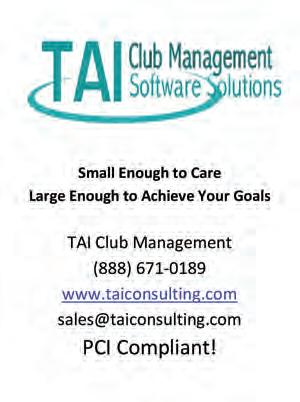

EG Communications
6750 N. Andrews Avenue
Fort Lauderdale, FL 33309
Tel: (954) 958-0338 Fax: (954) 928-2801
Website: www.eurographics.com
Email: martin@eurographics.com
Contact: Martin Marinov, president
Attorneys
Addison Law Firm
14901 Quorum Drive, Ste. 650 Dallas, TX 75254
Tel: (972) 960-8677 Fax: (972) 960-7719
Website: www.addisonlaw.com
Email: clublaw@addisonlaw.com
Contact: Randolph Addison, president
Club Advisory Services
Club Consultants LLC
5121 Castello Drive, Suite 1 Naples, FL 34103
Tel: (239) 643-7800 Fax: (239) 643-7803
Website: www.clubconsultants.com
Contact: Bill Wernersback, sr. mng. dir.
Club Neckties, Scarves, Emblems
Stratton-Crooke Enterprises Inc.
P. O. Box 215-H
Scarsdale, NY 10583
Tel: (800) 732-9719 Fax: (914) 725-5196
Website: www.strattoncrooke.com
Email: StrattonCrooke@aol.com
Contact: Nancy & Jim Crooke
Club Services
HFTP
11709 Boulder Lane, STE 110
Austin, TX 78726-1832
Tel: (512) 249-5333 Fax: (512) 249-1533
Website: www.hftp.org
Email: Laura.Huffman@hftp.org
Contact: Laura Huffman
Clubhouse Design
Chambers
100 Decker Drive, Suite 140
Irving, TX 75062
Tel: (972) 253-3583 Fax: (972) 259-9664
Website: cciclubdesign.com
Chambers
1800 Washington Blvd., Suite 111
Baltimore, MD 21230
Tel: (410) 727-4535 Fax: (410) 727-6982
Website: www.chambersusa.com
Email: jsnellinger@chambersusa.com
Contact: John R. Snellinger
Peacock + Lewis Architects
11770 US Hwy One, Ste. 402
North Palm Beach, FL 33408
Tel: (561) 626-9704 Fax: (561) 626-9719
Website: www.peacocklewis.com
Email: Brian@peacocklewis.com
Contact: Brian Idle
Clubhouse Architect
Judd Brown Designs
700 School Street
Pawtucket, RI (401) 721-0977
Contact: Peter Cafaro
H. Anne Blakely Sciarrone Architecture
P.O. Box 357
Decatur, GA 30031
(678) 632-2663
Contact: Anne Sciarrone
Clubhouse Furniture
Eustis Chair
P.O. Box 842
Ashburnham, MA 01430
Tel: (978) 827-3103 Fax: (978) 827-3040
Web site: www.eustischair.com
E-Mail: fred@eustischair.com
Contact: Fred Eustis
Gasser Chairs
4136 Logan Way
Youngstown, OH 44505
Tel: (330) 759-2234 Fax: (330) 759-9844
Web site: www.gasserchair.com
Email: ksmith@gasserchair.com
Contact: Kevin Smith
Global Allies
625 DuBois Street, #A
San Rafael, CA 94901
Tel: (877) 208-7185 Fax: (415) 453-6042
Web site: www.globalallies.com
Contact: David Cline
Construction
Parkway Construction
1000 Civic Circle
Lewisville, TX 75067
(972) 221-1979
Website: www.parkwayconstruction.com
Course Architects
George Golf Design, Inc.
609 Twin Ridge Lane
Richmond, VA 23235
Tel: (804) 272-4700 Fax: (804) 272-4771
Website: www.georgegolfdesign.com
Contact: Lester George, course architect
Consulting
Clubwise Consulting
3507 Dunlin Shore Court Norcross, GA 30092 (770) 248-1047
Contact: Jerry McCoy
Email: Cmaamcm@msn.com
Denehy Club Thinking Partners
501 Kings Highway East 06825 (203) 319 8228
Website: www.denehyctp.com
Contact: Dan Denehy
McMahon Group
670 Mason Ridge Center Drive , Suite 220
St. Louis, MO 63141
Tel: (800) 365-2498
Website: www.mcmahongroup.com
E-Mail: info@mcmahongroup.com
Course Maintenance
International Golf Maintenance, Inc. (IGM) 8390
Champions Gate Blvd #200
Champions Gate, FL 33896
Tel: (800) 413-5500 FAX: (407)589-7223
Website: www.igminc.net
Email: gregp@igminc.net
Contact: Greg A. Plotner CGCS, EVP
The Toro ® Company
8111 Lyndale Ave S Bloomington, MN 55343
Tel: (800) 803-8676 Fax: (952) 887-8693
Website: www.toro.com
Email: Turfequipment@toro.com
Executive Search Firms
GSI Executive Search, Inc.
Tampa Bay Office P.O. Box 55877
St. Petersburg, FL 33732
Tel: (727) 525-6562 Cell: (727) 366-0487
Website: www.gsiexecutivesearch.com
Email: dick@gsiexecutivesearch.com
Contact: Dick Farrell, Principal
GSI Executive Search, Inc.
Northest Office
Rochester, NY
Tel: (518) 852-0986
Website: www.gsiexecutivesearch.com
Email: dan@gsiexecutivesearch.com
Contact: Dan Farrell, Senior Associate
GSI Executive Search, Inc. Midwest Office
231 S. Bemiston Ave. Suite 800 St.Louis, MO 63105
Tel: (314) 854-1321 Cell: (314) 452-8848
Website: www.gsiexecutivesearch.com
Email: scott@gsiexecutivesearch.com
Contact: Scott McNett, Principal Kopplin & Kuebler
Southwest Office
7349 Via Paseo Del Sur, Ste. 202 Scottsdale, AZ 85258
Tel: (480) 443-9102 Fax: (480) 443-9642
Website: www.kopplinandkuebler.com
Email: dick@kopplinandkuebler.com
Contact: Dick Kopplin, partner
Kopplin & Kuebler
East Coast Office
132 Tulip Tree Jupiter, FL 33458
Tel/Fax: (561) 747-5213
Cell: (407) 864-6798
Website: www.kopplinandkuebler.com
Email: kurt@kopplinandkuebler.com
Contact: Kurt Kubler, CCM, partner
Financial Services
Reserve Advisors, Inc.
205 E. Wisconsin Ave. Milwaukee, WI 53202
Phone: (414) 272-2002 Fax: (414) 272-3663
Website: www.reserveadvisors.com
Contact: Nik Clark
Food & Beverage Software
Culinary Software Services 1900 Folsom Street #210 Boulder, CO 80302
(303) 447-3334
FOOD-TRAK®/System Concepts, Inc.
15900 N. 78th Street
Scottsdale, AZ 85260
Tel: (480) 951-8011 x 8026
Fax: 480-951-2807
Email: nancys@foodtrak.com
Website: www.foodtrak.com
Contact: Nancy Shina, director of marketing
C2 Limited Design Associates
95 Reef Road
Fairfield, Connecticut 06824
Tel: (203) 259-2555 Fax: (203) 259-2565
Website: www.c2limited.com
Email: studio@c2limited.com
Contact: Craig J. Smith
Ferry, Hayes & Allen Designers, Inc.
1100 Spring Street, Suite 600
Atlanta, GA 30309
Tel: (404) 874-4411 Fax: (404) 874-1099
Website: www.fhadesigners.com
Email: jbarret@fhadesigners.com
Contact: Jeff Barrett, executive vice president
HINT | Harris Interiors
49B Lenox Pointe
Atlanta, GA 30324
Tel: (404) 403-2931
Website: www.hintatlanta.com
Email: kelley@hintatlanta.com
Image Design, Inc.
3330 Cumberland Blvd.
Atlanta, GA 30339
Tel: (770) 952-7171 Fax: (770) 933-9093
Website: www.imagedesign.com
Email: mfleming@imagedesign.com
Internet Domain
.CLUB Domain
100 SE 3rd Avenue
Fort Lauderdale, FL 33394
Tel: (877) 833-0000
Website: www.nic.club
E-Mail: info@nic.club
Insurance
GAB Robins
3300 W. Lake Mary Blvd, Suite 350 Lake Mary, FL 32746
Tel: (800) 248-3376
Website: www.gabvalue.com
E-Mail: service@gabvalue.com
Kitchen & Banquet
Spring USA
127 Ambassador Drive #147
Naperville, IL 60540 (630) 527-8600
Website: www.springusa.com
Locker Room Suppliers
Sports Solutions, Inc.
2536 Manana Drive
Dallas, TX 75220
Tel: (800) 969-8008 Fax: (214) 351-2609
Website: www.sportssolutionsinc.com
Email: sales@sportssolutionsinc.com
Contact: Laurie Schmidt
Labeling
Planglow
899 Montreal Circle
Saint Paul, MN 55102
Tel: (800) 774-0536 #1
Website: www.Planglow-usa.com
E-Mail: jason@planglow-usa.com
Lockers
Salsbury Industries - Lockers.com
1010 East 62nd Street
Los Angeles, CA 90001
Tel: (800) LOCKERS Fax: (800) 562-5399
Website: www.Lockers.com
Email: Salsbury@Lockers.com
Outdoor Furniture
Bambrella
6464 East Rogers Circle
Boca Raton, FL 33487
Tel: (561) 288-8655
Website: www.Bambrella.com
E-Mail: info@Bambrella.com
Xhibtz Contract Furnishing
11071 Indian Lake Circle
Boynton Beach, FL 33437
Tel: (954) 614-1505
Fax: (888) 880-9124
Website: www.xhibtz.com
Email: xhibtz1@bellsouth.net
Purchasing Group
Essensa
555 West 57th St., 12th Floor
New York, NY 10019
Tel: (866) 430-5330
Website: www.Essensa.org
E-Mail: essensainfo@essensa.org
Research & Data
Club Benchmarking PO Box 2082
New Castle, NH 03854 (603) 553-8958
Signera
20140 Scholar Drive, Suite 314
Hagerstown, MD 21742
Tel: 877-998-7446 ext. 10
Fax: 301-850-3353
Website: www.signera.net
Contact: Michael Sparks
Software Developers
Culinary Software Services
1900 Folsom Street #210 Boulder, CO 80302 (303) 447-3334
Distinguished Clubs.
Duffy’s Tri-C Club.
EA Photography.
Elite Club Services.
Eustis
Buz Software.
C2 Design Limited Associates.
Executive Golf Search.
Spa
Luxury Spa Sales
6601 Lyons Road, Suite D8
Coconut Creek, FL 33073
Tel: (800) 220-8646
Website: www.LuxurySpaSales.com
E-Mail: Spa@LuxurySpaSales.com
Technology
FOOD-TRAK®/System Concepts, Inc.
15900 N. 78th Street
Scottsdale, AZ 85260
Tel: (480) 951-8011 x 8026
Fax: 480-951-2807
Email: nancys@foodtrak.com
Website: www.foodtrak.com
Contact: Nancy Shina, director of marketing
Northstar 161 Kimball Bridge Road #200 Alpharetta, GA 30009
Website: www.globalnorthstar.com
Polar
2046 Castor Avenue
Philadelphia, PA 19134
Tel: (800) 831-7823 Fax: (215) 535-6971
Website: www.the-polar.com
Email: bradk@the-polar.com
Contact: Brad Karasik
Walco Stainless/Utica Cutlery 820 Noyes St. Utica, NY 13503
Tel: (800) 879-2526 Fax: (315) 798-3757
Email: susan@uticacutlery.com
Website: www.uticacutlery.com
Contact: Susan Martin
High End Uniforms 5442 Gateway Plaza Drive Benicia, CA 94510 (707) 746-7011
McMahon Group.
42 – 43 Chambers.
Club Benchmarking.
Club Resources.
Club Software (CSI).
ClubIQ. .
ClubPay.
clubsystems Group.
ClubTec.
Clubwise.
Concert Golf Partners.
Creative Golf Marketing
Culinary Software.
DAW Uniforms.
DEI Food Service.
104
5
123
92
120
93
80, 81
24, 25, 78
69
45
2
99
13
117 Denehy.
Facility Dude.
Ferry, Hayes & Allen Designers.
FOOD-TRAK.
Gasser Chair.
15 GCSAA.
Grigg Brothers.
High-End Uniforms.
Hilda Allen.
Hint Harris Interiors.
InvisiGlides.
James G. Rogers.
Jonas Club Software.
Judd Brown Design.
23
106
75
3
53
49
84-85
61 KECamps.
Kopplin & Kuebler.
107
31 McGladrey.
Cindy Anderson is the vice president of clubhouse design and development for Troon
William Aperance is general manager of Albany Country Club in Voorheesville, NY
Jeremy Barker, director of sports, Country Club at Mirasol, Palm Beach Gardens, FL
Chris Boettcher, general manager/COO, Burlingame Country Club near San Francisco, CA.
Susan Greene, director of membership and marketing, The Oaks Club in Osprey, FL
David W. Lacey, Philadelphia Cricket Club, Philadelphia, PA
Matt Lambert, general manager, Country Club at Mirasol, Palm Beach Gardens, FL
Nancy Levenberg, member, Spring Lake Country Club, Spring Lake, Michigan
Kristine Mendivil, Country Club at Mirasol, Palm Beach Gardens, FL
MacDonald Niven, general manager, La Rinconada Country Club, Los Gatos, CA
Dr. Bonnie Knutson, the Country Club of Lansing and the Michigan Athletic Club
Gregg Patterson, general manager, The Beach Club of Santa Monica, CA
Gale Pinckney, Commodore, Newport Harbor Yacht Club, Balboa, CA
Donna Schlockman, Country Club at Mirasol, Palm Beach Gardens, FL
Rosie Slocum, director of membership, BallenIsles Country Club, Palm Beach Gardens, FL
Brian Spiller, President, Woodfield Country Club, Boca Raton, FL
Mike Stanton, general manager, San Luis Obispo Golf and Country Club
Barry Swidler, President, Old Westbury Golf & Country Club, Old Westbury, NY
Bob Vaughey, Rolling Hills Country Club, Rolling Hills Estates, CA
ANNUAL SUBSCRIPTION 6 BI-MONTHLY ISSUES INCLUDING SHIPPING!


SINGLE SUBSCRIPTION @ $6900* (U.S.)
One (1) annual subscription to The BoardRoom magazine.
EXECUTIVE TRI - PAK @ $14700* (U.S.)
Three (3) annual subscriptions to The BoardRoom magazine for the general manager, board president and treasurer. Additional copies______@ $39 each
BOARDROOM - PAK @ $29500* (U.S.)
Ten (10) annual subscriptions to The BoardRoom magazine for each of your board members. Additional copies______@ $29 each
REGULAR PRICE: SINGLE SUBSCRIPTION $129 - TRI-PAK $294 BOARDROOM 10 PAK $590

